Back this past fall the PowerPod power meter was introduced on Kickstarter and funded within a few days. It started shipping a few months later, within a week or two of their planned date (a rarity these days) in late November, and I’ve been testing it out on numerous bikes since then.
The PowerPod comes from the folks behind the iBike, though, they see the PowerPod as a new brand/product identity. With the Velocomp iBike, it was a full head unit, versus this is just the power portion that can connect to other ANT+ head units (and soon Bluetooth Smart too). This makes it far more appealing to the legions of Garmin, Polar, and Suunto fans (among many other brands) that want to use their own head units.
Of course, anytime a new power meter comes onto the market at a low price – it’ll attract all sorts of attention, mostly around accuracy (deservedly so). The PowerPod gets a bit more attention due to the nature of the device measuring power differently. Unlike a Quarq, SRM, or PowerTap (and many more brands), the PowerPod doesn’t measure power with strain gauges. Instead, it uses wind measurement and accelerometers to determine power. As such, some have argued it shouldn’t be called a ‘power meter’, but I think that’s basically just trying to be elitist. At the end of the day, the term is ‘power meter’, not ‘strain gauge power meter’. I don’t particularly care how it gets the job done, as long as it’s accurate. It can use tiny gerbils with magic wands and helmets on their heads for all I care.
Of course, accuracy is the most important thing. And if it’s not accurate 100% of the time, then it needs to be predictable as to what situations it’s not accurate in. Just like other power meters have known conditions that are challenging (be it rider, environmental, or otherwise).
So that’s what I set out to do – figure out if this sub-$300 device works, and if so – how well does it work. Let’s begin.
(Oh, and for those curious, I did indeed pay for my own PowerPod, as a backer of the original Kickstarter campaign.)
Components:
In my case, I didn’t quite get a full branded box. Rather I got a non-branded box. No worries, it’s all the same minus the outside paper shell.
Inside you’ll see what are essentially five components: PowerPod itself, micro-USB charging cable, hex-wrench, mount, and thumb screw for mount. It says ‘Limited Edition’ simply because it was one of the Kickstarter units. Aside from the red printing on the front, there’s no difference to units bought outside of Kickstarter. It just makes Kickstarter people feel warm and fuzzy inside.
The mount is a standard GoPro mounting adapter. This is awesome because it allows you to use any GoPro compatible mount that you find. Just be aware that you want sturdiness in your mount. So don’t go all willy-nilly with a plastic mount since it’ll flex.
You’ve got two screw options when you tighten the PowerPod to the mount. One is to use the standard GoPro thumb screw, or, you can use the hex wrench with a non-thumb screw. Both when properly used will get it more than tight enough, but the thumb screw is better if you plan to move the unit around a bit (or take it off quickly).
Note though that you really want the unit to stay in the same position for each bike, and part of that is the flat edge seen on the two GoPro prongs. This helps ensure it’s flat on flat, versus the more standard rounded edges of the GoPro prongs.
The PowerPod charges with a standard micro-USB charging cable – just like every cell phone on earth except the iPhone. You can plug it into any USB port on earth as well. It’s all about earthliness here.
As for the PowerPod itself, you’ve got a single button and a single light. The bigger of the two white dots is the button, whereas the smaller dot is the LED light. This allows you to change modes to pairing, calibration and power it on/off.
But the most important thing here is the front wind port. This is where the magic happens. Or rather, where wind goes in to make magic happen.
This port takes in the incoming airstream and measures it, it then compares it against your speed from the ANT+ speed sensor and is able to determine power output. It also contains an incline sensor, accelerometer, and barometer. This allows it to determine pressure changes as well as elevation changes. Further, with the PowerStroke enabled it can use the sensor information to measure the barely visible shifting/tilting of each pedal stroke as you ride.
Note that while some have had issues with past Velocomp products and rain getting into the wind port, I haven’t seen that be an issue here (and I’ve definitely had rain rides). The PowerPod folks say this is because they changed the inlet port on the PowerPod to be a bit ‘uphill’, so that rain doesn’t collect there versus the perfectly flat port in the past.
Installation and Configuration:
First thing up is getting the unit mounted to your bike. It includes the mounting hardware for this, which is basically just a standard GoPro mount. Simply use the two hex screws and a wrench to secure it on. Be sure though that you place it somewhere that cabling won’t get in the way. You don’t want wind being blocked by cables that move around.
Next, you’ll need to ensure you’ve got a speed sensor (or a combo speed/cadence sensor). For now, that sensor must transmit over ANT+.
With the hardware physically installed, you’ll begin by pairing the PowerPod to the speed (or combo speed/cadence) sensor. Note that you’ll want to avoid other riders with a sensor during this pairing process, so you don’t get your wires mixed up. To start pairing, simply hold down the button (bigger white thing) for about 4-5 seconds. It’ll then blink as it finds the sensor.
Once it’s found the sensor it’ll illuminate and be ready for a brief calibration ride. For the calibration ride you just need to go out and ride 5 minutes. Ideally this would be without numerous stops or wonky terrain (i.e. cobbles). Though they say that a stoplight/sign here and there won’t kill you (and it’s true, it seems mostly fine). But I’ve had the best calibration results when it’s just clean open road.
Before you begin riding though, you’ll want to pair the unit to your head unit of choice (via ANT+). In my case, I’m using a Garmin Edge, but you can use anything that can show an ANT+ power meter. Simply go into the pairing menu and search for a new power meter.
It’ll find the unit, and you can name it as you see fit. Ignore the calibration button – it won’t do anything here for you (and PowerPod simply throws away the request from the Edge).
Instead, to calibrate we’ll head out for that ride. Now what’s cool here is that as you ride the percentage complete of the calibration ride shows on your head unit. So for that 5 minutes you won’t get your actual power value, but rather you’ll get the % complete (0 to 100). So a few seconds in it might show a value of ‘3’, meaning, 3% complete. It’s kinda brilliant.
Once it hits 100%, it’ll immediately switch over to showing your actual power output. And with that, you’re done.
It used to be with the older iBike products that you had to do an out and back course, but that’s all gone. Just ride and be done.
Note that for data recording purposes I’d recommend doing the calibration ride before starting (recording) on your Garmin, so you don’t have a weird incline mountain graph thing at the start of your ride.
With calibration complete – we’re ready to start using it day in and day out.
Basic Usage:
When it comes to using the PowerPod, most people will use it with a head unit to display power (since the unit has no display). However, you can technically use it without a head unit, as it records all rides internally for later download (see software section later).
We already paired up the unit in the previous section via ANT+ to my Edge bike computer. But it’ll work with any ANT+ head unit (Garmin, CycleOps, Mio, Wahoo, Recon Jet, older Suunto watches, and numerous others). Soon, they’ll also be releasing (likely April) the dual ANT+/Bluetooth Smart version, which will then work with Bluetooth Smart watches and head units (i.e. those from Polar, Wahoo, and newer watches from Suunto). Note though that the Bluetooth Smart version will require an ANT+ speed sensor. However, many Bluetooth Smart speed sensors these days are dual ANT+/Bluetooth Smart anyway, so that’s likely not a blocker for most.
You can name the sensor anything you’d like. In this case, I’ve just named mine to keep it simple.
After the calibration sequence, power will display on the unit in wattage, based on the data fields you’ve selected.
However, one notable thing is that by default PowerPod has what’s called ‘Dynamic Power Smoothing’ enabled, which means that they automatically smooth power numbers when in steady state riding – but then dynamically increase when you get to a sprint. While this works well, I’m not a fan of it because I like my power data ‘untouched’ when it hits my head unit.
After all, all major head units have smoothing options on them already (i.e. 3-second, 10-second, 30-second). And these options don’t ‘impact’ the recorded data. I get why PowerPod has this feature (a holdover from the iBike days when they were their own head unit too). But for me personally, I just want a clean data stream. If you want, you can easily disable it using the Isaac software:
Note that the PowerPod does not transmit or display cadence or speed values. Those will come from either your GPS (speed) or existing sensors (cadence). It just sends total power. Also, it will not send left/right power either. I wouldn’t expect it to, but just clarifying that to minimize questions on it.
From a basics standpoint, it’s pretty straightforward – it displays power as you go along like any other power meter over ANT+. Here’s a video I shot during a ride demonstrating the basics of this. In this case, Dynamic Power Smoothing was enabled:

Note that you do need to be aware of the wind port up front. It’s important that doesn’t get blocked by cabling (brakes/shifting), or anything else (a basket, handlebar streamers, action cam, etc…). I’ll show you in the accuracy section what happens if it does.
When it comes to power & charging, the unit will automatically power off after 20 minutes of inactivity, so it’ll save power. To turn it back on you’ll just tap the little button on it. The light will illuminate and you’re good to go.
Remember that because it depends on your speed sensor – if that’s missing, misaligned, or otherwise dorked up/dead, then the PowerPod won’t work. This is notable if your magnet gets slightly out of alignment and misses every few revolutions, as the numbers will impact power readings (significantly). If you were to have a mental troubleshooting step, the first one would almost always be to validate the speed sensor is happy.
The easiest way to do so is lift your rear wheel off the ground and spin it. Validate on your head unit (paired to the speed sensor) that the speed value is present, and is ‘clean’. By ‘clean’, I mean that it increases and decreases in speed smoothly, and doesn’t show any drops/jumps (indicating a missed magnet pickup).
For most people though, that sort of thing really only happens when you do maintenance on your bike, or travel with it. Or, if your bike falls over/crashes, gets extensive mud on it, etc… So it’s not something you really need to worry about day to day.
If you want to switch the unit between bikes you can do so. It supports four bike profiles, which allow you to pair to four different bike speed sensors. So you’ll want to have one speed sensor per bike, as this is how it knows which bike it’s on. You can validate/check these settings in the Isaac app, for example if you setup a new bike profile you can validate the default weight assumptions – and even retroactively fix a ride.
Note that you’ll want to be consistent in how and where you move the unit to between bikes, since positioning can affect accuracy.
Lastly – charging. To charge it you’ll just plug in a micro-USB cable into the charging port, and it’ll illuminate a red blinking light indicating it’s charging.
Note that I’d recommend picking up an ultra-long cable, or cable extender. This way you can just wheel your bike near an outlet and bring the cable to it. You can find this 3 meter (9ft) extender USB long cable on Amazon for about $6.
Plus, I find having a USB extender around the house is always useful.
Power Accuracy:
Of course – what folks really want to know is how accurate the thing is. After all, there’s been years of ‘complicated’ tensions with its predecessor. Some of those complications have been mixed with the previous head unit, versus the accuracy of unit itself. Or, they were influenced by setup and configuration aspects (which, in my opinion is still a valid complaint).
If you were to sum things up – I’d put it in the camp of: It can indeed be very accurate, but, it just takes a little more care and focus to get those results. Not excessive focus, but focus nonetheless.
We talked earlier about calibration – so for the results below I’m focused on things after calibration. I’ve picked four rides out below, all on road bikes (though, actually all on different road bikes).
All of my bikes have at least 2, if not 3-4 power meters on them (direct force power meters), such as Quarq, PowerTap pedals, PowerTap hubs, and various other units. Using only a single additional power meter makes it difficult to know who is right, and who is wrong. Yes, even the most expensive power meters out there can be wrong. Figuring out which one and when they are wrong is the hard part.
I’ll note that I did try it out on my triathlon/TT bike, but saw somewhat mixed results*. The reason there is that I didn’t/don’t have a great solid/steady mount for the PowerPod. I could place it on my aerobars, but the challenge there is that you get a bit of residual ‘bounce’/’sway’ on the aero-bars, which hoses up readings. Additionally, hand movements in that area can easily block the wind sensor. The company is aware of this limitation, and is working on getting a mount option for triathlon bikes. So until that happens, I’d stick with road bikes.
*Update Apr 23rd, 2016: PowerPod now has a dedicated TT/triathlon bike mount. See my full post on it here.
Ride 1: City & Forest Loops Ride
We’ll start out with a fairly straight forward ride. This goes through the city out to a major park nearby, where there’s roads that are closed to traffic and only available for cyclists. This route is useful because the city portion allows me to validate stop/go type activities, whereas the loops allows more steady-state riding.
Note for these graphs, like always, I’ve added a 30-second smoothing factor, otherwise you get this:
So instead, it makes it more readable, like below. Also note that the numbers you see in the upper right corner are the instant numbers at wherever my mouse is. They are not averages.
As you can see above, things in general seem to align quite well among the four power meters. Actually, there were five power meters on the bike, but my graphing tool was duplicating the color for the PowerTap G3 as well, so I removed it for now. But it mirrored the others as you’d expect from the G3.
Zooming in for a second, we’ll look at one of the sprint portions. In this case, I’ve smoothed it to a rolling 5-second average. As is pretty common on brief sprints, you’ll see power meters give fairly different results. However the PowerPod tends to overestimate them in some cases I’ve seen, like you see below (the PowerPod is the top track).
Now for this particular ride Power Smoothing was enabled, so you see a bit more ‘stability’ in the plot lines (like), especially in steady-state riding (but notice how above, it reacted instantly for the sprint). In Ride 3 sample data, I’ll show it disabled. Nonetheless, for below, while delayed due to the smoothing, it actually gets the plot line correct. Note the scale, all of these units are within a fairly tight range – very normal for power meters in multiple locations on the bike.
Here’s another random snippet from later in the ride, as I accelerate from a light, then ease up a bit, and then accelerate again. You do see that at that mid-point it doesn’t quite nail that section, going a bit low there.
In looking at the map for that ride, that section has some slightly rougher roads. Nothing I’d consider massive, but notable. This sorta speaks to some oddities I see when the road conditions change a bit.
Ride 2: Palma Majorca Mountain Ride
For this ride I did a two hour out and back section along a rather mountainous road. This route is interesting because of both the numerous climbs, but also the steep descents. Further, the winds (upwards of 20-30KPH) that changed direction depending on the rock faces I was up against. As such it helped to validate how well the unit performed in wind. For this ride I only had two power meters on, the PowerTap P1 pedals and the PowerPod – however, as you can see, they had beautiful alignment for the entire ride.
Notice that little tidbit of mis-alignment at 1:03ish? That’s a very brief rougher road section, where I saw the PowerPod spike a bit.
On this ride I had the Dynamic Power Smoothing enabled, so you see a bit of perceived ‘lag’ present for more steady-state increases/decreases. But not for sprints where it follows beautifully until I start to taper off. At which point the Dynamic Power Smoothing kicks in and shows it a bit smoother than it really was, as seen below:
Now throughout this ride the wind position was changing, as was my position (sitting up on climbs, lower down on descents). As you can see, there was no tangible impact to accuracy in doing so.
As a side note for this windy ride, it’s actually cool in that in the Isaac software you can crack open the wind analysis panel and dive into aspects such as the wind speed it measured (versus your ground speed):
While the menus and such within the app are kinda old-school, and desperately need a UI update – the underlying information is super cool, and there’s tons of items you can dig into beyond just wind speed.
Ride 3: Bois de Vincennes Loops
Next, another ride around through the city to Bois de Vincennes for loops. This time I was aiming to find some other cyclists to ride with. To begin, the overview.
If I dive down and increase the chart sampling to 5s, you’ll see the over-estimation of power as I noted a few times. In this case, Dynamic Power Smoothing is disabled.
But as I noted earlier – it doesn’t always overestimate. For example here’s another sprint a short bit later, this one a little easier, and you see that it’s much closer.
As I did loops around Bois de Vincennes, I found a small group of cyclists to latch onto. Would this impact power accuracy if I stayed in their draft zone? Nope. You can see this below:
The first portion of the above graph is me catching up to a group ahead (you see it at about 350w-400w), and then I catch up and pull back into the group, at which point I’m riding wheel on wheel without any issues or oddities in power.
The above three rides are fairly indicative of what I’ve seen repeatedly – that as long as you’ve got things setup initially correctly – you’re good to go.
Ride 4: Adjustment Ride
One challenge I’ve seen a few times is what happens if you don’t seem to get a good calibration ride initially. I’ve found that if I get a ‘clean’ calibration ride without any wonky stops/rough roads/etc, it works great. But, if I get stuck at numerous stop-signs or have weird roads, then the calibration is off, and it takes a long time to fix itself. For example, try to make sense of the ride below.
If you look carefully you’ll see that the pattern is indeed there, but it’s sluggish and not super-accurate (sometimes overshooting). But you do notice over the course of the ride that it does get closer and closer. Not accurate, but closer.
I’ve moved the unit around a lot on different bikes – mostly because I was curious how this would impact things. What I find is that unless I get that clean calibration (5 minutes worth), then the above is very much the norm. However, if I get that 5 minutes done right – then life is grand.
Now I mentioned earlier that the unit seems to ‘heal’ itself when it knows its astray. Whether that is because you’ve changed some aerodynamic element significantly, or because you’ve changed surface areas (which impacts rolling resistance assumptions). One particular example of this that I think is fun to show is the accidental placement of an action camera partially blocking the sensor. I had gone out for a ride and plopped a Garmin VIRB XE on the front K-Edge combo mount I use (combo GoPro/Garmin). It’s there, but I don’t the GoPro portion every ride.
However, what I didn’t think about when I put the camera on is that it actually blocked the wind sensor port partially (perhaps 30% blockage). Obviously, enough to totally hose up the existing aerodynamic profile. So as I started riding I saw massive power numbers – like 1,500w. Yet, over the course of 15-20 minutes, those power numbers slowly got back down to reality, and then shortly thereafter they matched the other 3-4 power meters on the bike. It was incredibly fascinating, as I didn’t change anything physically on the bike – I just kept riding. Here’s the graph below:
(Note: You see massive gaps as I was stopping and going getting photos of other things, but it’s interesting how at about the 8 minute marker you see it start to re-align, and by 12 it’s fully aligned.)
Finally, one area that doesn’t work well is cobbles. I recognize this is largely a European problem, and not so much a North American one – but, it’s a valid problem for me since my streets are littered with them. In my testing, the unit simply doesn’t produce accurate power when riding cobblestones. Within seconds of hitting such a patch of roadway, the unit pretty much shrugs and gives up. It’s like this emoticon: ¯_(ツ)_/¯
You’ll see the power ‘fall out’ of the bottom, meaning that it just drops to a non-valid number, in my case usually about 100w.
For their part, the folks behind PowerPod say that they are aware of the issue and do plan to address it via a firmware update. They essentially need to collect lots of cobblestone data to understand how to interpret it (they record data at 800 times a second, so sampling isn’t the issue). But they lack the cobbles of Roubaix in Florida (where they are based), making the task slightly more difficult.
As for rougher ground that’s not cobbles, I’ve seen somewhat mixed results. In most cases I have no issues, but in some semi-rare scenarios I see similar ‘dropping’ patterns. I know that others have had success here in often challenging chip roads seen through much of the southern US – so perhaps it’s something with my particular roads that causes this.
Finally – you can find all the files I’ve used in this section here in this Zip folder, for those that want to do their own analysis.
(Note: All of the charts in these accuracy sections were created using the DCR Analyzer tool. It allows you to compare power meters/trainers, heart rate, cadence, speed/pace, GPS tracks and plenty more. You can use it as well, more details here.)
Advanced Software Features:
The PowerPod doesn’t need any software configuration by itself to work. However, you can actually do quite a bit of configuration with their Isaac application. That app is a holdover from the iBike side of the house. But since the PowerPod software-wise looks and acts like a Newton, the app works with it as well. There’s boatloads of options here – and while I can’t cover all of them, I’m going to pick out some of my favorites.
To use the software, you’ll simply connect the unit via micro-USB cable to your computer. You can then download all rides this way. Every ride you take/make is recorded. So it’s easy to download them later.
Next up is the ability to really dial down your specific settings on the unit. Things like your weight, bike weight, and even rolling resistance if known:
Next, if you have an existing power meter, you can take a given ride’s data and basically use that profile in conjunction with the PowerPod ride data to ‘correct’ the PowerPod data for future rides. Think of it like a full-ride calibration sequence. It’s really rather cool.
Of course, if you already have a power meter on your bike, then it’s unlikely you’re going to use a PowerPod too. And it’s not as though you can then move the PowerPod to another bike – since that would throw away the calibration profile for that bike. But perhaps if a friend loaned you a pair of power meter pedals, that might be good enough.
The software is chock full of analysis that you can do, from aerodynamics results to rolling resistance details. Over the years many have noted that you could start to do some pretty interesting analysis if you had a PowerPod combined with a traditional power meter. You’d use the PowerPod for the aerodynamic data stream, and the power meter as the ‘known truth in changing aerodynamic positions’. The software supports these types of comparisons:
Speaking of which, the PowerPod folks note that they’d love to be able to transmit the PowerPod aerodynamic data out over ANT+ (or Bluetooth Smart) in a standard way, if such a profile existed. Today, no such ANT+ profile exists for aerodynamic data, so they’d have to do it in a private way (less appealing). But with Garmin Connect IQ supporting private ANT data streams, it’d be straightforward for the PowerPod development team to start transmitting aerodynamic data to your watch (which Connect IQ will start recording on certain devices by the end of the month). And even without recording, they could display real-time aerodynamic feedback as you make position changes out on the bike. Pretty fascinating stuff – but at this point the PowerPod folks are awaiting whether there is demand for it.
Lastly, there’s PowerStroke. This allows you to do analysis of your cycling stroke. Essentially, analyzing which areas of the stroke your power comes from. To enable this, you’ll need to buy their upgraded software package ($99, or was $49 for Kickstarter backers). It’s basically a software unlock option (just as it was on Newton). Note that you will need a cadence sensor with it.
Once unlocked, you’ll head out and ride like normal. Afterwards, you’ll go ahead and be able to download the information using the Isaac software. You’ll start by specifying where the cadence sensor was, as it needs that information to accurately determine stroke information.
From there, you can slice and dice up your ride and look at the whole of it, or just portions. You can see the top portion is showing wasted motion (mostly side to side) within my riding. While the bottom is showing the actual pedal stroke.
Note that this is NOT Garmin Cycling Dynamics (however similar it may be in certain aspects). Nor can it transmit said data to Garmin Cycling Dynamics. That’s because Garmin makes that profile private (private ANT), versus a public profile. Said differently: It’s not because PowerPod doesn’t want it (or 4iiii or PowerTap or ROTOR or Brim Brothers or whomever), but because Garmin doesn’t want it (and because ANT+ hasn’t enabled an open profile for it).
Still, it’s interesting data to analyze. At this time I don’t have a Garmin Vector set with Cycling Dynamics (or Pioneer Power meter with their similar metrics) on any of my bikes to compare the differences though, so the closest I can get is simple left/right balance with something like the PowerTap P1’s – but that’s not really measuring the same thing.
For those curious – I am a fan of reducing the hardware cost of devices, and allowing users to ‘buy-up’ software options that appeal to them, when they want them. While I think $99 is a bit high for this functionality (I thought $49 was rather fair), I still like the idea of being able to purchase features I want on the fly. I’d love to see the major watch vendors adopt this strategy for more inexpensive watches, allowing users to unlock features at a premium.
A quick note on trainers and the PowerPod. The unit both does and doesn’t work on trainers. It works by using a known power curve for a given trainer, and then taking the wheel speed and re-transmitting out your power value. You’d specify the trainer within the Isaac software:
As you can see – there’s quite a nice list of them. However the majority of them do require some sort of fluid trainer, or if a mag trainer to have a known resistance setting. You can see this below in which profile you choose:
This is virtually identical to how apps like TrainerRoad, PerfPro, Zwift and others work: Known power curves. Any given speed gives you a specific power level. The challenge with this is that it’s not quite precise unless there is a calibration procedure that takes into account your tire pressure. If you use the same tire pressure and the same number of turns of the knob each time it’ll at least be consistent (but may be offset).
Triathlon/TT Bike Combo Garmin Mount:
Section added April 23rd, 2016
PowerPod has released a combination mount for triathlon/TT bikes that holds both the PowerPod and a Garmin device (quarter-turn mount). Alternatively, the PowerPod mount can also be used to hold a GoPro, or other GoPro mount compatible item (i.e. Cycliq Fly12, Garmin VIRB X/XE, etc…). Obviously, if it’s holding something else, then it can’t be holding the PowerPod. still, it gives you flexibility.
I’ve written an entire separate post on the product, which you can read here. It runs $59, so a bit on the higher end. But it is machined aluminum and made in the USA by a small boutique mount company that typically does stuff for pro cycling teams. On the flipside, it’s perhaps a touch bulkier than the newly released BarFly TT/triathlon combo mount. But since that’s plastic, it may have more flex than the PowerPod mount design, which could introduce accuracy issues with the PowerPod (I haven’t tested that mount yet though).
Summary:
Overall, I’ve found that the PowerPod can be solidly accurate in most situations, assuming you are aware of the limitations – or aware of changes to configuration that could impact it. Further, it’s ability to seemingly ‘heal’ itself does act as a bit of a safety net should the aerodynamic profile change significantly enough to otherwise impact power readers. I’d sum it up as: If you do a clean calibration ride – things are impressively accurate across a wide range of riding environments and positions.
At $299, it’s somewhat right on the border of the price scales. I think at $249 or even $199 – it’d be a runaway winner. But at $299, it gets awfully close to 4iiii selling their Precision (left-side only) for $399. Of course, left-only power meters have limitations too, but I’d say in general there are less limitations there than with the PowerPod. On the flip side, the PowerPod can generate some fascinating aerodynamic data that if used properly could really do some interesting position analysis. Also, the PowerPod is more movable than the 4iiii unit, which is glued to your crank arm.
And what about comparing to the $99 PowerTap PowerCal? I see better accuracy with the PowerPod than the PowerCal. The PowerCal is great for ride total averages and longer durations, but it’ll struggle a bit on very short intensity efforts. On the flip side, it does include heart rate data – so it’s not a bad option if you’re really just looking for generalizations.
Now some of you already have a power meter, and I think that’s where PowerPod could really be fascinating if they enable real-time broadcasting of aerodynamic metrics. The combining of a direct force power meter with the PowerPod really gets you the best of all worlds, but the only realistic way to evaluate changes to position is to see them real-time on the bike while riding. Such changes are often as minor as moving hands a few millimeters, so you need to see and feel what they look like, and not have to wonder if it’s different on the next ride.
Finally – I think the direction the company is taking overall with shifting away from head units is very compelling. Especially if their manufacturing costs allow them to reduce the price of the unit a bit more and appeal to more people (at both ends of the rider tech spectrum, advanced and entry). With that – thanks for reading!
Wanna save 10%? Or found this review useful? Read on!
Hopefully you found this review useful. At the end of the day, I’m an athlete just like you looking for the most detail possible on a new purchase – so my review is written from the standpoint of how I used the device. The reviews generally take a lot of hours to put together, so it’s a fair bit of work (and labor of love). As you probably noticed by looking below, I also take time to answer all the questions posted in the comments – and there’s quite a bit of detail in there as well.I’ve partnered with Clever Training to offer all DC Rainmaker readers an exclusive 10% discount across the board on all products (except clearance items). You can pickup the PowerPod from Clever Training. Then receive 10% off of everything in your cart by adding code DCR10BTF at checkout. By doing so, you not only support the site (and all the work I do here) – but you also get a sweet discount. And, since this item is more than $75, you get free US shipping as well.
PowerPod (select drop-down for ANT+ or ANT+/BLE version)
PowerPod TT/Triathlon Combo Garmin Mount
Additionally, you can also use Amazon to purchase the unit (though, no discount on Amazon). Or, anything else you pickup on Amazon helps support the site as well (socks, laundry detergent, cowbells). If you’re outside the US, I’ve got links to all of the major individual country Amazon stores on the sidebar towards the top. Though, Clever Training also ships there too and you get the 10% discount.
Thanks for reading!


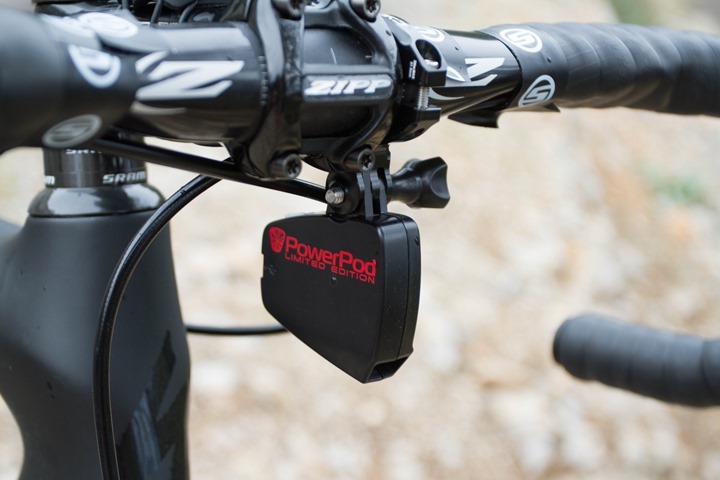
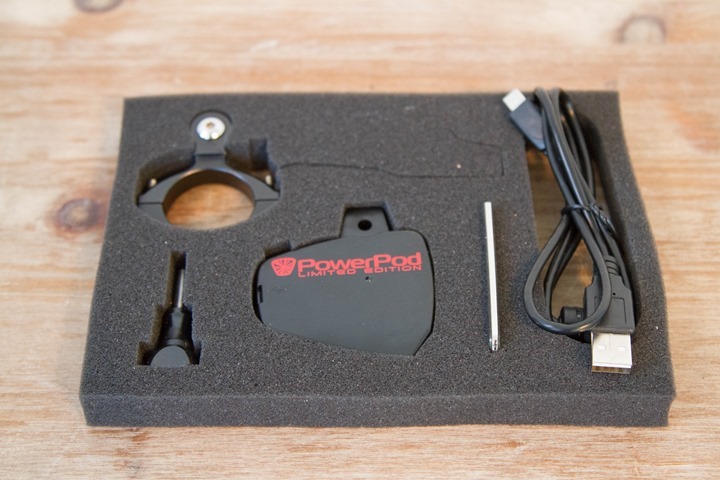
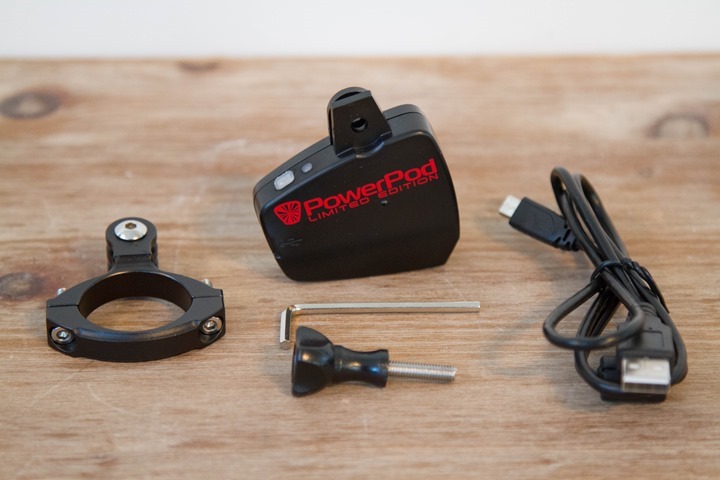
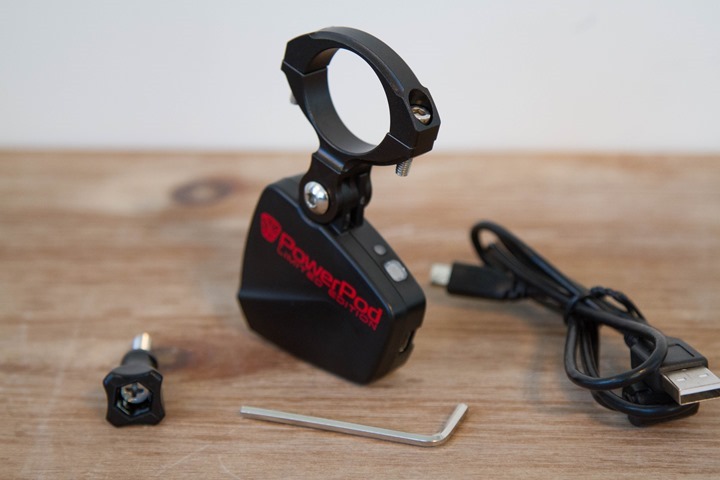
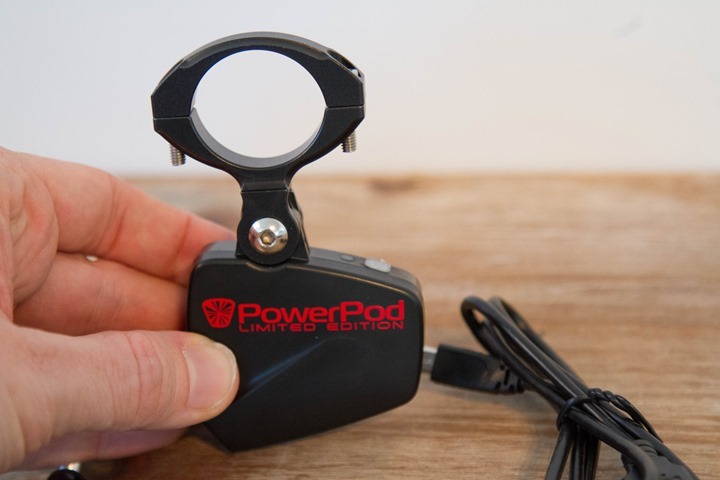
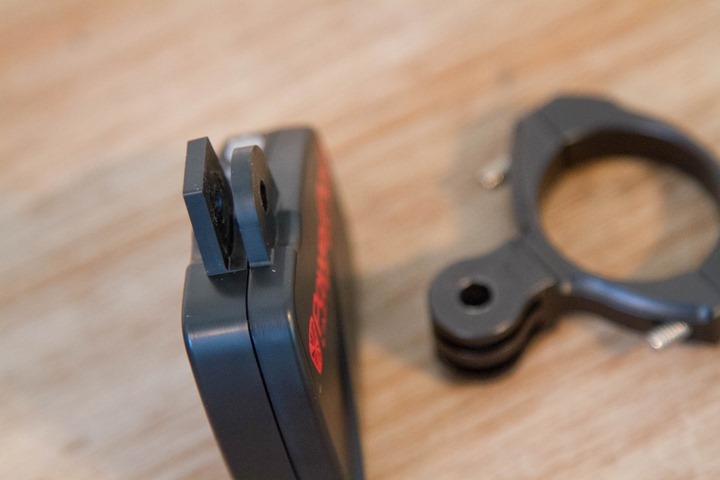
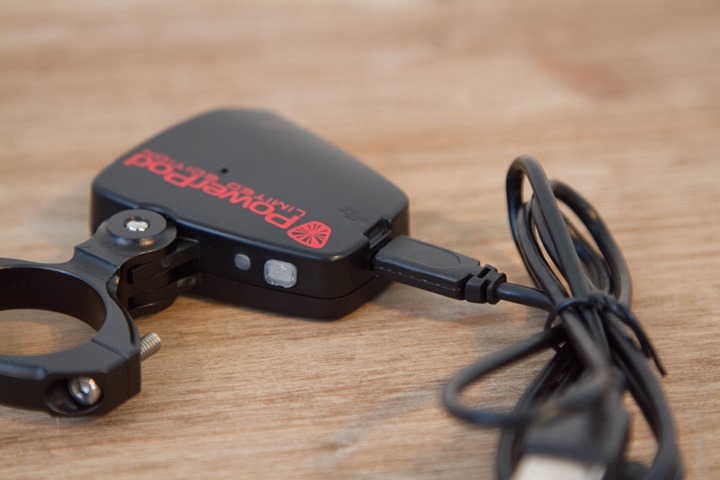
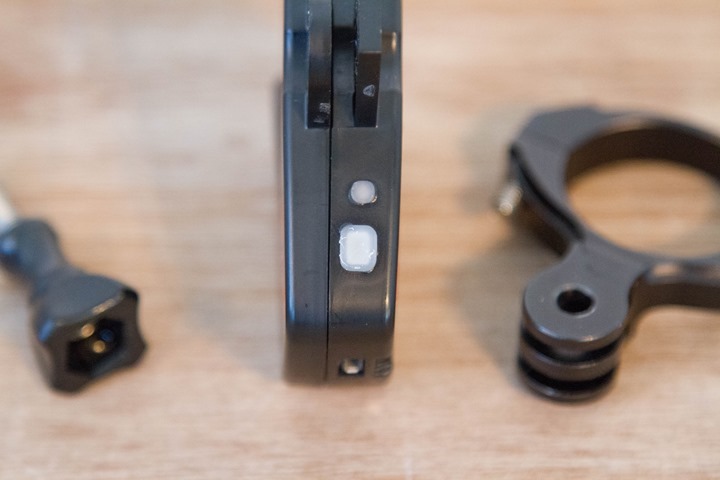
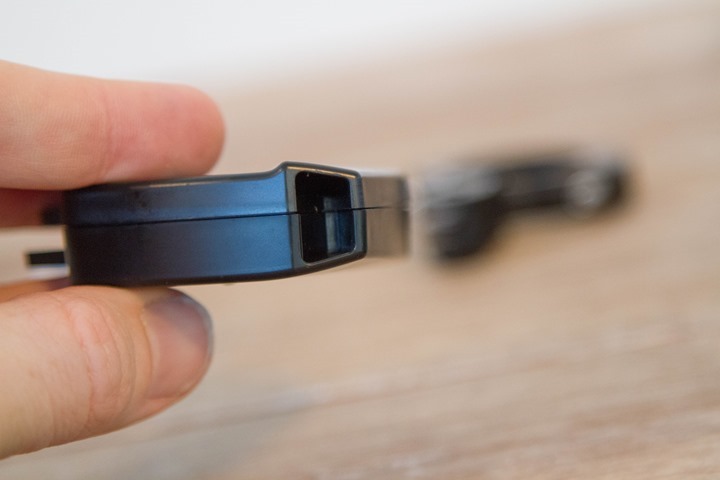
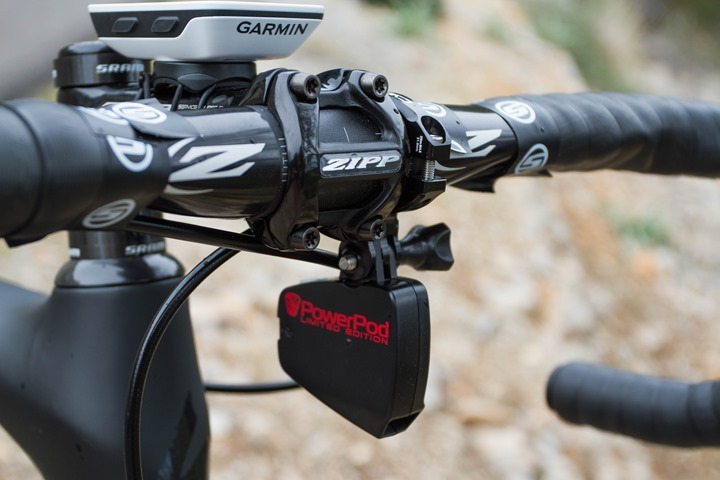
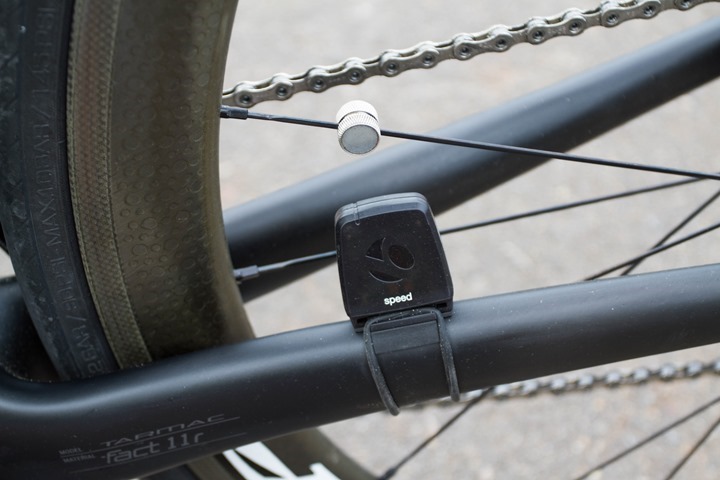
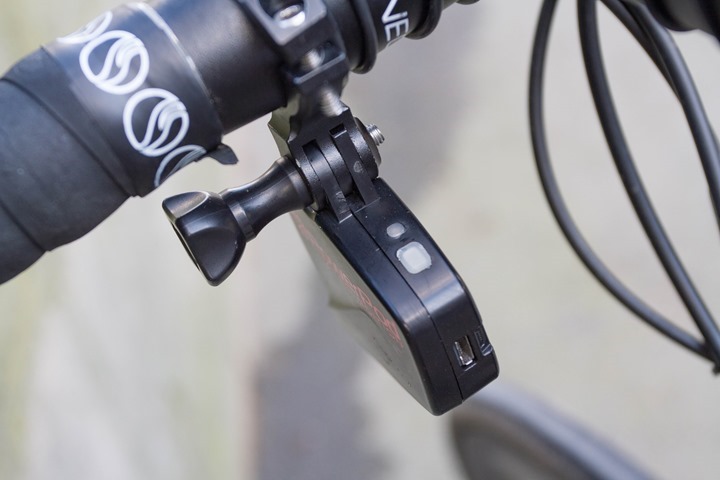
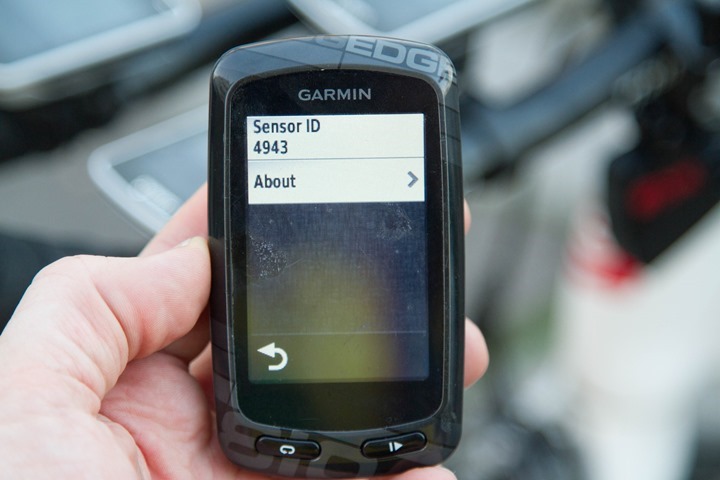
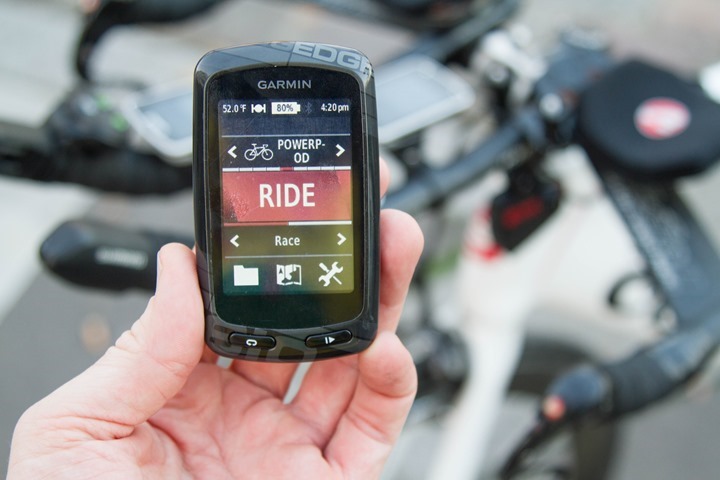
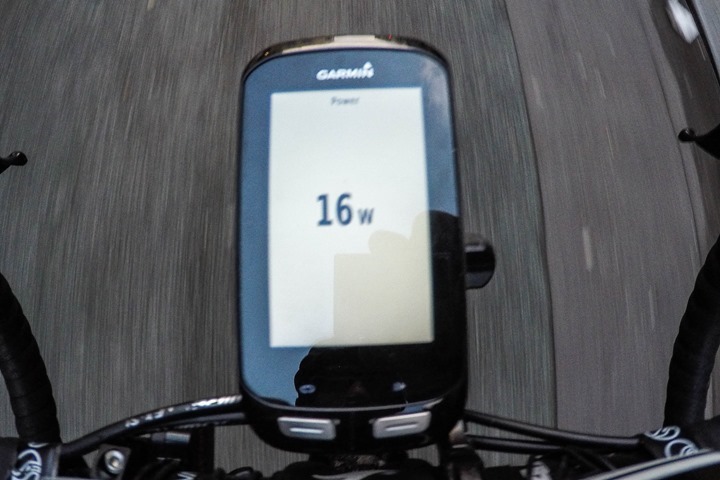
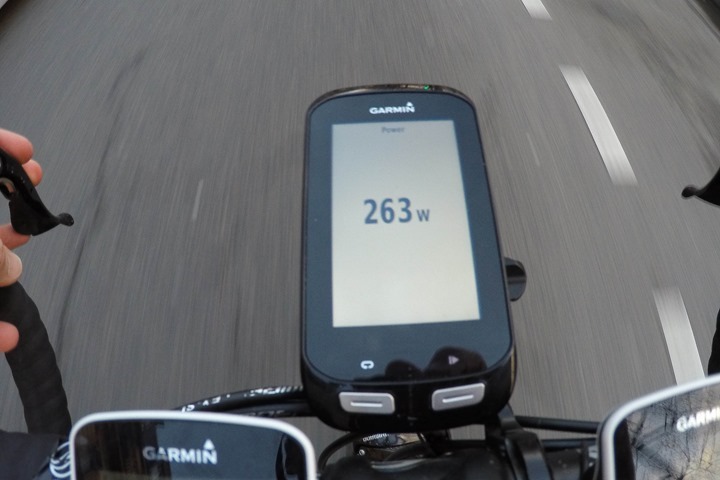
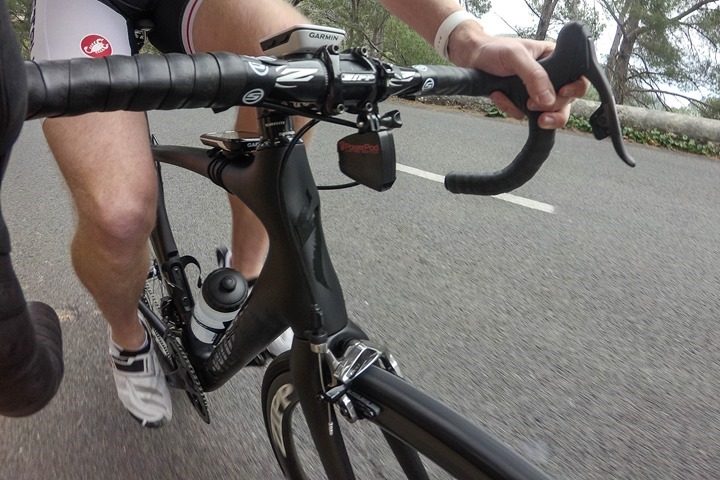
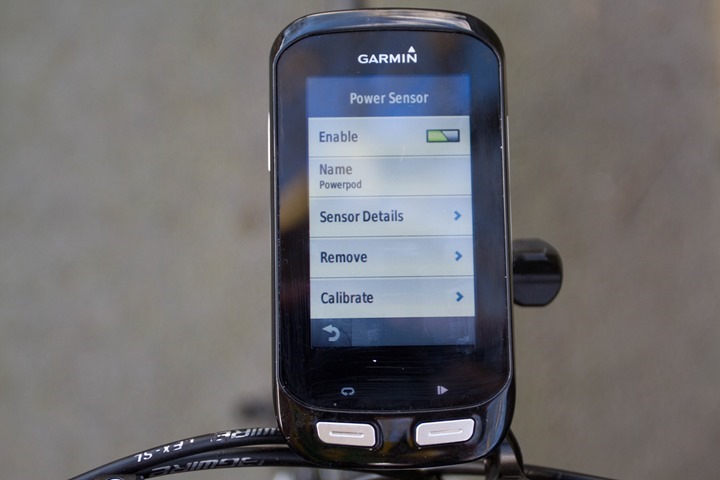
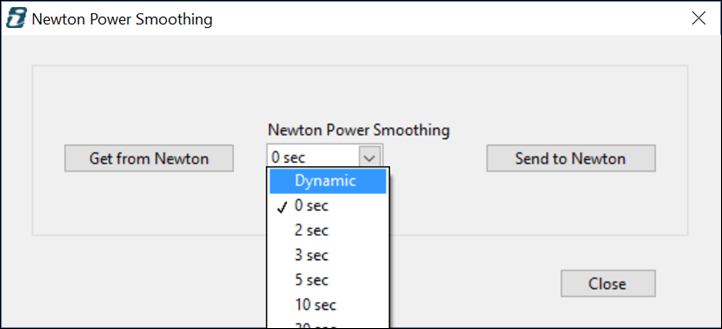
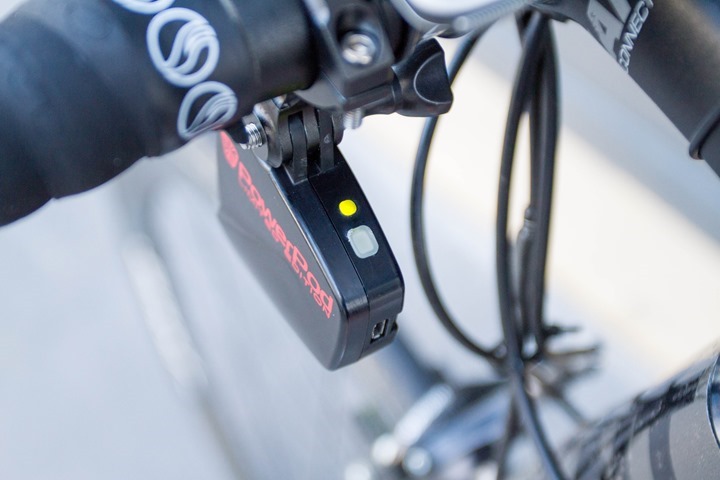
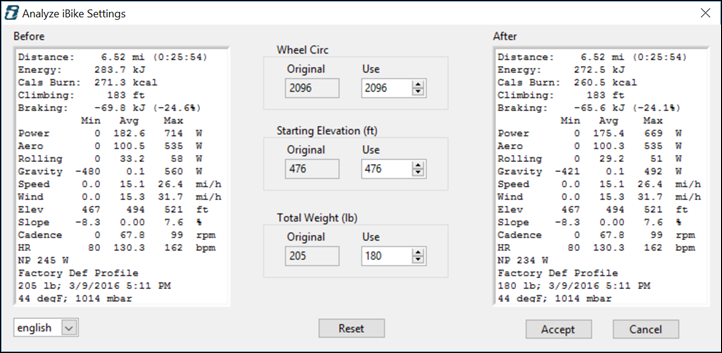
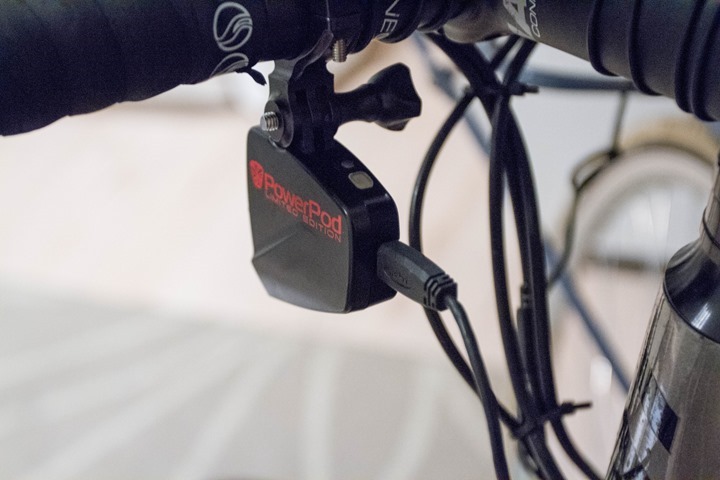
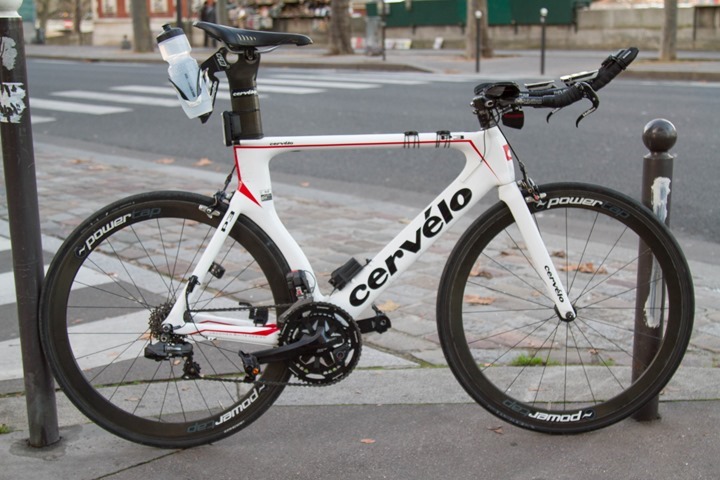
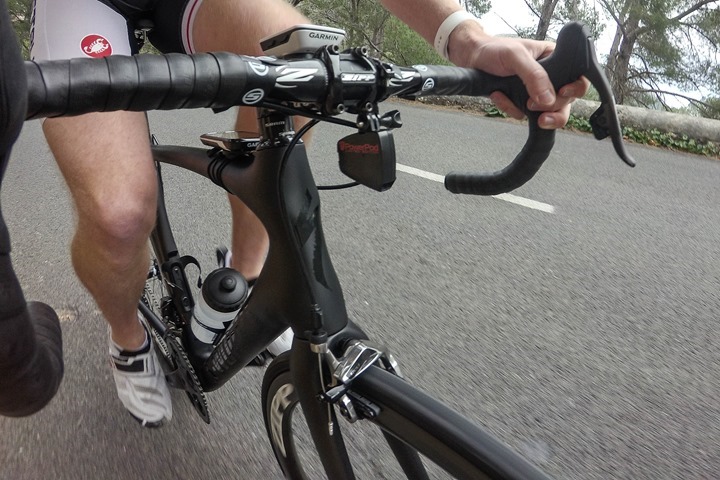
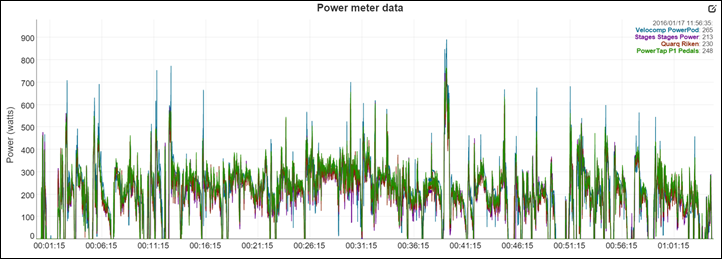
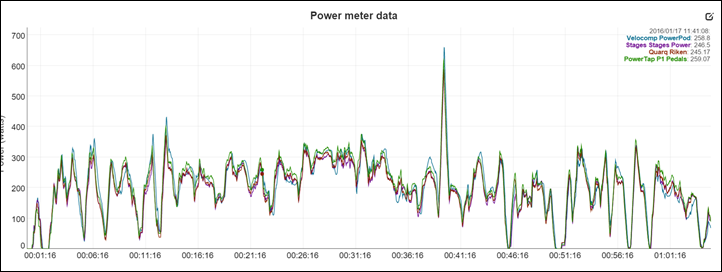
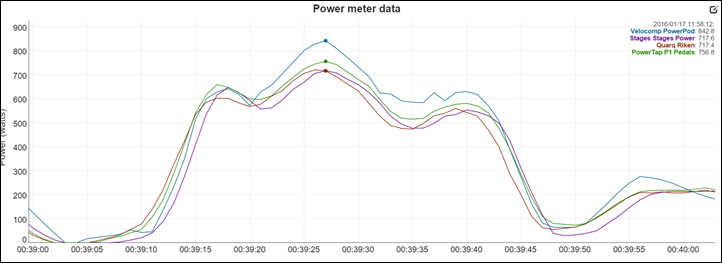
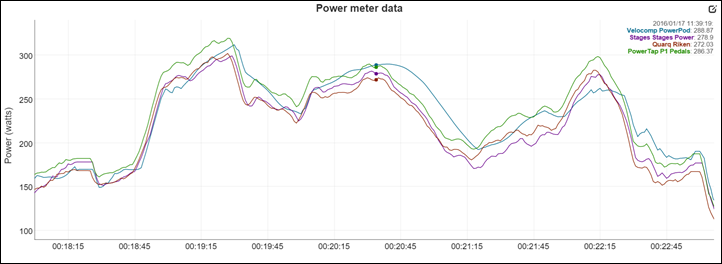
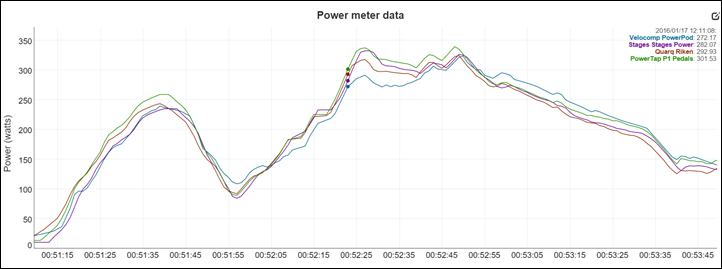
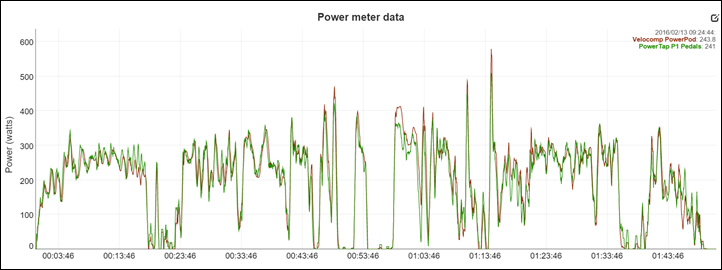
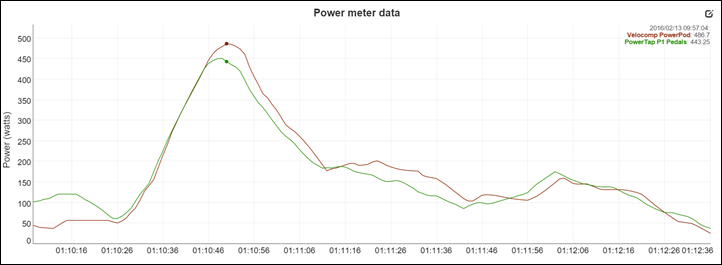
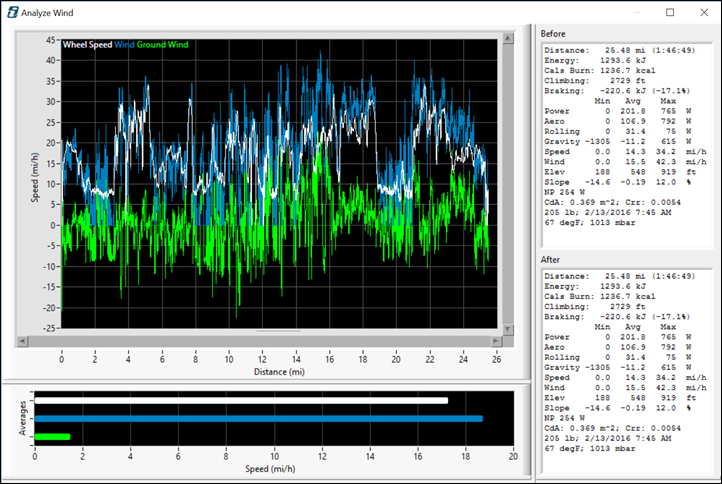
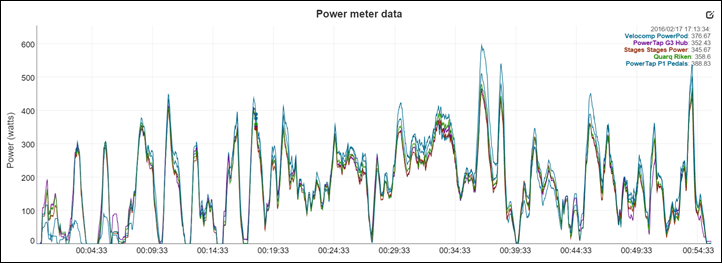
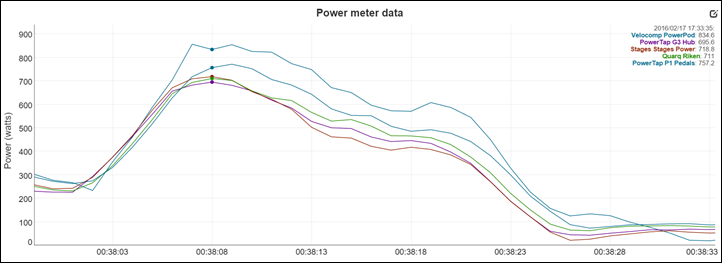
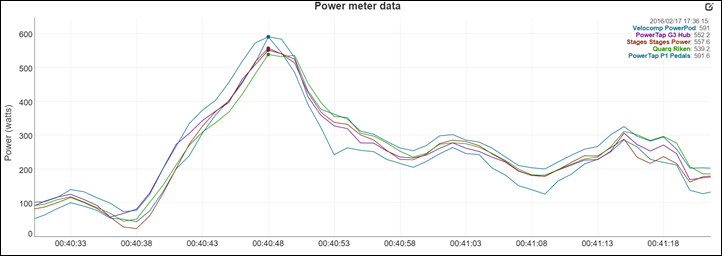
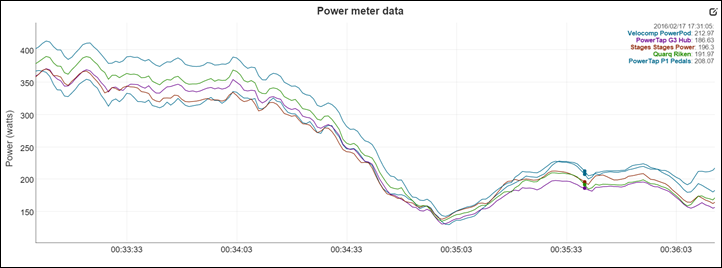
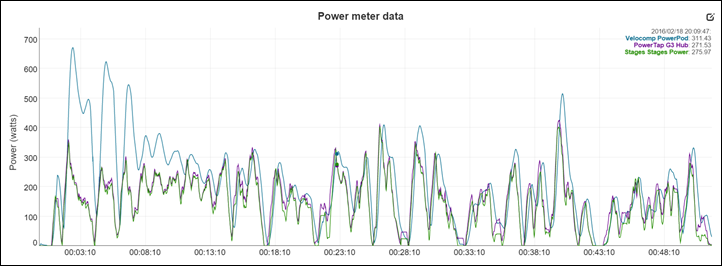
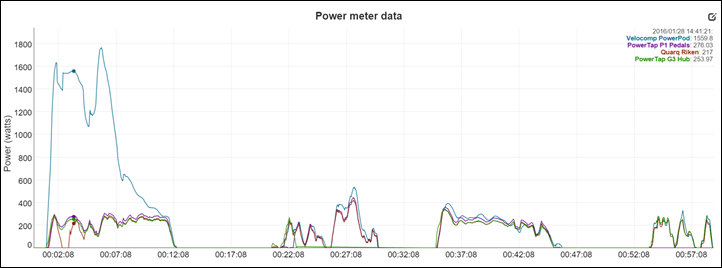
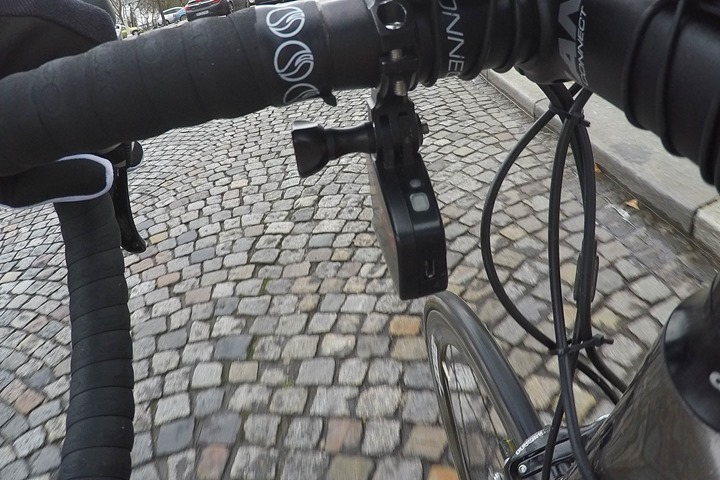
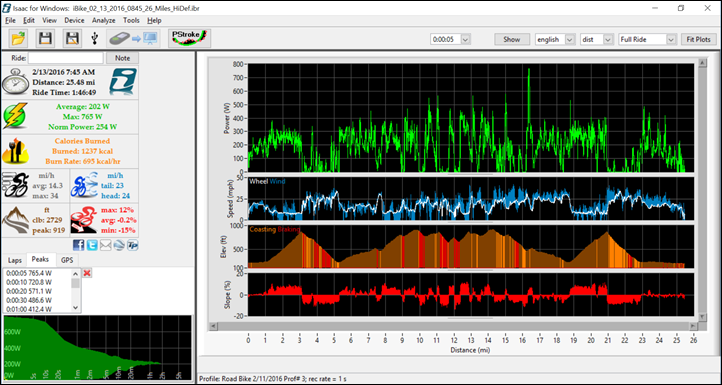
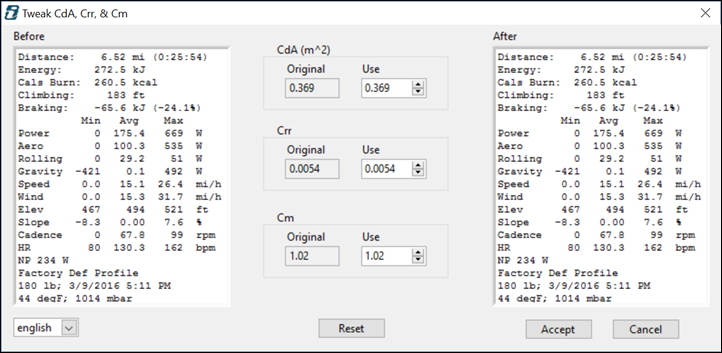
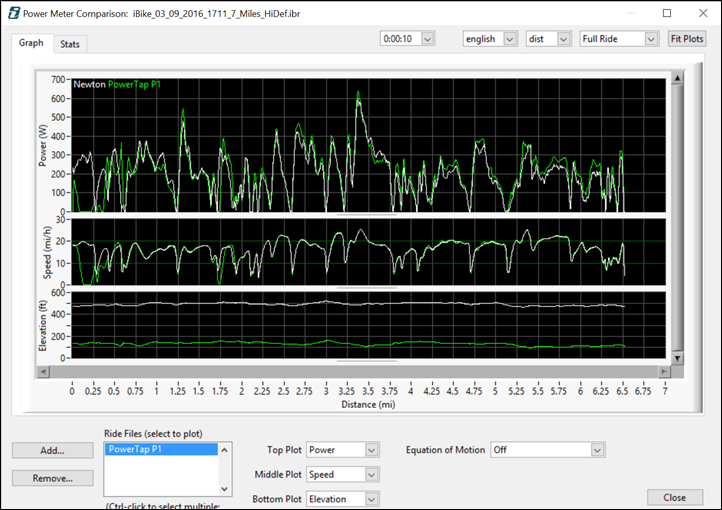
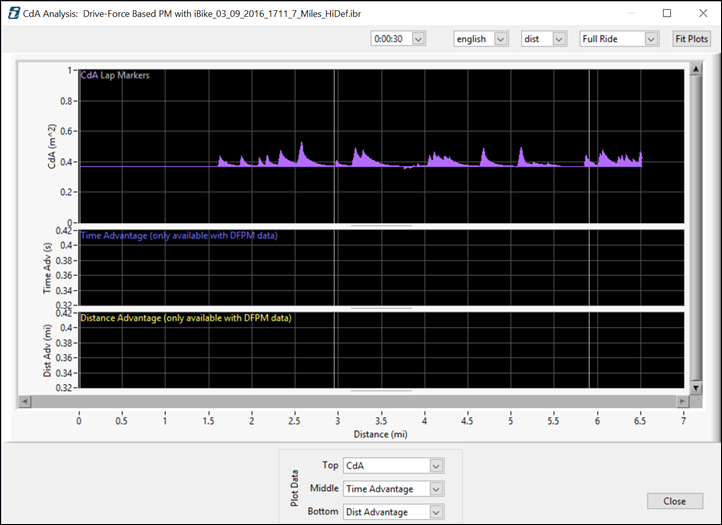

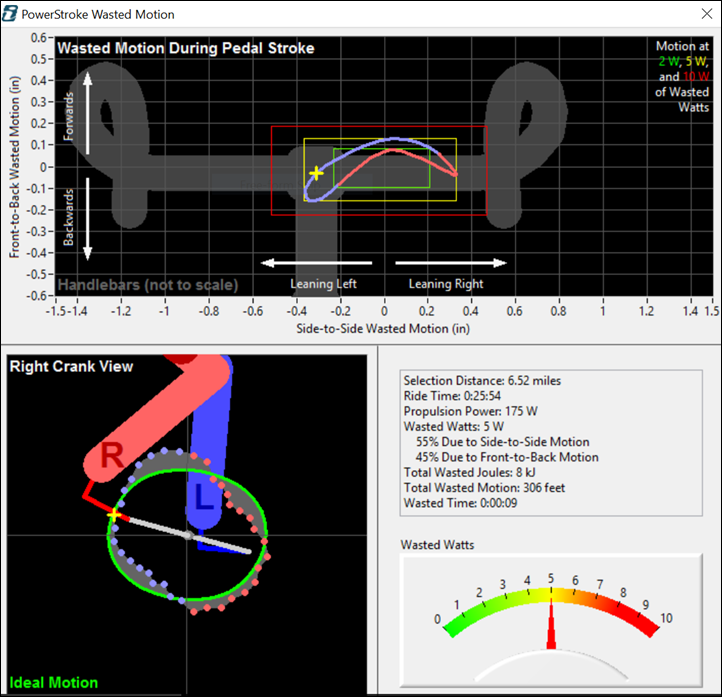
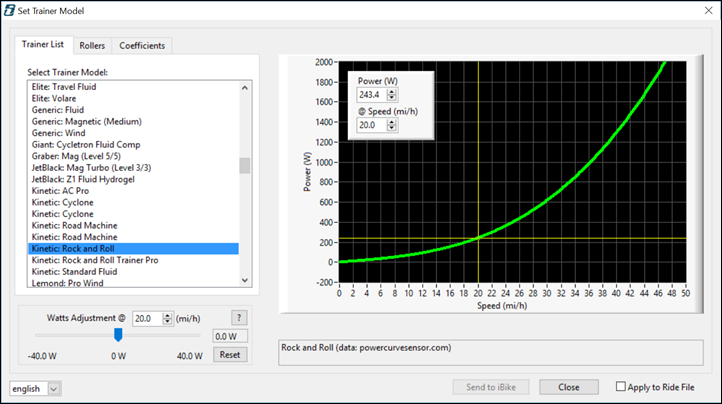
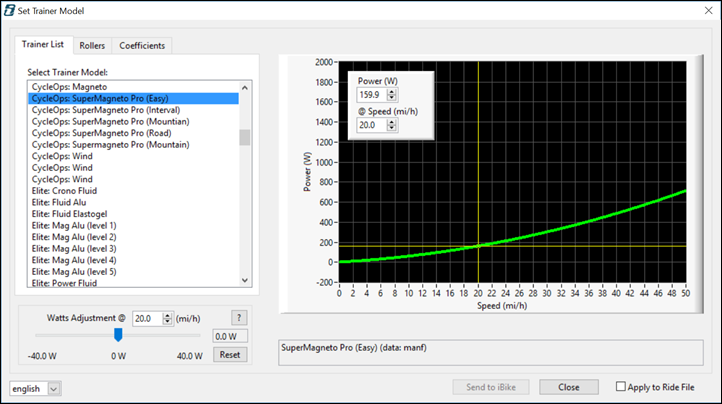
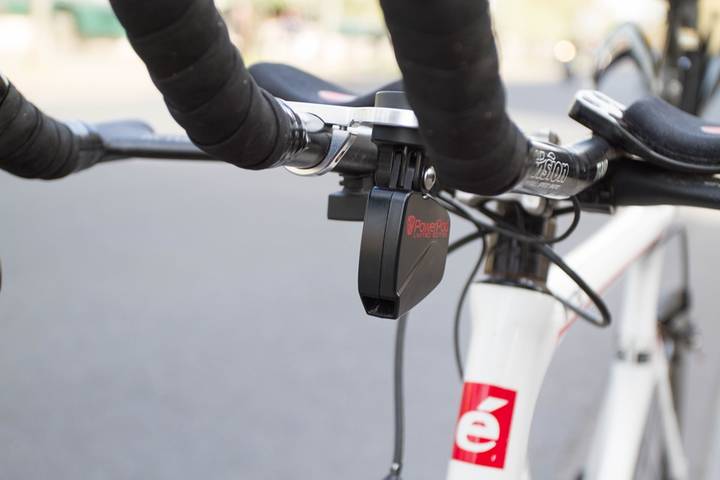
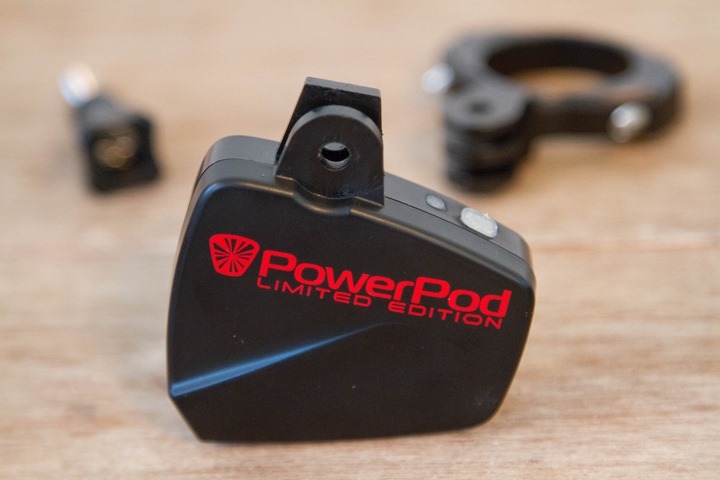





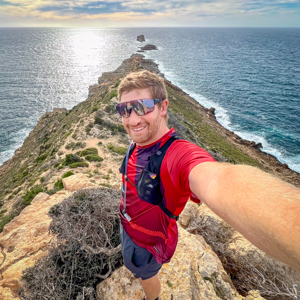





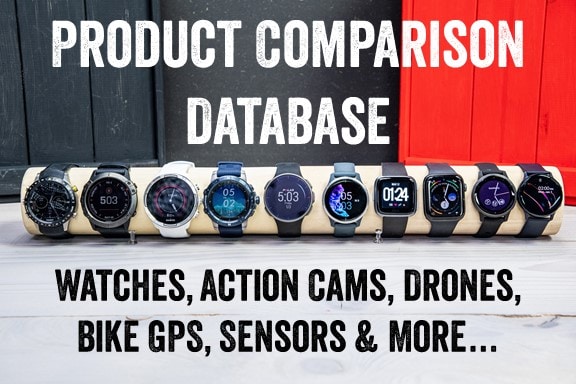
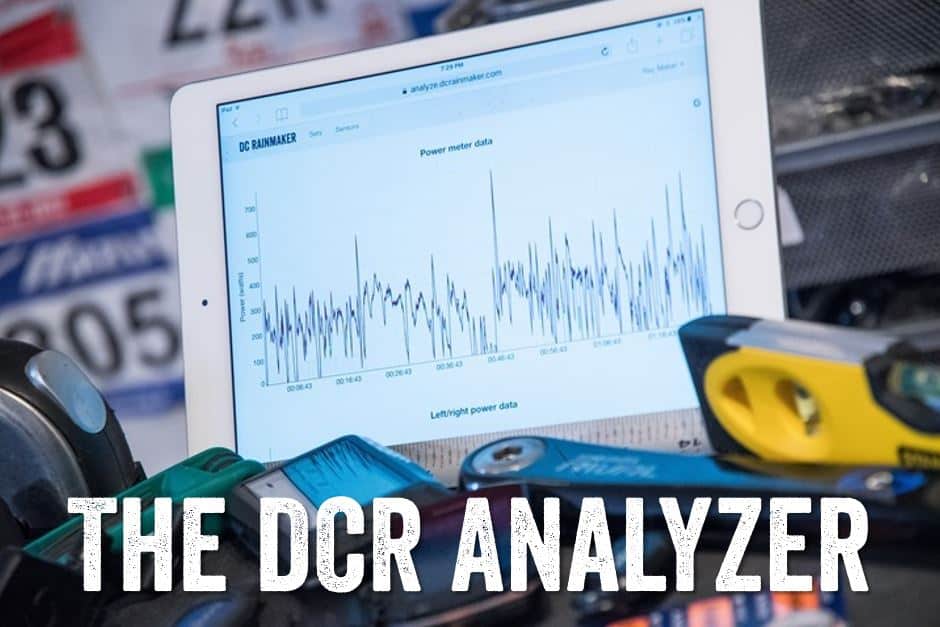

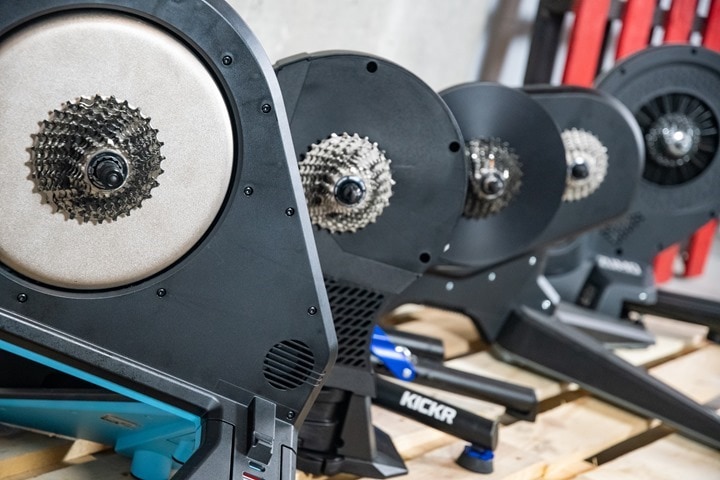
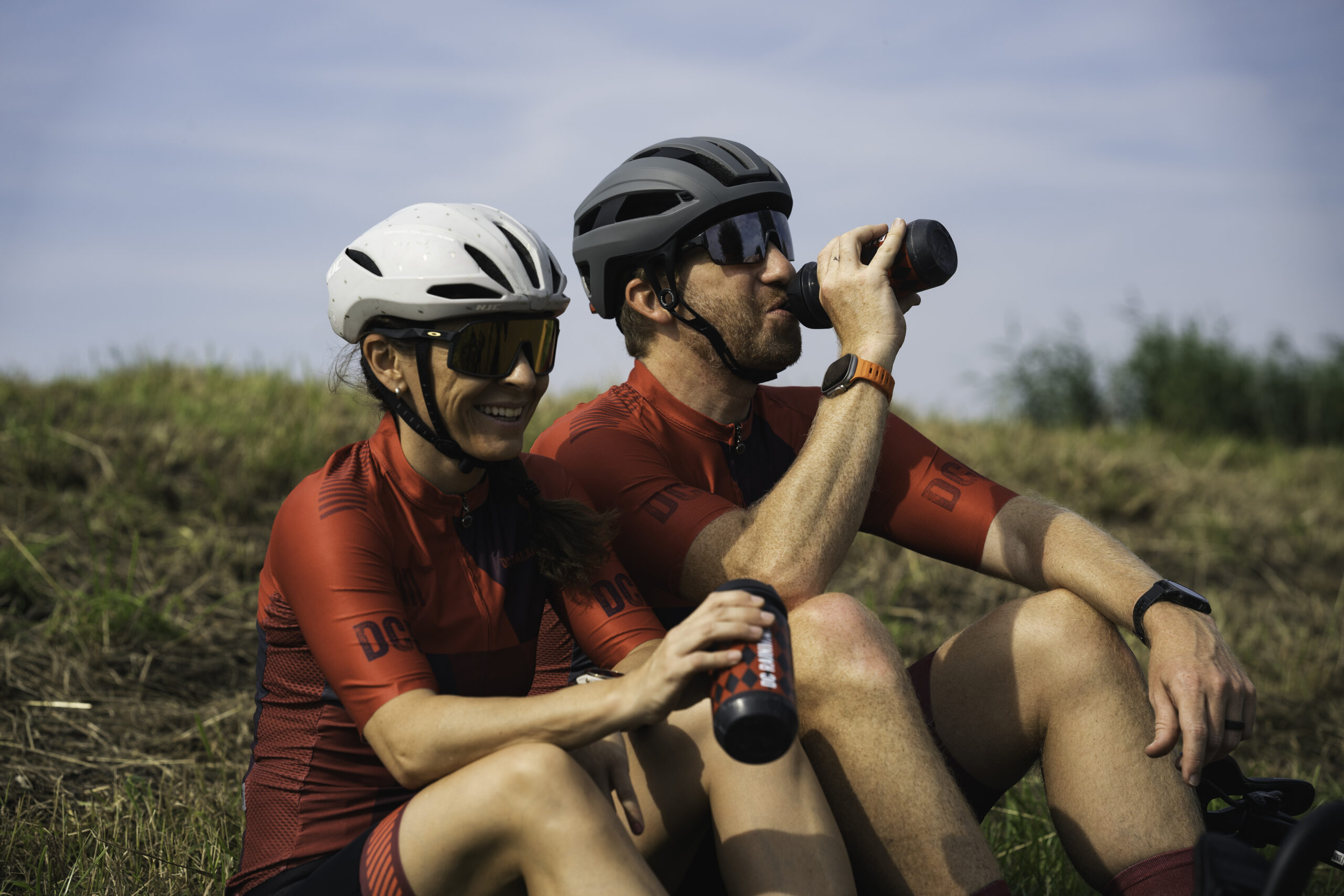
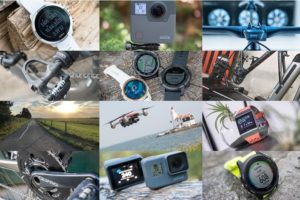
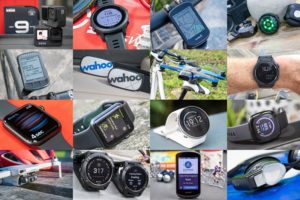

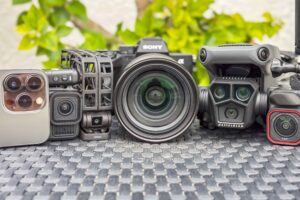

We will begin shipping ANT/BLE PowerPods this week. We are excited by the added capabilities that BLE brings; this opens new opportunities for innovation and we plan to make the most of them.
Hi John,
I bought the PowerPod after reading DC’s review, like all other products! Very excited but unclear about something that you might want to clarify on your website.
I have CATEYE STRADA for speed and cadence, and, the GARMIN 910XT for the rest.
When I called CleverTraining they confirmed that I Could use the PowerPod with both devices, so PowerPod would capture the cadence through the CatEye and then display my power output in watts to the Garmin 910XT.But when I open the box and read the instructions, you are advised to sync with one device not two.
Can you please shed the light? If I can only use one device, what is the cheapest device your recommend that is compatible with PowerPod?
thank you so much.
So far as I’ve been able to determine from a web search, the Strada isn’t ANT+, so it won’t work with the PowerPod. The PowerPod needs an ANT+ speed sensor to function, and will pair with an ANT+ cadence sensor as well. I think that’s true even of the Bluetooth model, which will transmit power using Bluetooth but only pairs with ANT+ sensors. Any ANT+ sensor should work. If you can still find an old Garmin GSC-10, that’s probably the cheapest option. I’ve completely switched over to the Garmin magnetless speed and cadence sensors. Garmin sensors are ANT+ only, so if you want sensors that also transmit Bluetooth, you’ll have to look elsewhere, like Wahoo, but make sure you get a sensor that transmits both ANT+ and Bluetooth and not just Bluetooth.
The PowerPod is a mixed beast. It’s like a head unit in that it pairs with and receives data from sensors, but it also itself functions as a sensor and transmits power to a head unit. So your 910XT will pair with the PowerPod to get power, and can pair with the sensors themselves to get speed and cadence. The Strada won’t be of any use in this regard.
Thank you Paul! I recall now a call I made to Strada a while back and wondering why I couldn’t sync my Cateye with Garmin 910XT…because it’s not ANT+ and using a some other wireless technology. I will look into your proposed solution.
so this one should work:
link to buy.garmin.com
Yes, definitely. I now have three sets of those, one set on each bike. One nice thing about the PowerPod is that you can move it between bikes, and it uses the bike profile associated with the speed sensor that it pairs with. So you don’t have to do anything to tell it which bike you’re using.
Thanks again Paul!! One thing I did not know is if Ant+ technology allowed for multiple simultaneous connections, finding the answer is not that obvious…but found the answer:
“ANT uses adaptive isochronous transmission[10] to allow many ANT devices to communicate concurrently without interference from one another,”
link to fitnesselectronicsblog.com
There may be a limit on how many head units can connect to a sensor, but it’s at least 4 (the maximum number I’ve ever had connected). Today my Edge 1000, PowerPod, and VIRB Elite were all connected to my speed and cadence sensors, and the Edge and the VIRB were both getting power from my PowerPod. I believe Ray routinely uses more head units than 4, although maybe not all connected to the same sensors.
I’ve been using this Bontrager speed / cadence sensor with my PP. It is dual Ant+ and Bluetooth. link to amazon.co.uk
Will it work on a fat bike? It would seem that the widely varying surfaces, grass, rocks, snow, etc. cause significant portions of the power to be devoted to surface friction vs. air resistance.
With our new DCRR firmware, rolling resistance is measured dynamically during the ride. So, if road friction is changing, PowerPod will measure it.
Love this gadget!. Reliable, not complex setup and allow met to use my prefer components like pedals , cranks and wheels and of course at a reasonable price. Also included is isaac a great software. Hard to beat!
Have a ccouple of questions:
Q1: about profiles.
I have two bilkes and two pair of wheels.
I have also two garmin speed sensors one in each wheel so I can have a profile for each bike that is recognized by isaac because of the different wireless ID’s.
Q: if I just want two use only the SAME set of wheels and with the SAME speed sensor in both bikes (instead of the two pair of wheels), can I have two profiles for both bikes like B1 and B2 and choose the corresponding profile in isaac? Of course I would have to Reset/Profile Device to run the setup for each bike.
Is this all correct??
Q2. Edit/Edit Profile: Is the FTP adjusted automatically after a ride or I have to set it up manually after I measured it?
Q3 Under Edit Profiles/Wireless iD’s the cadence sensor is 0/0 not recognized why? I have a garmin speed and cadence sensor (magnetless) I woke both of them and paired with the PP. Of course is recognized by the head unit. Any tips?
-=terry=-
Sorry, we were traveling in Asia and did not have much time to respond to emails etc…
Q1:Yes, you can use the same sensor for two different bikes and have two profiles. Just remember that you’ll need to manually switch profiles using Isaac.
Q2: You will need to manually enter your FTP in the profile information
Q3: Make sure you wake up your sensors. Then, press-hold the button for about 4 seconds, until the green light flashes, indicating that pairing has begun. After successful pairing the light will be solid green. To see IDs, connect PP to Isaac, then use the “Edit/Edit Profiles/Get from Device/Wireless ID” command to see IDs.
indoor/turbo training application not possible?
Does the PowerPod need to be installed with the PowerPod logo horizontal in regards to the ground or is it ok if the word is slanted a bit?
Check above where this is answered by John. You don’t have to have the logo exactly horizontal (I don’t), although you can’t go nuts. What is important is that if you remove it and remount it, it’s in the same position as it was when it first got calibrated. If not, the readings from the first eight minutes on the subsequent rides will be high or low until it recalibrates.
Questions About Check Calibration PP
Q1.
1. I ‘ll do and out and back ride
2. No drafting
3. Wind conditions stable.
To be able to fulfill constrain #3 the shorter the ride the most likely it will occur.
Question: how short the ride can be and still be long enough to be able to be analyze (1 hour?)
It should be better Hills? Rolling?
Q2. Downhill not accurate.
I have not done “Check Calibration” and I just using the profile I setup for this bike.
I found that riding on the flats or climbing numbers looked pretty good. Of course I do not have a strain gauge to compare but I have done many many hours of ergometer training so I am kind of familiar with how leg pressure feels. The problem I found is mainly going downhill when the watts really underperformed the “feeling” pressure (watts may show 80 when they should be 170 or 180 for example. Any tips.
The PowerPod and the Isaac software are really impressive, I just have to learn them.
Q1 #3. Wind conditions generally don’t vary much during a 10 minute ride, so no worries
Q2. Please post a ride file at ibikeforum.com and we will take a look.
Ray – Is there any reason you can think of right away why something like this wouldn’t work with one of those Elliptigo bikes?
We’ve tested our technology with the Elliptigo, and it works just fine!
So you basically set it up such that your body position is “standing up” and I’m assuming everything would be the same as a bike?
Would be curious to see how power metrics (esp FTP) would differ between the Elliptigo and say, my road bike.
On an Elliptigo you are much less aero than on a road bike. Basically, you’ll use Isaac software to set CdA to a higher value, around 0.6.
Velocomp is making a claim on Facebook that most strain-gauge power meters only work in cold weather down to -4c (27f), and that PowerPod is the only power meter on the market that has no minimum temperature constraint. True?
link to facebook.com
I see they’ve updated their post to include battery aspects, which may really be more the limiter than the strain gauge piece. I’ve never really heard of anyone complaining through about their power meter having issues below a given temp. Likely because once you get below a given temp the number of people riding is pretty small.
Hello,
Also asked these questions by e-mail a couple of times but haven’t received an answer until this moment.
I have downloaded Isaac to look at the sample ride. While using, reading and talking about it some questions about the CdA part came to mind:
Q1: If I change position on the bike (e.g. seated vs standing) for 30 seconds or even less, will the CdA change in the file? I ask this question because I have read somewhere that the CdA is static and will not change over time in the file while in real life it actually does.
Q2: A few weeks back some people of Cycling Australia told me that it might be possible to connect a different power meter to the PowerPod to ‘recalculate’ the CdA. Is that possible and if so how does that work?
The reason I am interesting in the PowerPod is that I might want to use it for my PhD within endurance cycling.
Cheers,
Paul
The answers are all in the comments above, but to summarize: Yes, CdA is assumed constant by PowerPod/Isaac. Yes, if you have both a DFPM and a PowerPod, you can measure CdA. It’s been done (check the references given by Osman Isvan in Ray’s “First Look” article on the PowerPod), but I don’t think at the moment there’s any simple way to do it without writing your own software.
Coming soon…
I just wanted to say how much I appreciate your reviews. I’m trying to choose which meter to buy and your objective (and very knowledgeable and well written) reviews have given me all the information I need. All things considered (my needs, accuracy, ability to cost effectively move it from bike to bike), I’ve settled on the Powerpod. Your detailed reviews and explanations made me rethink my initial dismissal of non strain gauge units. I started thinking about it and realized if you can accurately nail down all the inputs (speed, elevation change, air speed, rolling resistance [and noting the approximations for body position]) you can, as your graphs show, very closely approximate the output. At least close enough for my purposes.
Thanks,
Donzo
Hello Ivan for physical reasons I have a very asymmetrical pedaling so I think that the single-sided power meters do not do it for me. THE budget is 600 $ then I would choose the POWERPOD, if properly calibrated can be used as a reliable tool to measure your FTP and make reliable workouts with the power? perhaps combining it with a Garmin Edge 820 (which I have)?
with a $ 600 budget and an obvious problem of asymmetric pedaling what other solution would you suggest to me over the POWERPOD?
If you have asymmetrical pedaling then I would recommend PowerPod with the additional PowerStroke feature. PowerStroke adds pedal analysis, including angular presentation left/right pedal acceleration (power) as you turn the crank. This bundle is on sale right now for $325 at powerpodsports.com
Ok thanks for the reply, then by A Very asymmetrical pedaling the POWERPOD Estimate and More Reliable Of the steps of measuring … in this case estimate beats measurement? I understand that the POWERPOD And a good compromise for Having a power meter can be used to train without having to spend one out of turn … right?
For anyone out there on the fence about the PowerPod I’d say go for it. I have been using it for over six months and I am quite happy with it. Also the support is second to none, every email is responded to within a day, how great is that. Plus with the money I saved and the fact that I ride Campy it allows me to afford other stuff.
David, I fully agree with your comments. John is great and he is a major help to uncover the hiding features of this great gadget. And it is not only the PowerPod but the software that comes with it. Isaac is well though and designed and it is free.
I have Garmin edge 510 and integrates very well with the PowerPod.
I found that the book from Allen and Coggan “Training and racing with a Power Meter” is a good complement of the PowerPod.
Hi Ray.
first time poster, long time reader, well done on the non biased informative reviews you do.
Question. I need a new power meter having spend the last 18 months on a power tap hub. I race regularly in all forms of road racing and have two sets of race wheels for each road / TT bike and i want to ensure that i get the best option that allows changing of wheels and consistency in FTP across these spectrums (i only had power tap on training rim, not race wheels). The two options i am looking at are, power pod for $380 NZD delivered or a 4iiii 105 left only for $511 NZD delivered. In your opinion (and other readers that have both DFPM and PP), am i best to go for the crank based option or is the scope of riding within the “limitations” that power pod has? I like the price of PP and John’s exceptional response times and enthusiasm, however my gut tells me that a DFPM will be a more reliable option.
thanks
Ray has commented in most power meter reviews that every measurement device has limitations. One-leg power meters have an intrinsic measurement limitation. PowerPod makes assumptions, too, but I note that a primary limitation PowerPod Ray described in his in-depth review (cobblestones) has since been addressed with a firmware update.
Perhaps a different way of thinking is this: what benefits are you looking for from your PM? You have two bikes and two sets of wheels; you’re a racer. If you want to have power on both bikes, which option makes this easiest? As a racer, do you think you’d benefit from the additional insights PowerPod can provide (drafting, CdA, wind speed, PowerStroke, etc)? And of course, how happy would you be to have an extra $131NZ in your pocket?
If you decide to go for PowerPod please email me after you’ve gotten it installed and I will personally make sure it is working at its best on both your bikes.
Hi John,
thanks for the reply. regarding my FTP, will it be exactly the same across both bikes? i.e. will my 20 min power done on a powerpod on my road bike be the same on the TT bike? I spend a majority of my training time on the road bike, when i do a TT id hate to “blow up” because the power numbers were wrong.
cheers
Ian
If you set up a “profile” for your TT bike and also your road bike, and use an out-and-back calibration for each profile, you’ll get consistent and accurate results for both bikes.
Hi John.
I’ve purchased a powerpod. Plus both mounts for both the road and TT bike. I look forward to trying it out and setting it up. Any tips for the perfect setup?
Cheers Ian
Hi John. i have ordered my powerpod from Pro Bike Kit, will i need to do the upgrade with the dynamic rolling resistance?
Ian
Hi John: similar comment as others on Power Pod connection problems. Got mine thru the kickstarter campaign. Moved it to my indoor trainer this January after two months of it not being used and no charge; No lights; no reset; no connection; no Isaac. Sent an email to tech support three weeks ago. Got a response that my question was received: no response yet.
Hi John
Damn 2016. Started with Bowie, many in between, and then ended on Carrie Fisher. And now it kinda looks like my PowerPod has bought up and died too.
Problems started on Boxing Day. I was foolishly getting in some Rapha Festive 500 kms in possibly the worst Scottish weather I’ve ever cycled in. Icy sleet, driving rain, howling winds. You get the picture.
Anyway, it was all I could do to get into double digit mph such was the wind, but I was getting readings of around 150 W. My FTP is 301 W and I sure as hell felt like I was working harder than 150 W, but I put it down to the PP not working well in blustery conditions. Any views on that, by the way?
Next day it wouldn’t kick into life as I set off on my club ride. No green light. No lights at all.
I figured it was just out of juice, so charged it after my ride but the same happened the next morning – nothing.
I figured the portable battery I’d used was flat, so charged that, and then charged the PP, but to no avail this morning when I set off in abject lactic misery to complete the Festive 500 (which I did, by the way, but I genuinely thought I was going to cry at one point).
After returning and consuming enough food and hot tea to keep a normal person going for three days, I took the PP off the bike and plugged it into my PC. Isaac won’t recognise it one bit – won’t connect, won’t download ride files, etc – though there are some signs of life, namely a permanent solid red LED. Is this a red light of death?
Purchased on Clever Training Europe in July 2016. Any advice on what to try next? And if that doesn’t work, do I deal with CTE for warranty replacement or you directly?
Stephen
Please email technicalsupport@velocomp.com and Tom will help you quickly!
Hi John, I did get in touch with Tom, but actually it was more sensible for me to go via the retailer as I was still inside 6 months of buying in UK. I’ve now got a warranty replacement en route to me from Clever Training Europe. Expected to arrive tomorrow.
So, a question from me. Can I copy the profiles from the old unit onto the new one, and if so how? Will this save me from doing a calibration ride, or do I need to do that regardless?
Thanks!
Has anyone used this for track? I am a sprinter so longest effort one min shortest 5 seconds. What are your thoughts?
Well, it was a very short love affair between me and PowerPod. Almost an unconsumed marriage! :) The first unit received had a faulty micro-usb socket It was sent back for replacement because I still like the PowerPod and I would like to give it another chance. :)
Has anyone run into the same problem?
This has been an infrequent issue and I’m sorry it happened to you. Your unit will be turned-around the same day we receive it. We are working with our suppliers to eliminate this problem permanently.
It seems that I have the same problem. Got a unit for my wife, but it doesn’t want to charge :(
Please email technicalsupport@velocomp.com for next steps
The item was sent back to the European seller (ProBikeKit UK) and now I’m expecting a new one.
What is the warranty period? After the warranty expires, if I will have the same issue, could be sent for service?
That’s great you are getting a replacement unit. In EU and UK warranty is 2 years from date of purchase. Yes, we repair older units in the USA…
Unfortunately it has happened twice to me. First time it was sent back and returned repaired. I’ve just sent it back a second time.
I use the Garmin accelerometer for speed and the separate cadence meter. Any issues with this combination and PowerPod?
Did use this combo without any problems.
If you stop long enough that PowerPod goes to sleep ensure speed and cadence sensor are awake before PowerPod.
Does the Powerpod come supplied with a cover to protect the usb socket when riding in the typically diabolical weather that we get in the UK at this (and most other) times of the year? If not, anyone to a 3D model file for a printer to make one? I really don’t fancy leaving this type of connector exposed to all the water, salt, road grime and goodness know what else gets kicked up from the roads.
Hi! You can buy from e-bay a micro-usb cover like this (see the links bellow) but, to be honest, I don’t recommend using it. Probably will fit but try not to apply much force, it could damage the socket or the circuit board. Instead, a small piece of duct tape or similar could cover very well the hole and is harmless and seal better.
Link 1: link to ebay.com
Link 2: link to ebay.com
Great suggestion. Keep it simple. Thanks.
I’ve done about a dozen rides on this so far, and I’m really happy with my purchase. I was looking for something simple and cost effective, without the need to get anything glued onto a crank arm and all that.If you’re looking for a way into power meters, this is your product – it’s really helping with my training.
I do have some tips:
1. Make sure that the PowerPod is nowhere near any cables. Not even ‘just next to’ – get it well away. Otherwise your readings will be really sketchy.
2. Get a magnetless speed sensor. The basic Garmin speed sensors from days of yore aren’t accurate enough and you’ll run the risk of getting drop-outs. The PP relies on a decent speed sensor.
3. Get a cadence sensor. This will really, really improve the wattage monitoring when you’re going downhill and giving it beans. Trust me on this.
4. Be patient during the first 8mins of riding, especially if you’ve moved the sensor. It’ll need to recalibrate if that has happened. But, it does it very easily and the UI works great on a Garmin.
5. Use the iBike software to give the unit a little more detail – your weight etc. This’ll make things more accurate.
6. If you’ve got any issues, visit the iBike forum – it’s brilliant. You can upload your ride files and get them checked over by the PowerPod gurus. Better yet, email the team – they respond very quickly.
I purchased my PP last summer and enjoyed using it on my rides. This winter I’m on my Trainer and (after attempting to go through all of the questions) find myself wondering if I can use it for rides on the Trainer? I’m sorry for asking this question again if it’s already has been answered.
Yes, you can use it. As a brief description, connect your PP to Isaac software, choose the hometrainer (or roller) from the list and send it to your PP. After that, activate your Indoor mode.
In this review, at the bottom of the Advanced Software Feat. (link to dcrainmaker.com) is partially described.
Also, for detailed settings and other tips&tricks, download the Isaac software manual: link to powerpodsports.com
Can you tell me if a powercal heart rate strap will work with SRM PC8
If it’s the ANT+ version, it’ll technically work.
That said…is that really your setup?
Hi Ray, great review as usual. I have been wanting a power meter for my single and tandem. I see a weight parameter setting field but I didnt see any mention of min or max bike+rider weight. Can I expect it to work, and with similar accuracy, with a tandem+team weight pushing 450 lbs?
The physics is exactly the same, so it’ll work barring any programming weirdness. You’d be getting, of course, the total power applied by the captain and stoker together. If they did something like store the weight in a char (8 bits), so that the maximum allowed value would be 255 (probably kg), then it might not work for you. These days I doubt anyone coding software would do that.
I’m planning to buy the Powerpod with ANT/Bluetooth+Powerstroke Unlock package for $399 (before 10% DC Rainmaker discount) on CleverTraining. My speed sensor is a wired unit, so I’ll need to replace that. I also will need to add a cadence sensor that can talk to the Powerpod, since I current get my cadence data from a Wahoo heart rate monitor. Three questions:
1. Can you recommend a bluetooth speed sensor that will work with the Powerpod for a reasonable price?
2. Can you recommend a bluetooth cadence sensor that will work with the Powered for a reasonable price? I ride a Scott Solace with the rear brake mounted below the chain stays (just aft of the bottom bracket), so that will limit my cadence sensor options.
3. Does the Powerpod work well with the iBike app, making it possible to use my iPhone as the head unit for real-time display?
Thanks!
Just a word of thanks to say that my first faulty USB Powerpod was sent back from the UK to Florida, turned around quickly and is back on my fixed road bike. Thanks Jon, that is great service.
Of course in the meantime I’d logged several 1000 km with my second unit and it has behaved flawlessly. I run them both off the same magnetless Garmin speed sensor at the moment, as this is very fast to swap, and neither unit has ever talked to my built in Giant speed/cadence sensor, and I can’t ride two bikes at once! I don’t bother with cadence, as I am happy with the readings without.
I’m interested in the Power Pod but am less keen on having to add a speed sensor. Could the Power Pod take the speed directly from the Garmin 820 it would be paired with? I’m not really interested in post ride analysis, more for when on long rides with long hills etc – really just to keep an eye on averages over minutes to hours – & not really about short bursts.
Many thanks for your thorough reviews.
Kid regards
J
No, the 820 does not broadcast speed. You need a speed sensor.
Thanks
Kevin
Hi John
Very pleased with the powerpod performance so far,but have run into a problem as the powepod will not charge up or connect with my computer.
I first noticed the problem a few weeks ago and suspect that the usb port is faulty.
This happened to me as well with the first unit. They shipped another unit and I’ve not had that problem again.
Well if first impressions are important, PowerPod bites the dust. Bought product thru Clever Training and PP arrived today. Excitement has turned sour. PP won’t connect to PC! Software downloaded, USB plugged in and red light is blinking for charging but no connection thru Win 10. Nada, nothing. Installed recommended drivers, changed USB ports and cables and still nada. PC will not see the PP. All my other devices connect without a problem, but not PP. Email to tech support and waiting on next step. Hard reset twice with no luck. Forum search no luck.
Not a good first impression. Not my first rodeo either. I am not a novice with a computer. We will see as I will post my results here in dealing with this problem. Hopefully it is fixable.
Have you tried a different computer by chance? Just in case it’s something driver related?
Also – when you plugged it in, I assume you’ve opened up the Issac software first?
Good News! Up and running…well at least I got my computer and Isaac software to actually see the PP.
Took your advice and started the Isaac software first. Got to the home page so to speak and then plugged in the PP. The USB icon turned green and I am now setting up my profile i.e. weight, height etc. Have downloaded “my profile” to the PP and it appears to be working.
Now for the real test. Will set out on a calibration ride and see what happens. That is if the snow does not hit.
Anyway, thanks for the tip. This should be in the literature. You know, when opening any device package where charging needs to occur, one plugs the device in and starts to charge it. THEN while charging, they read the manual(s). In this case it appears one should hold off charging until they have the Isaac software loaded and updated. THEN plug the PP in.
I won’t mince words here, I have written several hundred technical instructions as well as parts manuals and this one is poor to say the least.
I will give a heads up on my progress. Thanks again for the help since I have not heard verbally or written from Velocomp.
Agreed with John G. Documentation is super light. Good documentation prevents from unnecessary returns which are costly to the manufacturer, compared to good documentation and resources online.
The PowerPod may or may not be a useful device but unfortunately I haven’t had the opportunity to test it. Like many I have a faulty unit which despite troubleshooting fails to charge, connect to a computer or hard reset.
For a company that seems to pride itself on customer service and in my dealings does a great job at communication it’s disappointing that despite knowing that there can be problems with the USB solder joint or the internal battery that they continuing shipping units.
A short scroll through the comments section here or their own forum would indicate it’s not a isolated problem with some people reporting multiple failures.
For a low cost power meter solution It’s difficult to recommend a product that will cost a substantial portion of it’s value to return with no guarantee that the replacement will be any better.
And in these several hundreds of technical instructions and manuals you have not created one where the software must be running before plug in the device?
I am neither a novice but this is something I for sure would have tried out.
To be honest, this is the first product I have ever used which required a sequence of operation like this one. No saying it is impossible, but as I said, usually, most people would plug a device in to get the battery at full charge before initializing the software.
Secondly, although this is odd I can and could live with it better if Velocomp had put that in their documentation. I did not see it in their troubleshooting tips. Maybe I missed it but I did not see the recommendation.
Lastly, no one is perfect and I am far from it. The point in all of this is to make a better product. If this is indeed the proper method then the installation instructions should indicate this. Looking at the Velocomp message board there are others that have had the same problem. I tried the recommendations listed there with no luck. I posted here in hopes that someone might have an answer which I got and worked.
I think that I have read this review 3 times and scrolled through the comments atleast twice. I really like the idea of the Powerpod and I am considering purchasing it. In September I am doing my first Ironman and a power meter will make the day more efficient if I train with one. I’m torn between this or spending the extra hundred for the left only 4iii. I know they both have their limitations, but there seems to be quite a few comments on riding aero and accuracy. Maybe I’m not reading it right. At the end of the day I just want to cross Ironman off my bucket list, and I’m looking for something consistent to help me get the job done.
Definitely go with the 4iiii. Better yet would be to get a crank-based PM that captures the total power, but I understand you’re looking at about twice the expenditure of a PowerPod.
At least with 4iii you’ll have a chance to upgrade the system to measures both legs a later stage.
I think with this particular response, it is more than fair that I counter this. Mr Nofish appears to have very strong opinion, but he has yet to prove it (we know data shows otherwise). I wanted to point that out so that you can make your own choices without doubting this.
General message to the group or the chaps at Powerpod…
Am a generally happy user…this is a low cost way to get power data and generally I feel it is pretty accurate. For a number of different reasons I had a couple of weeks off the bike recently, and I ended up having to remove the mount and now that I’ve re-installed it, I’m not 100% confident that my power is correct.
Given that I’ve tried to get the mount back on the bike in the same place – I’ve basically eyeballed it, so it WILL be in a different location. The powerpod itself still connects seamlessly to the head unit, but do I need to do any re-calibration to make sure it knows it a slightly different level to before, so will it work that out itself??
AND if I do need to recalibrate, how do I go about doing that – just hold the button down?
Thanks in advance for both patience and assistance!!
JON
Before doing anything, I’d just go out and try it the way it is. The PowerPod always uses the first 8 minutes of every ride to recalibrate anyway, so if your numbers look reasonable during those 8 minutes, there’s nothing more that needs to be done, since the remainder should be accurate. If they don’t, then you have to use Isaac to tell the PowerPod to force an actual initial 0-100 recalibration for that profile (it’s been so long, I’ve forgotten the exact steps, but it isn’t hard to do.) Holding the button down won’t do it.
I’ve found the easiest way to replace the PP is to tighten it back, rotate forward and pair. Then set off. To avoid spurious calibration numbers, I disable the PP on my Garmin for at least 10 minutes or so through the sensor settings. Then enable and hey presto! Normal readings are back again. I swap the PP between two equivalent road bikes and swap the speed sensor too, so the profile is unchanged, just the tilt correction.
JohnG, the initial set up is nicely covered in a hand-out. To get to working readings with a default profile, following these works. Of course to adapt for rider weight, mounting position, tyres and body position needs Newton, but out of the box, the unit works just fine.
Daren,
Did you read my observations? I have no problem with the overall setup. My initial point was that I could have done a calibration ride but it would not have done me a bit of good seeing that my PC would not recognize the PP when attached thru a USB port. If my PC cannot see the device then I cannot extract the data from the device.
The Isaac software loaded fine but my problem was getting the PP to sync with my PC.
That issue has been resolved. Now it is on to the calibration ride and then the extraction of the data to Isaac, Strava and Garmin Express. I will see how that goes. Hopefully the hardware works and uploads the data as promised. Others don’t seem to have major problems and I don’t think I will either. Again, the main point was Isaac not being able to detect the PP, not the actual functions of the software. I have since set up a profile and was able to copy that to the PP. So, we will see.
Well, I totally disagree about it being nicely spelled out on the handout. I am now in over 8 hours and still do not have a calibration ride. Phone calls unreturned but finally an email connection that questions still remain unanswered. They get one more strike, then I will ask for a refund.
Now, unless you search all over the net, you will not see the proper coding for the blinking lights. NO where in there documentation do they spell out the sequence of the blinking LED’s. Green, Red, back to Green then Yellow, maybe. Searching on the web there was a firmware upgrade that changed the sequence of the blink code. 5 months later and their documentation does not spell that out.
Secondly, their Garmin mount does not work. Sure, it holds the unit somewhat OK but mounting my Garmin 500 then blocks the PP from visibility. So, I cannot see the LED’s. I have expressed my issue with them and NADA. This is a design flaw. I cannot do a calibration ride or any ride for that matter if I have to bend my head around to see the LED’s on the unit. Thirdly, unless you are a Tri or racer, the unit is not really meant to be rotated for an endurance profile rider that is unless you want your Garmin screen to wash out in the sun light. You only get about 2 degrees of travel attempting to get the PP to level out. Again, another design flaw, unless your market is purely for those in race profiles. Sadly, my race days and race profile are long over.
After 8 hours of messing around with this I have actually learned a lot. I have a mock up of a shim that might solve the angle deflection or lack thereof, but first I have to get a calibration ride. I have actually had to remount my Garmin with the old mount while the PP will stay mounted to the new mount. This is just so I can see the LED’s. Figuring out the blink codes is another whole matter.
Lastly, they highly recommend the out and back ride, not just the get on and ride as outlined in the review above. I actually have to ride to an area where I can do a proper ride that is relatively flat and no stop signs to get this right. If I have issues, that means returning home to search again online for fixes or dumping any data and starting over. Another day is lost.
Now, am I boring you with this yet? Something that should be relatively easy if the documentation was accurate would have eliminated some of these issues. The design flaws on the mount bracket will take a bit more to fix. 8 hours and still no calibration is clearly not acceptable. Now, if you think me some kind of wahoo, I will gladly post images of the rolling compressor I designed for Lockheed Martin and the F35 Joint Strike Fighter and then we can talk about design flaws and well designed documentation. Until then as the saying goes, don’t shoot the messenger.
john
I’ll be honest – I don’t get what you’re doing.
A) The instructions are on their site for doing an advanced (out/back) calibration. But, here’s the latest ones, directly from their site in English, updated last month: link to ibikesports.com – It may not be the most graphically cutting edge document, but it’s quite functional and clear. Pretty little bike icons and all.
B) You don’t need to see the light during the ride, as outlined in the instructions, because as you noted you’re using a Garmin. Thus, when you get to 50% you simply turn around.
C) As also noted in both review and their documentation, the out/back ride is for greater accuracy. It’s not required.
D) Just again, there’s no reason to see the LED during a ride. Zip, zero, zilch. Just as with any other power meter, if it stops transmitting power, that means your battery is dead. Kinda simple really.
E) And since it appears you said you haven’t/couldn’t find instructions for the basic ride, here’s that too: link to ibikesports.com – Which part specifically are you stuck at? Did you pair your sensor? Did it count to 100? Are you getting power numbers?
I guess that’s what people are trying to help you with here. You keep posting about things wrong with documentation, but nowhere in your posts did you state exactly where you are in as few words as possible.
Finally – as one who has actually written plenty of military documentation, there’s no way you’ve not experienced worse than this – I know that, you know that. C’mon.
OK. I have both sets of instructions along with the ones that came in the box. That’s 3 sheets that don’t agree.
1.Can you identify the blink code from either instruction you linked to? No. My unit when powered on blinks about 15 times green, then 3-5 red, then blinks green again a few times and goes solid green. Is that identified anywhere on those two sheets?
2. Online I have found the pattern, sort of. I mean sort of because the blinking codes from green to red to green are no exact.
I understand from some online forum reading on their site that these codes deal with pairing. OK, exactly when am I paired? Solid green I believe. My Garmin does see the PP. But I get NO yellow as the instructions indicate. To your point, how would I know if it turned yellow or not if I cannot see the device?
Step 2 says to ride for about 10 seconds. Did that. Yellow, which I never got or maybe since I cannot see it does not change to Red/green and I have no idea if it then turns yellow indicating START. Do you see my point? No pun intended here.
The other instruction says in step 4 that if I see RED after attempted pairing that it has failed, yet online they say if you get 3 red blinks, you are good to go. Step 5 on that instruction then says to pair to the Garmin? Wait I thought I already did this back in step 4b? It says to click it in step 5. Step 6 then goes on to say click again and I should see yellow. Now ride.
As you can see, the two instruction sheets do not match. Sequences are off.
Now, without boring folks to much more, I did get some power numbers last night but they were all over the place. Yes, I rode for more than 10 minutes. No, it did not count down or up for percentage of watts. Yes, my Garmin is set to just watts. Yes, I did manage more than 10mph. Yes my speed sensor is located on my front wheel. I believe somehow on my attempted cal ride a couple of days ago, I must have got the sequence right because there was some ride data on the PP. No cal ride as filename though. This tells me I have a corrupted or at least I think I have a corrupted cal ride or incomplete. I have purged the PP of all data and reset my profile.
I will ride out to my spot tonight for the cal ride redo. I will try once again to get the sequence correct but as I have been saying all along, their documentation does not agree.
You have also stated that it does not matter if you can see the device’s LED’s or not but why give out the color sequences if they are not useful, especially while riding? Step 9 clearly states when I see 50watts on my Garmin AND the PP LED is red, stop. How would I know if I cannot see the device? Does this mean if I get to 50 watts and the LED is not RED, does that still mean stop and turn around? I guess I will see tonight.
Again, thanks for at least trying to help. I will see how it goes tonight. I hope you do not feel this somehow is a knock on you or your site. It is not. I really like the site and this has nothing to do with you but the lack of clarity from the Supplier.
john
I used to get notifications of all postings but, for some reason, I was not alerted to this thread. I apologize sincerely for getting involved so late.
Also, I have to fess-up and say that I wrote the instructions. So any mistakes, or lack of clarity, is my responsibility.
PowerPod communicates its setup status through its LED light, and also through its watts readings. As Ray points out, you don’t need to see the status light during your setup riding; the time the status light is intended to be helpful is when you are stationary, when it is easy to look at.
It is a bit difficult to follow your posts, but from the sounds of it you have completed a calibration ride.
I am truly sorry about your frustration. I would be pleased to work with you personally to get you going. Please email me at jhamann@velocomp.com
Ray and Mark,
Thanks for the input. Good news. 3rd time was a charm. I was able to complete a calibration ride tonight without a problem. I have uploaded the data and it looks good or should I say it is readable and everything looks OK. Good is a relative term especially when talking about wattage performance. Main thing here is that I finally got the PP to work properly.
I have lots of observations but I will spare the folks here from my ramblings. I am going to try and fix the Garmin replacement arm as I still believe that the deflection angle is not great enough to keep the Garmin screen from washing out in the sun. My ride today was done in cloudy conditions. I talked about the issue with a Designer that works for me and we worked out a simple solution. I just have to test it out.
As for the issue of a visual line of sight to the LED’s on the PP, I still believe you need to see them in order to make sure things are going as directed. Without moving my Garmin from the new mount to the old mount I would never have known if the LED sequence was on target. At the 5 minute mark or should I say before the 5 minute mark and at about 48 watts, the Red LED turned on. Without the line of site I would not have seen it. No biggie. Did what was recommended and turned around @ 50 and did the back portion of the ride without a hitch. Although your position is that one does not need to view the LED’s, I guess with my background I need(ed) evidence that the device was working properly since the code sequence did not match any of the instruction sheets. After all, error codes and sequence codes are there for a purpose not just a set of pretty christmas lights. I look at it more as a kind of “check engine” light. Do you not want to know about that condition? I digress since I am not the Designer nor employed by the company. Just an observation.
Now, on to the the Isaac software and using it correctly. I promise, no more in this thread. I’ll use the PP forum if I have any questions about the software. So far I have waded my way thru most of it without any real issues.
thanks again. If and when I come up with something that solves the mount issue, I will post.
john
I’ve been riding with a PowerPod for over a year, and because of the mounts I use (out front Garmin and K-Edge) I can’t even see any part of the PowerPod when riding, let alone the light. After initial calibration all the LED does for you is to let you know that it’s on when you first hit the button. I’ve done the initial calibration a total of 4 times (one repeat), and have used my PowerPod for hundreds of rides. The head unit it’s paired with shows you all you need to know.
Just to chime in.
I would agree with JohnG’s frustrations re. PP’s unclear calibration instructions, lack of an easy-to-find PP color-code and flashing sequence legend, and difficulty of seeing the PP buton’s colors due to sunlight or blockage from handlebars or mounting device/head unit.
I had the exact same aggravation/feelings earlier this year.
I believe Velocomp has (somewhat) improved their online instructions and sequences currently (July 2017); but perhaps it’s still not as clear and as user-friendly as it could potentially be.
Hi, hope this thread isnt dead, but ive a quick query. I have a tacx vortex smart trainer which i use for inerval training – i dont use the powerpod on the trainer as i use trainerroad app. Is there a way to calibrate the powerpod power to the vortex power settings so i can use the powerpod on the road and have the power measurement consistant/similar to what the vortex would show. That way i can set my power zones by tests on the vortex and know the power output from the powerpod while outdoors is at least consistent with my indoor readings from the vortex . Hope someone out there can be of help
I don’t think you can do that, though I’d be very interested in such a thing. At this point I’ve got a PP on my road bike, a Stages on my MTB, a CycleOps Hammer trainer, and a Tacx Vortex trainer.
The PP reports numbers that are significantly higher than any of the others (at least as far as perceived effort goes). The Vortex reports wattage 8-10% higher than the Hammer, which seems to be within 2-3% of the Stages.
After LOTS of trouble free usage – I think my Powerpod is having a bit of a sad time :(
I got a new bike and plugged it into Issac to a) set up a new profile and b) clear off some stored data. However, I wasn’t able to clear the data, because it kept connecting, giving me the “preparing to auto download” dialogue box and THEN, i would get a few seconds of being able to do something, and then it would go back to the auto download dialogue (Without actually completing the download) It would essentially complete this loop over and over again, until I disconnected the Powerpod.
I did then manage to quickly get it into the new bike profile and added a bike under Profile 4 (which seemed to work) but then when I switched back to main bike this morning, it appeared to have lost the ability to pair with the bike under profile 1…
I’m more concerned about the looping aspect of the Issac software. I did use three different cables and USB ports, and did a restart, as well as checking for a software update, but I’m not sure what the problem might be – has anyone else come across this issue please? And any advice on resolution…??? Shame, cos I love having it working well…
In Isaac go to Edit/Preferences/Ride Data
If the “Automatically Download Ride Data…” box is checked, uncheck it
Sometimes Isaac burps, but generally executing the same command again fixes things.
If you continue to have any problems please contact technicalsupport@velocomp.com
Thanks John, I’ll give it a go after work today…
Jonathan
TBFH I consider this review majorly flawed, in its omitting to properly flag and explain the role of the fixed CdA assumption under which the device works.
Its use also seems extremely fiddly compared to a DFPM, and its extreme sensitivity to consistent installation conditions basically invalidates one of the few selling points – portability. 8 minutes of completely inaccurate data on a shorter ride basically means one might as well use heart rate, or maybe a PowerCal.
For anyone seriously considering the purchase, I warmly recommend to check the comments by Changren Y.
Wow.
The first claim is that, because PowerPod does not know when the rider changes position, PowerPod is “majorly flawed”.
Rather than speculate, we test these kinds of criticisms in the real world.
We have been doing lots of CdA measurements, outdoors, in real time, using an excellent, “both-leg” DFPM as a reference. We are changing ride positions, and measuring the differences in watts and actual CdA.
When making normal ride change positions, such as from hoods to drops, the measured CdA change is 2%-5%, well within the stated accuracy limitations of both-leg direct force power meters and the PowerPod. In other words, for the kinds of riding most cyclists use, PowerPod accuracy is comparable DFPM alternatives, even when changing ride positions. (Of course, going from the hoods to TT is different, but in this riding circumstance, the user sets up PP with a time-trial profile).
By the way, why are we doing this testing? Because, we will soon be enabling CdA measurement for any cyclist who owns a PowerPod and a both-leg power meter (such as Quarq, PowerTap, SRM). Knowing how your CdA varies with ride position and equipment is a lot of fun, and very educational.
It’s also odd to criticize PowerPod because it requires consistent initial setup. What power meter does not?
If the user follows the simple instruction of rotating the PowerPod to the “stop” point on its mount, excellent results will be obtained from the moment the ride starts. This is not speculation; this is based on hundreds of hours of test data.
It’s surprising that, in a different posting, Mr Nofish recommends a one-leg power meter, which measures only 50% of the cyclist’s actual effort. In our testing, PowerPod (or any other both-leg DFPM, for that matter) provides accuracy superior to a one-leg power meter.
But no power meter is perfect. In fact, we just saw some ride files from a respected, newer-generation, expensive, highly regarded DFPM. In short interval burst intervals of around 20 seconds, this DFPM took 2 to 4 seconds to start responding. Think about that…in short intervals, potential errors of 25%!
And with HR-based power measurement, we have seen power errors of 50% or more, not just for a few seconds, but over the entire ride. This particular data came from a customer, so perhaps the HR device was set up improperly…but that takes us back to our earlier point about consistent setup, according to the manufacturer’s instructions.
We don’t believe PowerPod is the best choice for every cyclist. But it is the most affordable and portable choice. Those are facts, too.
Good, a straw-man is an excellent way to start a conversation.
I said the review has a major flaw: it doesn’t outright point out an important element which is sure to affect buying decisions.
Ray’s own data has shown that the PowerPod’s can be much less accurate than that, and even if your claims were correct, DFPMs claim an accuracy in the range of 1.5%-2%, regardless of the position; not 5%, not 10%.
BTW most cyclists do change positions, to climb, going out of saddle, or crouch to descend, go into a headwind, or exploit a tailwind – everyone who has ridden a bike know first-hand these things do make a not-insignificant difference.
A DFPM take seconds to calibrate, not 8 minutes each time, but nice try.
If that were true, then your product would be worth more than one-sided DFPMs, and thus could be sold for more: your own pricing is an admission that you can’t match the performance.
Look, I’m sure the PowerPod can pinpoint averages, alright? but that’s a very low bar to clear, like Ray would tell everyone.
The accuracy required for tracking training loads and pacing, such as the case of preparing and riding an Ironman, which is what the post I replied to was about, is something a DFPM, even one-sided, can certainly do better than the PowerPod.
I’m not even sure why you think it’s so important, or useful,to overstate the accuracy of the product, rather than admit there are intrinsic limitations with the design?
Most won’t have problem with a product not being as accurate as others under certain conditions, as long as they are told up front how much and what conditions – so they can make accurate decisions about it being suitable for their needs.
Being straightforward about what your product can and cannot do well enough, even if it loses you a sale or two, is going to pay dividends in good-will towards your brand. A disappointed customer who feels they’ve been misled, will simply ask for a refund, which gains you nothing and very much loses you that customer forever.
Similarly, an attempt to silence me with what amount to baseless claims, deception, and troll techniques, isn’t very likely to make me want throw money at you, right?
Ray’s review described his actual experience with PowerPod. What would you have him do: say that he should not have had that experience, that it was a fluke, that his positive comments were intended to deceive his readers?
But, maybe there is a reason PowerPod worked well for Ray: its strong technology. In fact, there is a ton of solid data, and lots of (other) positive reviews, that backs PowerPod performance. All of this is posted publicly, for anyone to see:
link to ibikesports.com
With respect to your opinion on the effects of changing ride positions: thank you for making clear that you trust your instincts more than you trust physics and data.
Ray’s reviews show that most PMs, including ours, are not perfect. But did you read Ray’s more recent update, where he reported that PowerPod made improvements in its rough road response, the one place where he found significant issues in his original review? Oh, and his issues had nothing to do with ride position…
For most people, “good value” is reflected by performance AND price. Thousands and thousands of cyclists have decided PowerPod has winning value.
You totally missed the point about calibration: when used according to the instructions, PP works well from second zero. And you similarly missed the other important point: any PM, set up improperly, won’t give good data, no matter what.
We appreciate your sentiments about protecting our brand image, but somehow your concern rings hollow.
We have no hopes that you ever be a PowerPod owner, but honestly we highly suspect you never have been one. If our suspicion is wrong, there’s a simple way to prove it: produce data, not opinions.
All of the above not withstanding, we do agree with about this: most definitely this thread has a troll.
For me it was very clear from Rays reviews what I might expect.
But due to the portability and price point I threw my money at Velocomp.
AndI didnt regret it.
How do you know that it takes every time 8 minutes to calibrate the PowerPod?
I used it on a bike holiday with one calibration, dismounted it in the evening und remounting it in the morning and it worked from the start of the ride.
I understand when people buy the product and don’t get it going for them.
For me it works better than I had expected.
It is interesting when the troll says someone trolls him.
I don’t know who forces you to throw your money at Velocomp.
But maybe you just throw it at some DFPM manufacturer.
“………we will soon be enabling CdA measurement for any cyclist who owns a PowerPod and a both-leg power meter (such as Quarq, PowerTap, SRM). Knowing how your CdA varies with ride position and equipment is a lot of fun, and very educational.”
Your comment about enabling CdA finally made me pull the trigger on buying the PowerPod.
Anymore information on this? I am assuming its compatible with ANT+ only unit and is based on Garmin Connect function? Sorry if this has been talked about in this thread already.
@Mr Nofish: I don’t think this is going anywhere. I think your concern is for the athletes who need PM real time consistency in order to conserve strength for long events. Admittedly there are those who have not looked too deeply into this who may think that the PP would meet their needs in that situation, and I would agree with you, it probably won’t. But I think Ray did a pretty good job of laying out the pros and cons of this product, so after that there was no point in his belaboring the downside of real power output not being accurate if you changed your ride positions on the fly and did not take that into account. The shortcoming of the PP, such as they are, amount to a pretty subtle point. If one don’t understand or doesn’t care, then, really you are trying to protect a group that doesn’t need protecting, and really, from what I can see they are a pretty large population, and that’s ok, no harm done.
John is only doing his job, protecting his product’s reputation, and that’s ok; I think it’s excellent that he has done such a full hands on product support service. Perhaps he has been a little over defensive in countering your points with such vigour. For the record, I think a one sided crank PM such as the 4iiii Left Sided Precision, despite the counter-intuitive lack of information on the right leg power output, does a very consistent job of indicating relative overall power accurately, and does not vary (at least for the same individual) from situation to situation, so I think you are right in stating that it will help you to accurately monitor power during a critical race relative to the values you accumulated during training.
On the other hand, your absolute faith in the +-2% accuracy that is quoted as a strain gauge PM industry standard may be wishful thinking in actuality. Some PM products certainly do fall into this accuracy range, and the Precision is one of them, but not all do. On the whole, though, strain derived PMs as a group provide an accuracy range that is easier to maintain than the PP. Which is not to say that the PP can not be finessed to fit your needs well, depending on what they are, but I don’t think that is what you were actually saying either.
I already use 2 strain-based total power PMs on my bikes (three, if you also count my Wahoo Kickr trainer), yet I am intrigued by the cleverness of the PP. I don’t see a further need for getting a PP to tell me more accurately how much power I am putting out. But, like several other commenters here, I think there is huge potential in developing this product to display CdA in real time, because that what every serious and/or wannabe Triathlete or time-trialler wants to know, yet, despite all our posturing, we all know we don’t really have a clue if we’re really doing it right or not. This could really help.
Just placed an order for the Wahoo Element (to replace an original rflkt unit). The Element has both Ant+ and BLE connectivity.
Does this allow me to go for the cheaper PowerPod Ant+ model, given that I’m on an iPhone 6 and that all the other sensors are Wahoo BLE (tickr, speed and cadence etc).
The PowerPod would talk Ant+ to the Element, and BLE to the other sensors? Or, do I need/should I go for the dual mode PowerPod?
thanks,
peter
If you want your PowerPod to work with your smartphone, I would recommend the ANT/BLE version of PowerPod. This week we will be releasing a new app for iOS/Android smartphones, called Powerhouse, which works exclusively with PowerPod BLE. Powerhouse includes power-based training plans and workouts, designed by Hunter Allen. It really is a very useful app.
If you don’t think you want BLE smartphone connectivity then the $25 less-expensive PowerPod ANT will do the trick.
Thanks! I think the price difference used to be bigger? The new app sounds nice, price indication? Are the training plans included or subscription based (Trainer Road model)?
Still not quite certain if Wahoo Element will be able to connect to some sensors via Ant+ and others over BLE. In the Element review Ray says it’s much better to connect power over Ant+ If I did, I’d forgo the direct app access to PowerPod, and only app interface to Element over BLE.
You can check on the web for current pricing.
Powerhouse app is free. There are six different Powerhouse plans, spanning from beginner to advanced cyclists. For each plan, you get a free FTP test and first workout, so you can see if you like the plan and the way the app works. There are around 50 workouts to each plan; after the first workout, you can purchase the remaining workouts for that plan for $9.99.
Wahoo uses Dual Band (ANT/BLE) sensors. I don’t know how the Element works, but my suspicion is that it will detect either ANT or BLE sensor data.
John – I’m in Sweden. From a shipping and potential service perspective, is it still my best/only option to buy direct from you or at Clever training (both US based with “costly” shipping and potential customs fees). No Europe based reseller? cheers / peter
Clever Training Europe actually stocks it: link to clevertraining.co.uk
And then you can also apply the DCR Discount code DCR10BTF.
Cheers!
Hej Peter,
I’m also in Sweden. When I bought my PowerPod last summer CleverTraining had not yet set up their EU store. I took advantage of a trip to the US to buy from the Clever Training US site, when they had a sale on the PowerPod, AND the DCR discount code. Since it was to the US, shipping was free. (woot!) Now I would probably buy it from the EU site – The EU price is higher due to the VAT and customs charges, but here you have the benefit of two year warranty and local return if you have issues with the PowerPod. This topic has been covered extensively in earlier posts here.
My first PowerPod was DOA and I had to send it back from Sweden to the US, but the return package didn’t have any issue with customs.
I’ve seen the PowerPod sold at amazon.de too. From the .de site it is free shipping to Sweden. You get the EU warranty & Amazon return policy. DCR has a link you can use for Amazon order.
cheers,
Karl
@peter nöu
Fyi, I don’t know which phone you are using, however my Samsung Note 3 smart phone has Ant+ capability, therefore I saved a bit of $$s and purchased the Ant+ only version of PP.
Plus my Garmin head unit and speed and cadence sensors use Ant+, as does Strava.
Has anyone had any luck contacting their customer support? The USB connector on my powerpod is acting up, I have to fiddle with the cable for it to charge/connect and even then it just stops working after a while.
No answer at all from their support email address…
Tom was away for a wedding this weekend. Please email me at jhamann@velocomp.com
Thanks, that was quick! I have forwarded you the mail.
So just to be fair here: They actually responded the same evening, the mail just landed in my spam :-S Thanks Velocomp Team!
Hi, thanks for all of your brilliant reviews!
I currently use a powertap hub, but, having just purchased my first TT bike, I am considering the various options for measuring my power on both road and TT bikes. I would like to use the same system for both bikes. The powertap hub is great for this purpose, except that it is heavy and I would like to get myself some nice race wheels at some point soon.
So my question is this: how does the powerpod data go, if you switch between bikes (dramatically change position, but have moreorless the same weight) – can you safely assume that the displayed power numbers will be the same, for the same amount of effort?
Thanks, Louise
I have using a PT hub and PP on my own bike for several months now. The measurements from the two systems are virtually indistinguishable. If you’re curious, here is a link to a posting that compares PT and PP readings:
link to ibikeforum.com
If you have both a road bike and a TT bike, then you’ll set up a “profile” for each bike, which includes rider and bike weight, and “normal” ride position (which, on a TT bike, will be in the aero/TT position). PP will figure out which bike you’re riding (using the unique speed sensor ID of each bike), then change your profile to the correct bike.
So, you will get solid results, no matter which bike you’re using.
Elsewhere, Ray wrote that he saw “quite accurate results” “if riding” “largely solo efforts on a single bike“. Let’s see why:
If you dramatically change position (like changing from road to TT bike, or changing hand position on the road bike), then your drag will change dramatically too. Drag is expressed through a number called CdA. A lower CdA is more aero, hence faster for a given power output. CdA depends by a number of factors, including position, equipment, and wind conditions – so it may change during a ride, and from a ride to another.
To estimate power, the PowerPod needs CdA (your PowerTap does not). It simply used to assume a constant value for each bike, based on averages; there was talk about adding the ability for the device to adjust the CdA value it’s using on the road, however I’ll point out that, after making a small change to the mounting position of the device, same bike, same position, same everything, it takes it 8 minutes before readjusting. During those 8 minutes the power reported will be off, as Ray pointed out.
Anything that produces significant changes in your actual CdA, like shifting to a different riding position, changing or otherwise difficult wind conditions, introduces a chance for the PowerPod data to be markedly off for a variable length of time. On a windy day and/or rolling terrain, the CdA used by the PowerPod could be some way off for the duration of the whole ride.
Even changing kit can introduce guesswork when comparing data from different days, as would be the case if you didn’t train every day in your full aero gear.
To give you some numbers to think about – switching from the hoods to tops, or to drops, on a road bike can change CdA, and thus power, by 15%, or more. To put that in perspective, riding at, say, 200W, that’s a difference of 30W. To put it in another way, 15% is about as much as the whole Threshold zone in the Coggan system. In other words, it’s not small by any definition.
If you like tinkering, you could give the PowerPod a try and see for yourself how it compares to your PowerTap. Personally, I don’t think whatever weight advantage is reason enough to ditch the PowerTap.
@ John Hamann: I am curious. How would you rate your riding position — do you change position at all? Or do you change constantly, so that in theory your CdA averages out so quickly so that your Power Pod derived power readings don’t get a chance to drift to a new value for the same “real” power output.
If you do change positions and stay at the changed position for 10 minutes or more, would you say you notice any difference between the PT and PP readings or if there is a difference, does the offset change in a noticeable way?
The question concerned two different bikes: a road bike and a TT bike. The question specifically asked if power consistency could be maintained with both bikes. The answer is yes.
It’s a straw man to point out that PowerPod recalibrates when its mounting position is altered. Riders don’t mess with their bikes after they’ve got them set up to their liking!
The link supplied above:
link to ibikeforum.com
compares PowerTap to PowerPod, on a day with very windy conditions, varying from head winds to cross winds to tail winds. Anyone can look at the ride file data, second by second, for a ride of one hour’s length. The two devices’ measurements are nearly identical. That is a fact, not a claim.
When moving from hoods to drops, CdA changes just a few percent. It is absurdly wrong to assert that there is a 15% variation. This makes your argument about errors of a whole threshold zone equally specious.
Ray has used PowerPod, for an extended period of time. So have I. We are both reporting our actual experiences, based on real-world riding and data.
Do you own a PowerPod? Have you ever used one? If so, do everyone a favor and post your own ride files that support all of your assertions.
I’ve been using powerpods on both time trial and road bikes, and the assertion that changes in position give dramatic changes in CdA and hence uninterprettable power during a single ride simply does not stand up to scrutiny. Clearly there is a BIG difference between time trial aerobars and drop bars. Hence separate profiles are required to get sensible power values. Beyond that, I see consistency.
I regularly compare my powerpod watts over circular rides to predictions from bikecalculator as well as DFPM. Over a 10 mile TT the powerpod reproduces predictions to within 1%. Over a 100 km training loop on my road bike the same is true. That means the instantaneous power reading on my Garmin is credible. If I’m targeting a ride with 3.3 Watts/kg, and it’s reading 2.8 when I look down, I know I need to press on. It’s that accurate, and hence a useful training tool and can be interpreted along with heart rate zones.
What John and his team have done is take a well-validated Physics model and implement it effectively to produce accurate data. Had others looked more closely at the model, they would have found it relatively insensitive to weight (for example). And the fact that summary measures are so close to prediction and other measures, serves to show that changes in CdA for a given profile during a ride are also very small indeed. I test these on a closed circuit on road and time trial bikes and can detect the effects of a skin suit and deep section wheels.
Rather than throw up what may seem reasonable criticisms, perhaps you should look more closely at the Physics and the relative importance of the variables in the model, then see how the model predicts your own DFPM power estimates for circular rides.
You might also be surprised to learn that I’ve also used powercal (heart rate predicted power) and the Chung method to derive CdA in Golden Cheetah, it’s not all about strain gauges ;-)
Wow, I just submitted a detailed response to your good question and apparently it was lost! So, I will have to recompose it here…
I generally ride on the hoods. Occasionally I sit up (my hands become numb) but this is just for a few seconds. I don’t ride much in the drops (my hands hurt; I probably need a bike fit).
I have a PowerTap hub on my bike (an excellent PM, in my view) and I record all my ride files with both sets of data. So, I do LOTS of comparisons…
I have done extensive testing in other ride positions, too, for extended periods of time (10 minutes or more) to measure CdA effects.
While changing ride positions does change CdA, how CdA influences watts depends on a lot of things:
1) Bike speed is very important. In calm winds, aero watts vary as the cube of bike speed. So, the effect of CdA changes depends greatly on bike speed.
2) Why CdA varies is important, too. If you sit up on the bike when climbing a hill, CdA might increase by 10%. However, because you’re going much slower, the aero watts are minor compared to gravity watts
3) In sprints, another place where ride position might vary, acceleration watts overwhelm aero watts
4) For road cyclists, the variation of CdA from hoods to drops is less than 5%. This is not a huge change.
5) Most cyclists ride in the same position most of the time. So, as a practical matter the overall effect of ride position changes on training results is very tough to spot
I look at all my ride files carefully, looking for measurement differences between my DFPM and PowerPod. Generally, I am very pleased by what I see…for both devices!
I understand that CdA variation is a theoretical concern. But as a practical matter, after examining hundreds of comparative ride files, from cyclists everywhere around the world, I do not worry about this particular concern.
@John Hamann:
Thanks for your very helpful description.
“So, as a practical matter the overall effect of ride position changes on training results is very tough to spot”
I am a older relative newbie trying to be competitive in triathlon. Acceleration is not a concern for me, only long sustained energy conserving effort without drafting. Therefore that “tough to spot” optimum aero effect is of extreme interest to me. I am constantly playing with how low I can get before the low position inhibits my comfortable power output (I guess everyone else is doing that too) but as a newbie I am not as familiar as others might be with detecting changes in both factors (power, CdA) on the fly with only my senses and experience. Hence my interest in finding out how the use of the PowerPod in conjunction with a Strain Gauge PM my provide real time insight as to the improvement in CdA I am achieving vs the power cost in doing so.
We agree that CdA measurement is something of increasing interest to cyclists, and that knowing the tradeoffs between ride position, equipment, CdA and power could be of real help.
It is very tempting to answer your question in great detail, as we’ve been doing a ton of work in this area. At this time, however, we’re not ready to make our findings public…stay tuned!
Hi John,
I have always understood and just verified “drag D is equal to the drag coefficient Cd times the density r times half of the velocity V squared times the reference area A”.
I keep seeing you say cubed? What am I missing?
Aside, my PP died (no lights at all even when trying to charge, no connection to Garmin) after <3 months of use. I have sent it to your "repairs" folks. Will be interesting to see how long that takes.
John is talking about the power, not the force. Take that drag force and multiply again by the speed (technically the ground speed) to get power loss, and you get the cube of the speed.
That’s why all of the interesting stuff in grand tours occurs during the big climbs, where the wind speed is small; the power can be applied to going uphill fast (double the power means double the speed) rather than wasted on moving air (where double the power means 2**(1/3) = 1.25 the speed).
Pleased to report that my Powerpod was repaired and turned around quickly, with good communication (other than “fixed by PowerPod magic” ;-) )
It seems to be reporting lower numbers now, but I think that may be due to my setting it up for aero position this time around – does that make sense?
I’m pretty happy with my PowerPod, but want to try it on a cyclrocross bike, so interesting if anyone have any experience for this?
Thanks in advance!
We have a great many customers using PowerPod with a cyclocross bike.
will it function with a SRM power controller 7 computer?
I looked at the SRM PowerControl 7 instructions. The Power control accepts ANT+ cadence, speed and HR signals.
Although the instructions do not specifically mention ANT+ power meter compatibility, SRM cranks are ANT+.
So, all indications are that the Power Control 7 will be able to receive PowerPod ANT+ power signals.
Just a quick note on velocomp / john. Customer service. I had my power pod for about 9 months and it pretty much worked out h the box as expected. Then it just stopped working and I noticed it was not charged. Simple fix charge it. But try as I might the micro USB cable would only charge ( blinking green light) only if I manually held the cable in place with a lot of pressure. I wrote to velocomp and they simply said ship us the unit and we’ll fix it. 7 days later I got a fully functioning unit back. Thank you john / velocomp. Much appreciated.
Super cool John than I will buy thanks very much for taking the time to reply
Regards
Since email is not working maybe I will get an answer here.
I’m currently a PhD student at the Edith Cowan University in Joondalup, Australia. For my first study I’ll be testing the validity and reliability of the power output and CdA measurements of the Velocomp PowerPod. In order to do this I’ll need 3 PowerPods and 3 Gamin/PowerPod combo mounts. While I was scanning through your online shop I ran into the CdA upgrade. This triggered my attention, since CdA is a major topic in my PhD. Is there any additional information regarding this update, what does it do, what is the difference between the ‘normal’ CdA measurements with the combination of the PowerPod and DFPM and this upgrade, etc.? In other words: what is the advantage of the CdA upgrade? Furthermore, I already have one PowerPod and pilot data shows great potential. I was wondering, if I eventually want to order the CdA upgrade do I have to get it four times (one for each PowerPod) or can I use one upgrade for all four PowerPods?
Cheers,
Paul
I have been using my powerpod for several months. I have no idea if it is accurate or not. I have nothing to compare it to. My only feedback is that the battery only lasts about 2 rides for me. Annoying because my bike is not near my charging area and the unit is extremely difficult to remove and reinstall.
Follow DCR’s advice and use a USB cable extender. That way, you can leave the PP on your bike. I recharge when downloading to Issacs which is on my laptop. I does not take long.
Carl, another option to the charge issue is purchasing the out front mount. I have this and once installed, it does not move (it is made of metal, not plastic like the Garmin out front mount). To charge my PP, I unscrew it from this mount and charge it indoors while downloading the data. Since the bike mount is secure and does not move, simply reinstalling the PP on that mount works perfectly for me. The key is getting this out front mount in position and secure.
The mount that comes with the PP is not very good and since I use a Garmin 500 I opted for the optional out front mount that holds both my Garmin and the PP. After my initial wrestling with the PP, it has worked very well and I have had no issues with mounting and remounting while maintaining consistent data streams.
Even if you don’t own a Garmin device, this metal mount still works perfectly and again, once located and secured, it won’t move. This will allow you to unscrew the PP and charge it indoors.
john
I had this unit for about two months and my main complaint is the battery life. I can’t get near the manufacturer’s claimed life. I can get maybe 4 hours out of a full charge, that’s it. I would really not recommend this to anyone unless you want to charge the unit after every ride. I can’t see how the battery can last more than 6 months at that rate of charge/discharge cycles. Don’t waste your money!
Did you try reaching out to support?
If your battery is lasting only 4 hours between charge, then your unit needs warranty replacement. Please email technicalsupport@velocomp.com
Yes, I contacted support and I’m waiting for a response.
Ok after much research and contemplation about my power meter needs, I’ve ordered a PowerPod.
Thanks for the great resource Ray!
After long considering I had made the decision to buy one. Being very sceptical off course. With reason… Accuracy sometimes okay, sometimes really bad, frequent drop outs (with stronger side winds, cobblestones and even rougher tarmac) and no consistency at all. Comparison with my existing powermeter (Powerpod was not ment for me, but for my girlfriend, I just wanted to test the thing for a few weeks) confirmed my thoughts. Did the finetuning with the Isaac software, but even there a lot of discrepancies. One ride okay, updated the riders profile, the other day I checked calibration out of curiosity and not okay at all…
I consider myself experienced enough (2+ years of riding with pm’s) to form my opinion in this one.
Was tempted for the love of science, but very dissapointed in the end. I think there are too many variables on the (Belgian) roads to make it consistent. Sent back under return policy, luckily.
We’re sorry PowerPod did not work out for you. It’s hard to know why you got these results. If you have any .ibr ride files please email them to jhamann@velocomp.com and we will most definitely try to determine what was going on.
This might be a stupid question/s…
What happens to power data when freewheeling? I guess that on a crank based meter, if you freewheel then no ‘power’ is put through the meter and so readings are 0? How would the Powerpod know when you are freewheeling? Does this matter and does the powerpod’s reaction to freewheeling differ to other types of power meter.
As an aside, i have just picked up a 2nd hand one off ebay.
Thanks
Depends…If you have a cadence meter connected to the powerpod, as soon as you stop pedaling it knows. It will read 0 right away.
If you do not have a cadence meter it still works, but not as 100% efficiently as if you did. The “physics engine” can determine that your momentum is carrying you and (depending on gradient/wind/whatever else) you are slowing down (or speeding up if on a downhill) at a rate that is consistent with 0 added power. Sometimes, without a cadence sensor, this can take a few extra seconds, sometimes powerpod will hit 0 then think you added more power and jump up and then back to 0.
There are some definite limitations of the PP, I think freewheeling isn’t one of them. Hope this answers your question.
This is a great answer!
PowerPod uses a “Dynamic Power Smoothing” feature that provides extra-smooth power output when pedaling at fairly constant effort, and fast power response when you jump on the pedals, for example during a sprint.
We use zero cadence data to force power to zero quickly. When the cadence sensor is missing the power will still go to zero, but it can take a bit longer because of the Dynamic Power Smoothing filtering.
I thought this would be a good solution for my track bike. I have a PowerTAP and Stages power meter on my road bikes and I am pretty happy how they stack up to each other. Unfortunately the power pod didn’t work out for me. I have tried calibrating it about 12 times over the past several months and the data I get out of it is horribly wrong. The device over reads in a bad way. I cant see why it wouldn’t work on a fixed gear bike but I have been unable to get it to work. I have contacted support several times but not got a solution.
I finally put it back in the box and threw it into the back of the wardrobe today. It has horribly screwed up my power curve on Strava.
We have a lot of customers using PowerPod on track bikes, without problems. Please email me at jhamann@velocomp.com and I will see if I can help you.
Had nothing but good results from my powerpod when mounted on the bars of my fixed road bike. This includes zeroing when easing off the pedals. I calibrate mine with a long circular ride rather than short out and backs. I do this by comparison with bikecalculator.com power, so I can make extrapolations.
I often run comparisons between data from my DFPM and calculators, even accounting for wind (using data from the international airport nearby) figures from calculators are always off.
There’s a number of factors a calculator doesn’t know about: wind, slope, road surface, tire pressure, position on the bike, just to mention some – and changes in said factors.
All of the ones mentioned can and will constantly change, and the rider cannot be trusted to always register certain things or notice modifications. Both wind and slope can go undetected; position can change because of the rider subconsciously adjusting (I do this all the time, I even change position on the trainer VS outdoors) or getting tired. Zero chance to adjust for what you don’t know about.
Unless you’re riding in perfectly controlled conditions, no wind, perfectly flat, homogeneous surface, constant temperature and pressure and so on, the figures you’re getting from any calculator are bound to be off by a significant margin.
So to conclude: the only way to validate your PowerPod is to check it against a known good, and a calculator just cannot be considered one.
Nonsense. The model is just fine. The trick is to control for variables. So; I only ride circular routes, in known stable conditions. I ride sets of 11 laps of a closed 0.9 mile cycling circuit for calibration. I’ve done this for my TT bike, and I’ve done it for my road bike. I also race and TT on this circuit weekly, and feel confident calibrating by powerpod to bikecalculator on this circuit.
My road bike results for today’s 95 km road race were exactly what I would expect and in good agreement with others in the bunch today (220W av and 280W np). I paced my Wednesday TT using my other pod to get the time predicted for the power. Btw, I’ve compared DFPM meters to calculators, and used them to predict other riders TT times on the same circular course just fine.
Curious, would it be possible to develop a teenie tiny sensor that you would stick to your helmet to calculate the elevation and distance between your head and the PowerPod? Maybe this may fix the drops/hood issue?
Certainly, that is possible. There are other ways too.
But for most cyclists this is a non-issue, so I’m not sure how many would use such a device.
BTW, this is a segment from a recent ride, which is particularly fitting because the road is almost straight, has no stoplights or slope, travels North-South and has been ridden at a fairly stable power (VI=0.995). Also that day, at that time, the wind blew from North, speed 11 km/h. Since this measure is taken at 3 meters height, I reduced it by 25% as is customary..
Easy enough for a calculator to get it right, or shouldn’t it be? Check for yourself:
link to imgur.com
In summary:
1 You believe your DFPM power readings and the bikecalculator.com computer model should provide similar power numbers
2 You provide all the inputs to the bikecalculator.com model, including wind information, which you obtain from a nearby airport. You additionally reduce the reported wind speed data “…25% as is customary..”
3 Another key parameter you input to the model, slope, is zero
4 Using your inputs, the model does not provide power numbers similar to your DFPM
5 Because the “…figures from calculators are always off” you have concluded the calculators are wrong
No one disputes point 1: the bikecomputer.com model is a direct descendent of hundreds of years of proven physics, engineering, math and computer science. Yet points 4 and 5 seemingly present a serious challenge to all that. Fortunately, your descriptions make it easy to identify the underlying cause of the troublesome effects you claim. Here it is:
link to en.wikipedia.org
For the record, over the years we have used bikecalculator.com (and websites similar to it) hundreds and hundreds of times. We feed these models cycling and environmental data measured by our products. We are careful to use data that are consistent with the requirements of the models. And when we do this, we uniformly get excellent agreement between the DFPM and the models (except in those rare cases where the DFPM is not working properly).
I have been using the powerpod with the Garmin 910XT for a while, and actually was able to sync the device the first time with success.
My Garmin 910XT got stolen so I bought the 920XT. Now for some unknown reason the 920XT doesn’t find the powerpod when I am trying to sync using the “Pairing your Ant+ device” feature. I tried both ways, meaning there are two options in the Garmin 920XT when you sync you can select “Sync a PowerMeter” or “Sync a Device”. The 920XT doesn’t find the powerpod although the powerpod is blinking green during the sync process.
Any advise? I have contacted tech support the 10th, 15th….and they don’t response.
thank you
I’ve seen your emails separately and I think our responses are stuck in your spam folder. Please email me at jhamann@velocomp.com
Does anyone here have experience with the CdA upgrade? Especially on the Newton which is supposed to show live CdA?
Question to Velocomp: Any possibility you might add a live CdA display option to the PowerPod as a ConnectIQ data field? … Would be happy to help if needed … ;-)
yes I would be keen to know the same info please.
I would love to see a dynamically changing estimate of CdA on my handlebars as I tweak positions.
(powerpod +DFPM)
I agree. Though, I think I’ve made my request abundantly clear by now since I’ve asked for it about 100 times. I think the smartest business move PowerPod/Velocomp could make would be to release a pile of ConnectIQ apps with realtime CDA*.
*Yes, I know there are some limitations here that folks like to debate. But, I think it’s a fantastic start at aerodynamics when combined with a DFPM…and a bit of procedural guidance.
Stay tuned… :-)
I have asked for this before too, and I would like to repeat and emphasize my request. It has the potential to provide the most energy saving and useful information in real time to the user. It seems to me all that all the input is there already — the only work is developing the algorithm and how to display the result in an app or cockpit computer-like display.
John, thanks for replying … good to know that it’s still being worked on.
… and good to see interest for this. I too had asked for this a few times in the past…
… that said, has somebody here already tried live CdA on the Newton for which I believe it is already available? As much as I want this, skipping through the manual, there seemed to be a few caveats about calibration etc so I was/am hoping to hear about some actual user impressions and use cases.
Does this live CdA feature also work with a left-only DFPM?
Work? probably. Be accurate? hmmm; the problem with left-only DFPMs is that they are affected by an unknown error that is variable over time.
For instance, if a rider balance ranges from 51/49 to 53/47, a one-sided power meter would overstate the power readings from 2% to 6%, but the rider wouldn’t be able to tell when, and how much exactly in any given moment. Most people seem to approach 50/50 balance at higher intensities (FTP and whereabouts), so zone boundaries won’t be as accurate as well.
If the PowerPod uses the DFPM to guess the CdA, then in turn that estimate would be affected by that variable and unknown error, which would make it more difficult to compare changes in CdA: a 6% increase (or decrease) in CdA could be produced by shifts in balance (e.g. due to fatigue), leading to wrong or confusing conclusions about the aero worth of the changes being tested.
Unpredictable shifts in balance affecting the accuracy of the total power figure, is the reason for Ray usually recommending that people prefer DFPMs that capture power from both legs.
Ok, but doesn’t PowerPod also have variables that shift over time? Temperature, wind-angle, tire pressure, weight, etc? And DF power meters that read by time (per second, e.g. PowerTap) vs. per event (per pedal stroke, eg. Quarq, Power2Max) differ in their readings? Seems like you could identify variable issues with ANY of the products, right?
CdA measurements require highest-quality data. If using a one-leg PM you will be unable to tell if CdA changes are a result of the factor you trying to measure (e.g. ride position, equipment), or the consequence of your body’s unknown, and changing, left/right power balance.
Assuming you can (somehow) maintain an unchanging L/R leg balance during testing, you will be able to get CdA numbers with a one-leg PM, and possibly use your CdA measurements to gauge the relative effectiveness of whatever it is you are testing. But one-leg CdA numbers will be not be valid in any objective sense, because they depend on the unknown L/R power split you had at the time of your testing.
An essential advantage of a both-leg DFPM is that it measures the actual power output of both legs (similarly, the opposing forces measured by PP are the result of both legs’ output).
All of the variables you mention can be measured and controlled for.
A one-leg PM assumes a L/R power split percentage, and assumes that the split is unchanging. Our experience is that these assumptions are invalid for CdA testing.
I had lots of problems with my unit and they sent me a new one. The customer service has been top notch and they have bent over backwards to be helpful. Hoping this new one works out for me.
This reviewer- link to intheknowcycling.com
-feels Powerpod can’t adjust for wind drag changes ‘on the fly, (i.e. displayed on the head unit live/instantaneously) – when riders change from “on the hoods” position to “in the drops” – hence PP will estimate power readings that are up to 10% or more off, hence essentially giving false readings (i.e. not the +/- 2% error range claimed).
If otoh, a Powerpod user ALWAYS uses the EXACT SAME position on a 50 -150 km ride – without ever varying it, then of course it may will be displaying +/- 2% error on the fly.
Excerpt below:
“…Using the PowerPod does become problematic if you change your position on the bike a lot. The PowerPod assumes an unchanging drag coefficient for each rider based on your height, weight, and your position on the bike when you do your initial calibration ride. The effect of this is that your power readings will increase about 6% above what you would read with a direct force power meter whenever you get into an aero position .
If you don’t change your position much this won’t be an issue. However, if you go in and out of aero positions or sit up from time to time or get out of the saddle when you climb, you will get a distorted picture of your power output. If you had a PowerPod and a direct force power meter each with their own head unit on your bike, you could calculate the benefit of getting into differ positions but I’ll save you a lot of time and money simply by saying your power will reading will increase (and your drag will be reduced) about 5-10% when you get aero….”
To be fair, he does attempt to explain the pros / cons of several other types and brands of powermeters also.
Any thoughts John?
I think the concepts are correct but the conclusions are wrong:
1) It’s correct that PP assumes the same ride position. And, if by “aero” position he means, going from the hoods to a TT position, then there would be a 6% difference.
But ask yourself: how many cyclists ride in a way where they frequently switch from hoods to TT position? Not many! In fact, our instructions say that, if you ride regularly in a TT position, then set up PP in TT mode. Same idea if you ride on the hoods… And if you ARE a rider who switches regularly from hoods to TT, then put the CdA half way between the hoods and TT value. You’ll get a consistent, accurate result.
2) The hill issue is a non-issue. Why? Because (with calm winds) aerodynamic forces vary as the cube of the bike speed. For example, if you’re racing on the flats at 250 watts, say at a constant speed of 24 mph, the bulk of your power is consumed by opposing wind. For the sake of argument, let’s say that 200W is the aero component (on a perfectly flat road the rest would be friction). Suppose you next climb a hill, with the same 250W power, and it’s steep enough so you can make only 8 mph on the hill (⅓ the speed). Your aero watts decrease by a factor of 27! That is, your aero watts contribute only 200/27 = 7W of the total.
We appreciate the theoretical concern. But for most riders, these concerns are not an issue.
This is demonstrably false and takes about 5 minutes googling to find hard data to disprove it.
Ray, if you’re reading this, I’m very disappointed that you’re not doing anything about the outright lies, dishonest techniques, down to trolling and fake accounts, that you’re letting Mr Hamann get away with.
This reflects on your credibility directly.
I simply quoted what the “intheknowcycling” reviewer stated in his review, and was excerpted by Rick:
“The effect of this is that your power readings will increase about 6% above what you would read with a direct force power meter whenever you get into an aero position”.
The actual percentage of watts variation will depend on bike speed, hill slope, bike acceleration, ride position, length of time in alternate ride position, the “aero-ness” of the alternate ride position, and more. In our experience, the 6% the reviewer stated seems like a reasonable way to characterize what is a very complex subject.
“Mr. Nofish”, I do agree with you that Ray should ban trolls.
Okey doke.
First off, in looking at this ‘reviewer’ linked to, I actually see zero evidence said individual has actually ever used the unit. If there’s one thing I’ve become damn good at over the years is figuring out through others writing whether or not they’re just reading other peoples writings. This is a case of that. Perhaps I’ve missed it, but too many worded phrases indicates non-use of the unit.
Which doesn’t discredit what he’s saying in general (most of it is correct), but it’s a really important point to understand when it comes to making claims, as those claims are based on some other claim that they can’t control. It’s like a giant game of telephone.
As for aeroness or whatever, there’s no such things as ‘drops’ on a triathlon bike like there is on a road bike. You’re either in aero or you’re on the bars sitting up. Interestingly, as I showed in my testing, there was actually very little difference in power numbers on a road bike between drops and bars. I didn’t do a ton of tri-bike testing as noted, as it just wasn’t in the rotation at the time.
But none of this matters, and NoFish knows it.
Quite honestly – I don’t get it. Best I can tell from the last pissing match you had (that others basically stepped in on as well), you haven’t actually used a unit and haven’t brought any of your own data to the table. Even other readers above back in April more or less explained to you that you were incorrect on a number of items related to how PowerPod works.
Which isn’t to say PowerPod is as perfect as a DFPM, but I’d honestly encourage you to actually try one out and understand how it actually works. It probably won’t be for you in the end, and that’s fine (just like it isn’t for me and how I want to use a unit). But at the same time, you’ve been spending a lot of time (over many months) trying to explain to everyone else why in theory it doesn’t work, when in reality it actually does work for many scenarios.
Finally, John’s last statement/post above is factually correct as he noted, it’ll vary depending on a crapton of things. I’m not sure what’s inaccurate about that.
Just my two cents.
(Finally, I’m not seeing any evidence of fake accounts on this post. There are plenty of other posts I see/worry about that on, but this is simply not one of them.)
The difference between clip-on aerobars and a road position is already greater than 6%, and, as I said there’s plenty of testing out there disagreeing with Mr Hamann.
But that’s all beyond the point, because obviously TT bikes are being used exactly because they give a very substantial aerodynamic advantage over road bikes, and switching to lower positions on road bikes came long before wind tunnel testing. If you want to argue that’s all negligible, well, good luck with that.
Now back to the PowerPod, and quoting Robert Chung’s remark loosely there, the Newton before and PowerPod later have been claimed to be just as accurate as an SRM every single time, and every time a new iteration is released, they claim its accuracy it’s improved.
If the logic isn’t already short circuiting hard enough for you up there, there is plenty of testing published (including yours, coincidentally) that that is not and cannot be the case.
Also, there is plenty of evidence of Mr Hamann’s associates to post fake positive reviews and comments about their products around the Internet (and I haven’t forgotten the iBike trolls pestering you for years)
All of that is plain dishonest, but it’s your blog and prerogative to disregard it, as well as consistently giving a free pass to all of the slimy seller’s techniques being used to trick people into thinking the product is more accurate than it truly is. Your stance is duly noted.
My reason for dropping in and out of the comment section, is that I get email notifications for this post, and if I feel like it, I’d rather try and give a genuinely disinterested answer rather than the company line.
As for the personal attacks in your last post, some of my purported “poor understanding” of the PowerPod limitations comes from Robert Chung himself, who, as far as I understand, does not sell power meters, nor stands to benefit directly economically from PowerPod sales.
But maybe you can tell him that he should buy one before having an informed opinion, too?
With that said, I can see that I’m unwelcome here, so I’ll see my way out now.
First off, everyone is welcome here. But I think you made my point quite well.
Your basing your understanding and opinions on the Newton. This isn’t the Newton. Yes, it shares some elements, but there’s been a ton of improvements since then. I’ve noted numerous times I hated the previous units…for a lot of reasons. That included calibration/setup, as well as functionality. I gave this a second chance, and within the confines I discussed, it works well. Even Robert agrees with that, btw, as he’s posted in various places.
But even my post here is outdated, especially on algorithms. A lot has happened in the 17 months since I posted, such as on the issues I faced with cobblestons/rough roads.
I’ve never said, nor do I believe that the unit is as accurate as a DFPM. John may believe that, and that’s fine. We can differ there. But I’m not going to stop him from posting, as he’s actually be truly helpful to a lot of people. I think more recently he’s pointed out in his comments where there limitations to the product, including in this very thread.
But having a pissing match over concepts, products, and things that may or may not have happened a decade ago on some other forum…none of which are this product or what’s going on here…well, that seems odd.
Hi John,
I don’t really wish to get involved in the p-contest between yourself and NoFish, although I do think each person has certainly made some valid statements in this thread re. the PowerPod (as well as perhaps some exagerated statements).
However – I don’t agree that most riders will stick to one position on a road bike.
re. “…But ask yourself: how many cyclists ride in a way where they frequently switch from hoods to TT position?…”
Road bikers are known to (and encouraged to vary their hand positions on the bars whether on the tops, hoods or deep in drops and elbows extended, shoulders hunched, head up or head down etc… depending on the wind (direction and speed), the group dynamics, the pace, whether alone or not, climbing, chasing, resting the low back or shoulders/neck etc. etc.
Not all owners of power meters are performing all-out ime-trial competitions on time-trial setups, 100% of the time. I’m not referring to time-trialers dialed in their aero bar positions aqnd staying in those positions 100% of the time.
I’m referring to average joe and competitive joe riders on racing/racer “Road-bikes” – who do change body positions on fast 50-150km rides.
so – I guess I’ll follow your suggestion: “…And if you ARE a rider who switches regularly from hoods to TT, then put the CdA half way between the hoods and TT value. You’ll get a consistent, accurate result….”
However that assumes a 50-50% split in various body position changes.
It STILL means that for on the fly, instant glances at power on my garmin head – unit via the Powerpod – it won’t be actual power but some estimation – not sure whether itll be consistent nor accurate.
Finally – at the price range – I think PP is an awesome gadget – as I would never have decided to try a powermeter otherwise.
However – it does have its limitations – some of which have been mentioned here and on other websites .. but it does certainly have benefits too.
Thank you
@Mr Nofish: You’ve made some valid points, but beyond that you’ve gone deep into ad hominem territory which isn’t helpful at all. You’re obviously upset because you refer to “personal attacks” from DCR; but all I can see from him is a disagreement on your argument, and a polite and respectful one at that. No-one would object to a dissenting opinion from you or anyone else, and in fact it is this expression of different conclusions by different contributors from more or less the same set of data that makes this discussion and forum so interesting. But your insistence that only your data and interpretations are valid, and that others are lying and dishonest, and that DCR is in this category because he “allows” such opinions to be aired here is repetitively tiresome.
I already have two DFPMs and I have no use for the PP in its present iteration, so, not surprisingly perhaps, I agree with a lot of what you think about the relative benefits of DFPMs in general; but it’s hard for me to keep on paying attention to your input, hoping to learn something new, when it comes with such attitude. Imagine how difficult it would be for someone not already sympathetic to your view. So back off a bit, okay?
ps
I would add that as a triathlon wannabee I, too, switch positions constantly depending on speed, wind, gradient and the current condition of my neck muscles, particularly since I’m older. But, more importantly, I think that’s normal rational cycling behaviour — the only difference between all-round road and TT/draft illegal triathlon categories is the relative proportion of aero and non-aero situations, because it’s rare to be constrained to either one of these positions for 100% of the duration of the race.
Ray,
Thank you for all the work you do, it is very helpful and you analysis are deep very well written.
Few personal thoughts…
When discussing Powermeters what is more important are the factors that affect the forward speed. Everything we are trying to measure had one goal in common and is that one. Then with that data we train with the aim to change those factors and move faster ( a not always attainable goal ;-)
DFPM calculate power with two sets of data: force applied to the pedal and the angular velocity.. If your goal it to measure the power that produce the forward speed then you have to add other variables. Here are just few: a pedal base PM will measure higher power than a hub PM because hub base does not count the power use in moving the drive train for example (chain, BB, pedals etc). Let’s go further in the chain of events:, the position of the rider will affect the speed, the road surface will affect the speed, the altitude change etc. We used to do a 40 Kms TT in Moriarty NM where many records were set, one year they repaved the road had a little more rough surface, that years the times were between 1:30 to 2:00 + off so you can see that Power meters that do not include road surface effect will have some problems. So there are many variables that are not measure by the DFPM. Of course if everything would have stayed constant and only the rider position change then you could said that forward speed will reflect the aero drag if power stays constant but… because those other variables this ratio is not linear. I do not mean that DFPM are not a good tool to measure the aero drag what I mean is like everything else they have constrains and the evaluation of those constrains is important. The constrains in DFPM are the variables that the tool does not measure like road surface, drive train status (chain clean or not), wind etc.
The PowerPod is a different animal. Its goal is also to evaluate the forces that produce the forward speed, and many of the forces measured by the PP are the ones that are not measure by the DFPM like wind, road surface and also is not affected by the position of the DFPM like pedals hubs or unilateral sensors and even wasted motion (PowerStroke)
The DFPM needs to make calculations (assumptions) of the variables that it does not measure and they are very good at it although not accurate as when you have a direct measurement. The same applies to the PP.
If you are involved in research you will try to limit or eliminates as many variables as you can to avoid those “unknown data values” but for me as a cyclist my needs are different, I need simple tool that is easy to calibrate or it does not need calibration, that give me a reproducible data that I can influence with training etc.. Furthermore knowing the limitation of different tools allow me to “interpret” the data in a valuable way.
Personally I like all the convenience of the PP. I have two cycles and different profiles. I like the fact I do not have to change components that I like such as pedals, wheels etc. After you create a good profile that takes about 10 minutes then nothing else to do except press a button and go. in summary is very convenient and therefore I use it all the time and basically maintenance free.
Finally if you are really into very fine details and you want everything, have both a PP and a DFPM in the same bike, PP software (which is great) will allow you to enter both type of data to reduce the number of variables to actual measured data so you can get your own conclusions.
Software: The PP software is excellent to shows all the data, but it not designed to “interpret” the data, for that there are many software packages available like Training Peaks, the free Golden Cheeta etc etc. An add on software for PP is PowerStroke that is pretty good at measure the wasted motion of asymmetric pedaling both lateral and anterior-posterior. you can see if you are putting more “pressure” in one side or the other one etc. The key here is to select a small segment of the ride like climbing and just look in how you pedal. Next time do the same and see how the changes you made in your riding style reduce the wasted power due to ineffective motion.
@ Teruel deCampo
re. “…Personally I like all the convenience of the PP. I have two cycles and different profiles…. After you create a good profile that takes about 10 minutes then nothing else to do except press a button and go. in summary is very convenient and therefore I use it all the time and basically maintenance free….”
It takes ONLY 10 minutes (to set/up calibrate the PP)??
Really?
Wow… This is what I referred to in an earlier post re. both sides exagerating somewhat (for / against PP)
Btw, I also like the PP at its 200-250$ pricepoint – even considering it’s quirkiness and limitations (and Isaac’s); however, are you not perhaps exagerating just a wee bit re. “10 minutes, then nothing else to do except press a button and go”?
ps. Powerstroke software @ 99$ amounts to an additional 50-33% of the purchase price of a basic PP – further pushing it closer in price to certain DFPMs
<<<<<<<<<>>>>>>>>>>
Rick, I am referring the time to take to calibrate PP and create a profile, I am not talking of unpacking, installing, learning what a powermeter is and learning the software. Also you have to get familiar with the headunit. But all these steps are common with any Powermeter.
The following is the link that takes about 10 minutes. This process creates a profile and that is all what you need to use it. Of course if you want to have different profiles like one in a TT position and one on the drops then you will have to repeat the steps. But after you have your profile then you can call the profile before the ride with a couple of clicks.
The link shows the latest of the changes that PP did to make the profile better and easier to make. I found a piece of road that is excellent about 30 minutes from by starting point, so I ride to the place then start the profile and in about 10 minutes I am done and I continue the ride.
So i do not exaggerate, I am not an advocate for PP, I have no interest of any sort with PP, I am just a user satisfy with the product and if my personal experience can help other users looking for a similar solution to help them to train great. BTW I will not spend any worthless time answering personal attack.
Ciao
link to ibikesports.com
I have a PowerPod and I find this review really insightful. I am most fascinated by its self-correcting behavior. Apparently when you ride in a bunch, or change position, or even partially block the windport, it somehow knows. Or does it? Are the nuances of these changes just within the noise of the reading? If I go from holding the hoods to getting on the drops, how does it know I am more aero and simply not pedalling harder? I’d like to know because that would influence how much I trust my device.
I didn’t see anything that delt with the weight of the rider on an incline, , A 225 lb person riding ups 5 % incline at a given speed will put out more power than a 122lb person riding up the same incline at the same speed,
You’re absolutely correct; this is why, in the PowerPod setup process, you are asked to enter the weight of the bike + rider.
Hello,
I have been using the PowerPod for a while now and had no issues till today. I have bought the CdA upgrade and wanted to put the PowerPod onto a bike of one of the riders I work with. In the ‘Set Up Device’ I made a new profile and clicked on ‘best accuracy’. He has InfoCranks to use as a DFPM and a SRM speed sensor. The pairing to the speed sensor and DFPM worked fine, but when I he was going out for the ‘out and back’ calibration he ran into a problem. The LED turned solid Yellow (as per instruction), but never turned to flashing Red/Green. Also when pushing the button nothing happened. However, the power on the Garmin increased from 1 to 100 W even without riding out and back. I’ve also tried to do the calibration ride myself two times, but the same issue. When I connect the PowerPod to the Isaac software it says that it detected the DFPM, but there is no ‘CalRide.ibr’ file only ‘HiDef.ibr’. Does anyone has any suggestions what I do wrong?
Kind regards,
Paul
Please email technicalsupport@velocomp.com for assistance.
The lights on my PowerPod have a mind of their own, they never behave as documented. But the “out and back” calibration worked despite this (I think, based on the presence of CalRide file). Also, “clicking” the button doesn’t do anything for me, I need to keep it pressed down for a couple of seconds.
I purchased a pretty nice 2015 Jamis Icon Race for only $699 from Jenson USA. Unfortunately, it has an FSA crank that is not compatible with just about every crank type power meter out there.
Doesn’t seem worth it for me to change out the crank just to purchase a Stages power meter.
I like the idea that the Power Pod can be moved to another bike with ease.
I thought about getting the Power Tap single-side pedal for $699 but I like using MTB shoes for road, as there have been times when I’ve had to hike around obstacles. It seems as though the data gives a close enough idea as to what your power output is. I think that it’s better than not having one at all.
I have used the Power Pod for well over a year. I make my living with a variety of measurement instruments and have learned to accept data with a healthy dose of skepticism. And so it has been with Power Pod. As far as I am concerned, from time to time it produces some counter-intuitive data. So, since Power2Max put their S model on sale, I purchased one yesterday. It came today, so I installed it and put both to the test. Did a 24.5 mile ride with 980 feet of climbing. Power Pod average watts was 4% greater than Power2Max. Power Pod max power was 5% greater than Power2Max. I have not compared the plots yet, but in general, the Power2Max seemed to respond faster to changes in terrain, but the difference is a matter of seconds. In general, the two devices tracked pretty closely. Based on this one comparison, I think I should have saved the $600 I spent on the Power2Max to conduct this experiment. At this point, the Power Pod, for all of its computational complexity, seems more than adequate for my purposes.
Thanks for sharing this experience, very interesting. I have a PowerPod too, and have been considering “upgrading” to a direct force. But I can live with a 5% deviation, particularly if it is higher :-)Don’t crash, again!
This is a nice, albeit expensive, experiment!
Three things:
1) Remember that most PMs have +/- 2% accuracy. So, it’s possible that 4% of your 5% difference is just unit-to-unit variance.
2) You can dial in your PowerPod to your DFPM using the “check calibration” feature of Isaac.
3) Since you now have a DFPM, you can use it with PowerPod to do some very cool CdA measurements.
Ride #2 with both the Power Pod and Power2Max. Today’s ride: 69.5 miles, 4100′ of climbing. Power Pod Average/Normalized watts: 115/163; Energy Expenditure: 1983 kcal. Max Watts: 784. Power2Max Average/Normalized watts: 114/163; Energy Expenditure: 1987kcal. Max Watts: 784. Visual comparison during ride: instant comparison shows both devices with nearly identical readings. There is instantaneous variation but the range of variation is generally very close.
Bought a roof rack to carry the bike. I like to leave the PowerPod on the bike. Any risk of damage, with the wind blowing through the port constantly at high speed when driving?
There is zero risk due to winds. However, if you’re going to be driving through rain, we recommend removing PowerPod from the bike. The rain won’t hurt PP, but if the wind port fills with rain, you’ll get strange readings, until it dries out.
I am thinking about buying a power meter for my bike and I’m interested in the PowerPod. I don’t race, so I don’t really have any ‘need’ for a power meter, it’s just something I want. I’m a statistician / data scientist so I like data.The overwhelming majority of time and distance I spend biking is done commuting to and from work- and that varies between 200 to 300 kilometers per week. But that’s all basically solitary riding, and I find having various cycling metrics available to me while I ride motivating to work harder. I have two bikes, however, and that complicates the issue of which power meter to buy a little bit. Even though the vast majority of my rides are done on one bike, it’s a steel framed bike with heavy duty wheels (Jamis Aurora Elite), so it’s not the bike I turn to when I have a chance to go and do a fun bike ride (my Giant TCR Advanced) so I’d like any power meter I have to be movable to it as well. That somewhat limits the range of power meters that are available to me to pedals and the power pod (my commuter has a shimano ultegra (triple) drive train on it while my giant has 5700 on it). So the PowerPod is very attractive to me in that it is easily movable between bikes- plus as a statistician I like the approach they are using.
On the other hand, following along in the discussion that has occurred here the issue of pedaling in the drops vs on the hoods and how that affects power estimates has come up. My take on the discussion was that most people tend to spend the majority of their time either in the hoods or in the drops and don’t change much during a ride, so that it doesn’t really matter very much. However in my case, I do change my riding position a fair amount when I’m riding. On average I probably spend 25% in the drops and 75% on the hoods, but the exact percentage varies from day to day quite a bit depending on the route I take, the weather, and how tired I am. So my concern is that because I change my body position quite a bit when riding the power meter numbers are going to be off in a way that I will find frustrating. I’m not using the data to help with my training per se, (cause I don’t do specific training – three kids under 6 means I don’t have a lot of free time), I just use it to keep myself motivated to push and keep the rides interesting. So if the power numbers consistently feel off then it’s going to be de-motivating.
So my question to you all is, in practice do you have a sense of how much of an issue this makes? From my survey of the other comments it seems like it can make a difference of around 15-20% or so which is a lot. At which point I’d rather save my money and get a pedal solution even if it’s going to cost me more and require saving for it longer.
I’d appreciate any input!
There is a lot of misinformation and misunderstanding about this topic.
For most riders the CdA difference betweens hoods and drops is about 7% (sometimes a bit more, some times a bit less).
You set PowerPod CdA to the position you ride in most often; in your “normal” ride position, by definition there is no ride-position CdA error.
Now, let’s assume you spend 50% of your ride time in the hoods and 50% of your ride time in the drops (worst case for PP). Also assume that you spend 100% of your time riding on the flats, so that CdA is the most important factor in power (another worst case assumption). PP power will be off by about 7% when you are in the “wrong” position. But since you’re riding in the “wrong” position only half the time, your total error will be only 3.5%. And note that if you spend less than half your time in the “wrong” position, the error will be less; if you spend more than half your time in the “wrong” position you simply switch PP to the other ride position!
As a numerical example, suppose you’re riding on the flats, at a constant 20mph, putting out 200W. about 180W will be because of CdA/wind (the rest is frictional losses). A 7% error in aero power would be 12.6W for the “wrong” section only, and total power would be shifted by a little more than 6W.
The CdA effect is MUCH less on hills. On hills, most of your energy goes to climbing the hill. In fact, whenever your bike speed drops in half, the opposing wind power decreases as the cube of the speed reduction, or by 8 times (assuming zero ground wind).
For example, if you climb a hill steep enough such that you’re riding up it at 10 mph with 200W effort, then compared to the flats at 20 mph, the amount of opposing wind power is approximately ⅛ x 180W = 22W If your CdA is “wrong” by 10% (maybe you’re standing up), then the CdA “error” on the hill is 2.2W.
Unfortunately, there is no easy way to explain all this theory. However, after having looked at hundreds of comparative ride files, we’re pleased to report that theory is supported by reality :-)
Wow, that was a really great answer John, I appreciate it . :) Next step is convincing the wife to let me use the credit card! But you have convinced me totally.
And maybe this is the wrong place to do this, but on the dual sided power meters – I’m still a little bit dubious of their ability to truly measure the power from each leg independently. I mean, your legs are physically connected to each other via the crank arms. So even though you have two independent strain gauges – one on each side, they’re measurements aren’t actually independent of each other – in a statistical sense. They are measuring the same output the sensors are just placed in different locations. There would be some flex between the sides thus making the measurements slightly independent. Even still they are must still just inferring the left/right power based on the timing from the cadence. The second sensor really just gives you an additional observation I would think. I guess you could test it by using a sinlge leg and only pulling up on it while pedaling to see how it measured power.
Hi Brad, I think I’m in a similar situation as you. I’ve had the PP for a few months. I have two bikes: a road racing bike and a cyclocross bike (currently with slick tires, mostly for commuting and longer rides where I want 32mm of cushy tire comfort). I too use live data to keep the ride interesting. Let’s say your CdA is calibrated to when you are on the hoods. When you are on the drops, your power will be over-reported. The PP thinks you are fighting more wind, but you are actually not. I simply keep in mind how much this error could be and take a mental discount on what the actual power is.
I currently have a compact crankset and I am eyeing a standard crankset that comes with a direct force power meter. If you are interested, I am thinking of selling my PP. Let me know, and we can work it out via email.
Hey Enzo,
I went to your web page but I didn’t see an email address there. I can add you on LinkedIn though if that’s okay with you.
One other PowerPod question: You need to set it up so that there aren’t any cables in front of the front air port. I have 6600 brifters, so there are a lot of cables hanging out front. To what extent will that affect things? Does turbulence caused by the cables affect things or is the only issue that a cable not be directly in front of the port?
Thanks,
Brad
Absolutely- feel free to add me on LinkedIn. My bike has Shimano 105 brifters from 2010. My cables are definitely not “aero”. But I have a trusty stack of removable zip ties (available on Amazon) that I use on so many things from cleaning up my cable routing for the PP or securing fenders. I can send you pictures of my set-up.
I was able to look at your profile but it won’t let me send a request to add you to my network. Damn it LinkedIn! And I’m not super keen on posting my email address openly on a web page (thanks spammers), though I guess I could set up a fake email account unless you have another suggestion?
Here, I made you a Google form! :) link to goo.gl
I’ve been using my PP for about a year now. I can say I’ve been pretty happy with it. It was a great introduction to outdoor power metrics. I got hooked on power via my smart trainer, then wanted something I could use during workouts in “the real world”.
There are three areas where the PP shows a weakness IMHO: first, in almost all cases, I see the PP calibrate during the first 8-10 minutes of a ride. According to the documentation & John’s comments, this is to be expected when you unmount/remount the PP due to tiny differences in its orientation. But in my experience it’s common for this to be the case even without remounting. The main problem with this is that if you’re actually recording, your power curve history is going to be completely borked. (Is my best 5 min power over the last 6 weeks *really* 1000W or was PP just recalibrating?) Not sure what the fix for this would be; maybe send power 0W until PP determines it’s getting “reasonable” numbers)
The second chronic issue I’ve had is that the PP tends to read significantly high for me at the beginning of intervals. (DCR touched on this a few times in the in-depth review.) So 8 min sweet spot intervals, I might see power numbers that are 10-20% off for the first minute or two. Or as another example, during a 10 minute climbing effort at just above FTP, I might see numbers 20-30% higher than my DFPM for the first few minutes.
I have had occasional issues with being a few hours into a ride and the power estimates suddenly being very, very low. Not sure why this is–perhaps water or a bug gets stuck in the “wind port”? Anyway, that’s not often but still pretty irritating.
For now, I’ve got a Stages on my MTB, and a Power2Max on my road bike. In general, I’m not disappointed that I bought my PP, it gave me pretty good numbers over the last year (with the caveats above). I think it would be a great alternative for someone who wants a lower-cost training tool for steady-state TT type riding.
1) The simple cure for problem 1 is to leave your Garmin off for the first 8 minutes of riding. Or, if you’re using Isaac to download ride files, then use the “Edit/Split File at Cursor” command to lop off the first 8 minutes of riding
2) There is no reason you should get high watts for the first minute. Are you using the PP mount, or some other brand? I would like to see a ride file with this issue.
3) If the wind port becomes clogged that can be an issue, but PP should be fairly immune to this condition.
re: 1. I would be unhappy to have to leave my Garmin off for the first 8 minutes of a ride because the power meter isn’t reporting reasonable power values when it’s calibrating. I think reporting 0 or -1 or NA for that time seems like a good solution. If this is actually an issue with the PP then asking the end user to change their behavior to fix it seems a bit unreasonable. That’s a deal breaker for me.
Hi John,
I was using one of those combo mounts from k-edge–the aluminum ones that jut out from the bars.
#1 is definitely true. It was a relatively minor irritation to have to do that; it was just the times that I forgot and that data would get auto-uploaded to Strava.
For me #2 was what eventually caused me to switch. I needed consistent power numbers whether on the trainer or on the road. If I rode exclusively outdoors, it’s likely I’d still be using the PP instead of getting a DFPM.
As far as #3, I’m not sure what the issue was either, just that on occasions I’d just get extremely low or zero wattage for long periods, after which things would come back eventually.
Didn’t happen very often, but when it did it was pretty irritating.
I can send you one of the ibr files from the comparison ride along with the TCX that has my power2max data as well if you’re interested. Heck, I’d be interested in what you find. In any case, I’m impressed by the device overall, and maybe someone a bit more technically inclined would be able to dial it in better.
Sorry, just to clarify, when I say “consistent power numbers whether on the trainer or on the road” I meant *between* the trainer and outdoors. Didn’t mean to imply the PP wasn’t consistent with itself, just that it obviously doesn’t get you indoor power.
Yes, please email the ride files to jhamann@velocomp.com
The only reason to not record the first few minutes of a ride is because the position of the PP on the bike has changed. There are two easy ways to keep the PP in the same position: 1) don’t remove it between rides; 2) when reattaching the unit, follow the instructions, which say that you should gently push down on the device, near its button, until you feel the PP bump into the mount, so that it cannot rotate. Then tighten the bolt.
I have been using PP on my bike for over two years now, using one of the two rules above. I have had zero problems with the beginning of the ride files.
Of course, if the position of the PP on the bike has changed, then the comments of the original posting apply.
Note to Edismair, who just made a posting I cannot find… :-(
If you install a new speed sensor you will need to do a new pairing, but a new calibration ride is not required.
Hey John, sorry for the wrong placing post, I guess I put it far away up in the comments just by following the talk subject there. Nevertheless you did answer well my question and clarified the situation for me.
Thanks for that!…
Summing it up the question was:
“I mean replacing any sensor (speed and/or cadence) leads to a new calibration procedure or it’s just a matter of a new pairing?”
Hi all, just to note the repair service offered is not great. Mine stopped working after just over a year and had to send it back to USA for a $40.00 battery. I have another that I purchased just a few months earlier that is still working fine so although I considered it a defect on the unit that needed repair they would not listen. They work OK but in future I will be looking elsewhere as other better items are now coming onto the market that have user replaceable batteries.
[url=http://20mg-levitraforsale.com/]20mg-levitraforsale.com.ankor[/url] usbuy-ventolin.com.ankor link to generic-levitracheapest-price.com
My Power Pod has stopped working and when I tried to contact them they do not reply. Have you any ideas how I can contact them please.
You have been emailed several times, in response to your inquiries. Please check your spam folder.
Battery life?
I have had recent significant decrease in battery life on my Powerpod. Anyone experience the same issue?
Both after non use for a week or so and less during riding.
I have the BLE/ANT version.
I have had my PP Ant+ version for about 18 months and haven’t seen any decrease in battery life. I often take rides of 10+ hours with no issue. Regarding battery drain when not in use, I have the same experience as you. If I don’t have it plugged in to charge on non-ride days, it’s dead after 2 days. I now keep it always attached to the charger when not riding. As a point of reference, mine takes a couple of hours or so to fully charge from fully depleted..
I’ve never obtained the 20 hr battery life they claim.
Additionally, It drains very fast (i.e. way faster than the 10% discharge/day they claim) if one does not connect it to a usb source every couple ays – hence risks PP power depletion in the middle of a >3hr ride
Please email technicalsupport@velocomp.com
Your battery should last MUCH longer than you are reporting.
Hi
I’ve just bought a PowerPod and am unable to pair it with my Garmin Forerunner 920xt. The PowerPod is fully charged and the flashing green light comes on, but when I try and add a new sensor to the Garmin the search just comes up with “No Sensors Found”. Any suggestions? Also, do I necessarily need a speed/cadence sensor?
Thanks
Peter
The answer to the second is yes, you absolutely need a speed sensor. Cadence is optional. That might be the answer to the first question as well. Buy a speed sensor, pair it to the Powerpod, and then try pairing to your 920xt.
PowerPod will not begin sending its power signals until AFTER it is successfully paired to a speed sensor. So yes, you will need a speed sensor (cadence is optional but recommended). After you have paired PowerPod to your speed sensor, you’ll be able to pair PowerPod to your Garmin.
Paul
Many thanks.
Cheers
Peter
John
Many thanks
Cheers
Peter
Hi again. That being the case, please can you recommend a speed/cadence sensor? I’m a XC mountain biker, so something robust would be preferable. Thanks. Peter
I use the Garmin magnet-less speed and cadence sensors. The speed sensor mounts on the front wheel hub and cadence sensor on the crank. In my experience both work extremely well.
Yeah, the magnetless Garmin sensors are what I use on my MTB and road bikes, too. No problems with them.
I know you shouldn’t really buy used power meters from ebay, but since this takes a different approach measuring power altogether would it be ok to buy 2nd hand?
No problem; just be aware that second-hand units are not covered by warranty.
For info, the Australian U-23 team were running Powerpods in parallel with Infocranks at the TourAlsace this year. Lucas Hamilton took the win.
This sounds very cool! Do you have a link? Please email jhamann@velocomp.com with any details.
Power Pod worked fine for almost 12 months . Suddenly from one day to another it stopped working, no charging signal, completely out of work . Send it for repair and told me to change the mother board for $80, because they were unable to access on it . Payed $299 for the Power Pod and now $80 for the repair not knowing when it will fail again . I recomend to pay more something like $600/700 and go for other type of power meters .
I am very sorry you had a problem. Your PP is out of warranty (according to our records you purchased it about 16 months ago).
It sounds like your main board was damaged. Why this happened we do not know, but unrepairable board damage happens only very rarely. When the board is irreparably damaged we have to completely replace the unit, and as we hope you can understand, this is not without cost.
Your replacement will be covered under warranty (please note that we have not heard from you, so we have not yet sent a replacement).
If you check around you’ll find that ANY electronic product that is used on a bike is subject to problems. Therefore, I’m not sure it makes sense to spend upfront an additional $300 to $400, to avoid a potential $80 warranty cost.
Can I use PP with rollers?
You can. I don’t. Obviously it can’t measure what it measures outdoors (air speed, incline) to obtain the power. What it does is use tables that relate “speed” on the rollers to power output. It has them for a wide variety of trainers/rollers, and you have to set it up beforehand using Isaac. It will then broadcast the power related to the “speed” it’s reading from your speed sensor. I don’t bother on my Kreitlers, because you can always just look at the plot of power vs “speed” afterwards to see what your power was.
Hi,
Will this work for mountain biking?, would like to compare my power output on the trails to the regular road/trainer. There is no much wind in the forrest thou but plenty of hills and vibration (because of the roots, rocks, drops).
Cheers,
We have a ton of cyclists who use PowerPod with their mountain bikes. Vibration is not an issue at all.
I am fascinated and amazed with what voodoo this little unit uses to work at all much less be so accurate (even self correcting over time – wow) and I am interested in purchasing. It will be my first power meter.
I read that it has a Trainer mode. What! Does it really work in such a controlled environment?
Also does it have any issues I should be aware of when using it with my Wahoo Elemnt?
Thanks much.
Trainer mode just uses tables that relate power output to “speed”. It’s not measuring anything in indoor mode, simply using the “speed” from a speed sensor to produce a power number and broadcasting that number. You need to set it up for your particular trainer (it has lots of built in tables, but not every trainer is there) using Isaac. The ELEMNT is an ANT+ receiver, so you should have no trouble with it.
I just wanted to post the below as a follow up to owning an original kickstarter Powerpod and recently buying a second model so that both could be left set-up on the road & gravel bikes permanently. Unfortunately there’s been some issues with them and the response I’ve received from Velocomp hasn’t been great.
The Kickstarter Powerpod has always had a slightly flakey USB connection, a fairly common fault if the web is anything to go by but just before Christmas it failed entirely. I contacted their customer services dept and was told to send it back at my cost and they’d repair it for an undisclosed fee. I responded with an email asking about warranty, what the costs would be etc but received no response.
A couple of days ago I posted a thread on the Velocomp forum asking for clarification to the questions and got the response saying there was no warranty on the device as it was a pre-production model, if there was it would have been 1 year only and the cost could be as much as $80 to fix plus international shipping etc. Not loads but half the cost of a new one basically. I queried this as it’s a known fault and, according to my records, it was just under 2 years old – the legal length of a warranty for this type of device within the UK.
I then received an email from John Hamman at Velocomp saying I had to pay up to have it fixed, pre-production etc etc. Whilst the status of Kickstarter “purchases” is a bit unclear in terms of warranties etc the fact that they just weren’t interested in fixing a known fault for someone who had just bought his second device doesn’t bode well for others who have issues.
My second device won’t calibrate correctly, I’m familiar with how they work and have done the Kickstarter model on several occasions etc etc but this one just won’t work no matter what I try. So I’m now the proud owner of 2 faulty Powerpods which I don’t intend to pay to get fixed as I now want nothing more to do with them.
Furthermore, the forum thread in which I raised the issues and John’s response has been taken down despite it being both factual and none-abusive. I did screenshot it though as I suspected it wouldn’t be there long due to it raising both hardware and software issues on two separate devices. It makes me wonder how many other such threads have been removed.
I’d quite liked the product initially but the issues I’m having now, the lack of assistance from Velocomp and the way they’ve deleted my post means I’d struggle to recommend them the way I would have 6 months ago! I found the technology involved really interesting which is why I went with them rather than a proper dfpm but given the pricing and all the above I’d definitely suggest looking elsewhere.
So if anyone wants a faulty Powerpod give me a shout – it’s the least tempting DC Rainmaker giveaway ever!
1) What is your name? Is it Ivan Dobski, the name used in your DC Rainmaker posting; John, the name used in your order (and the name in your email address); or Glenn Belt 2, the name used in velocompforum? If you can’t be truthful and consistent about your name, then how does one know when to believe whatever else you say?
2) Ivan/John/Glenn Belt 2: we researched your situation and found that you backed our Kickstarter campaign on September 9, 2015. Your order was shipped on December 11, 2015. Your first email to us regarding a problem with your unit was December 23, 2017, over two years after your order was shipped. We told you this.
3) John/Glenn Belt 2/Ivan: As we told you, we have a one year warranty on PRODUCTION units. You have a PRE-PRODUCTION Kickstarter unit, not covered under ANY warranty. That said, we told you that we have taken care of Kickstarter backers, according to our one year warranty.
4) Glenn Belt 2/John/Ivan: Not satisfied with our one year warranty, you claimed that your unit was covered by a 2 year EU warranty. We researched this and found that your assertion was untruthful on two levels: 1) you did not submit a claim within the 2 year period; 2) more importantly, the EU warranty states that, after the first 6 months of ownership, the user (not the company) must PROVE that the problem existed AT THE TIME THE UNIT WAS RECEIVED. Your problem, which you say is with the USB connector, was not reported until 2 years after you took delivery of your unit. By definition, your problem could not have existed when your unit was shipped; if it did, your unit would have never operated properly. We told you this.
5) Ivan/John/Glenn Belt 2: we offered to repair your unit for $40 (not the $80 you state), plus shipping. This is 1/2 our normal cost. Furthermore, we offered to install a $40 feature upgrade at no cost to you, effectively making the cost of your repair $0. You rejected this offer.
6) John/Glenn Belt 2/Ivan: we also said that we were appreciative of your business, and that if you were having a problem with your other PowerPod, that we would be glad to help you. You did not respond.
7) Glenn Belt 2/John/Ivan: you are correct that we deleted your velocompforum thread. Your posts were riddled with incorrect information and, just like the one here, at the end of the day is a rant from an unhappy customer. We’ve had the forum for about 10 years, and I cannot remember the last time we have deleted a thread.
My parents taught me to praise in public and to criticize in private. We do very much understand that you are unhappy. We did our best to work things through with you (in private), and I am truly sorry we were not able to satisfy you.
This very public post is 100% accurate and truthful. And for the record my name is John Hamann, CEO of Velocomp.
@John Hamann:
“7) Glenn Belt 2/John/Ivan: you are correct that we deleted your velocompforum thread. Your posts were riddled with incorrect information and, just like the one here, at the end of the day is a rant from an unhappy customer. We’ve had the forum for about 10 years, and I cannot remember the last time we have deleted a thread.”
Not sure why I came back to this review to read the comments but I did. It’s funny you wrote you can’t remember the last time you had to delete a thread. When velocompforum.com existed as ibikeforum.com, my forum account and all the threads I started were deleted (after I returned my PowerPod to clevertraining). When my ibikeforum account and threads were deleted, I was quite surprised, given most of the threads related to configuration and troubleshooting issues.
Here’s the comment I left on 6/29/2016 when I mentioned my thread on ibikeforum had been deleted (that was before I realized my forum account had been deleted as well).
link to dcrainmaker.com
velocompforum.com is a great place to ask questions, get quick, personalized answers, share information, deliver constructive criticism, and get action.
We enjoy active participation and broad membership: there are nearly 27,000 posts and over 3000 members.
In 12 years we have dropped two forum members out of 3,000. When something happens twice in 12 years it’s completely truthful to say that “I can’t remember the last time we have deleted a thread”.
So thanks for refreshing my memory; your post affirms why you are one of two members of a very elite group.
“This very public post is 100% accurate and truthful.” If I was the first of the two members of this “very elite group” that you mentioned, surely it would not have been that difficult to remember that you had deleted my account and all the threads associated with it, instead of making an inaccurate claim that you could not remember the last time you’d deleted a thread.
I’ll just leave it to others to decide if your public post was 100% accurate and truthful.
27,000 posts, 3,000 members, 12 years. 2 deletions.
As percentages, that’s 0.06% of all members, deleted with a frequency of 0.005% per year.
We agree; people can decide on their own if it’s truthful to say it’s was difficult to remember these 2 events.
If I had driven 27,000 miles in 12 years without getting into an accident, I would have remembered very clearly my only accident. If I am to declare that I cannot remember the last time I have an accident, especially one that happened less than two years ago, it would be correct to state that I am not being truthful.
If it was difficult for you to remember this one deletion of account and all the threads associated with that account, who knows, perhaps it was also difficult for you to remember many other accounts and threads deletions.
I’m just glad that Ray does not delete accounts and comments with legitimate criticisms of his site/content. I encourage PowerPod’s users to use a forum not related to Velocomp to discuss their experiences and issues. Less of a chance of being deleted if they are not seen as favorable. I have left over 50 comments in this post regarding my experience and issues with PowerPod. My opinions regarding PowerPod not being suitable for use as a power meter because of its inaccuracy and inconsistency are all based on my well-documented experience backed by many ride data. Ray has said this many times in his reviews of power meters and smart trainers. If it is not accurate – I’ll add that it must be consistently accurate – you might as well be using Strava’s power estimate.
Looks like we’re going to have to agree to disagree – I’m happy that what I’ve said is accurate taking into account the known issue with USB connections and international shipping timings. Shipped isn’t the same as received especially where customs clearance etc is involved.
Nice touch with the names though, wasn’t aware forum profiles needed to be legally verifiable – some data protection issues here surely!
My PowerPod also developed a USB connector problem last month. It was a regular production model of just under two years old. Based on the above, I considered writing it off. But I finally did send it for repair. The repair was 40 USD (incl. new plastic casing, not sure why), the return shipping / tax cost from continental Europe was under 60 USD. The whole process went smooth and fast, with clear communication by Velocomp (Tom Gore).
Maybe I should have bought it from a European distributor to benefit from the 2 year warranty. On the other hand, I would have paid significantly more at the time of purchase (used a promotion not available in Europe) and in most cases manufacturers exclude USB connector problems from the European warranty.
Overall, not happy with USB connector problem, but happy with the service process and cost.
Does the PowerPod BLE version work with the bike computer Polar M460 (eventually with M450), please ?
We’ve tested PowerPod with other Polar BLE bike computers and PowerPod worked just fine. Based on the Polar instructions, the M460 supports BLE power sensors.
Thanks John
My Power pod which I purchased in 2017 is no longer working. I did not use it from November of 2017 and on trying to activate it in March of this year (2018) Unit will not charge.
Green light sometimes comes on but nothing else. I have tried pressing start for 10 seconds and more. I have also left it on charge for 12, 24 and 48 hours to no avail.
Could you please advise me as to how to correct this situation.
Thanks
Eric Rayson
Please email technicalsupport@velocomp.com for next steps.
Here is my experience using the PP after about 2 years:
I had my PP for at least 2 years now. From the beginning had problems with the mount since I am using a TT bike. After a couple of e-mail exchanges was finally sent the right mount and was able to finally use it after several months.
The PP will not move due to vibration during a ride but can be manually moved with relatively small force.
Also, after a few months I noticed that the USB charging port had a flaw and could only charge if the plug is forced to the left side of the port with a rubber band hooked to my left brake lever. I never reported it as I think I was out of warranty and living overseas but I do see that it seems to be a known defect.
I never used any software (using MacBook) to analyse the data, only Garmin connect and Strava so I do not know how accurate it is.
Please email technicalsupport@velocomp.com regarding your USB port.
It is worrisome if your PP can be manually rotated in its mount. Make sure your screw is firmly attached.
I’ve been using the Powerpod for 5 months now and it definitely has it’s quirks and faults. The USB-Connector is for sure one of the cheapest and flimsiest ones i’ve ever seen and it’s probably the first part that’ll break on your Powerpod. Many people seem to have problems with the USB connection and I’m also on my second Powerpod due to a faulty USB connector.
What you cannot say is that they don’t have a good customer service. Because they have a great customer service. They answer pretty fast and are always helpful. They even provide calibration support on the official forums.
Setting up and calibrate the PPod is pretty straight forward if you did it a few times. The first times the whole process was a big mystery to me because the Isaac-software looks outdated, overly complex (it isn’t) and there are different manuals (out & back calibration, normal calibration) for different software versions not to mention the fact that this software was mainly written for the Newton device so many dialogs are referring to Newton instead of Powerpod.
They need a small easy to understand mobile app to shorten the process and make it dead simple. That would help a lot of people that otherwise flood the official forums with endless repeats of the same questions. And also you would not need to bring your bike to your computer or dismount the device (which can lead to further problems).
On the accuracy thing: If you accept some inherent system caveats and did a good calibration ride it can be quite accurate. I found it particulary accurate on good road condition in normal weather conditions with normal road bikes – your typical road biking as most road cyclicsts do. It can be off, if you draft a lot, ride on fast changing terrain (road, gravel, mud, sand) or ride in extreme conditions (rain, strong winds etc).
I found it not really practical on trail mountainbiking, it simply can not account for loose rocks and roots, sand etc. It might be okay for mountain bike marathons and gravel roads through the woods.
The manufacturer of the USB connector is the “guilty” party. They finally recognized the problem and changed their design a ways back. Since using their new part we have had zero problems.
App is coming…
If I would want to buy the PP, how can I know I have a revised version or ‘the one with new USB’? Productiondate? Hardwareversion?
Thanks!
We have been shipping these to customers worldwide for a long time now, but to be absolutely certain, buy PowerPod directly from velocomp.com.
Last week i was mountainbiking in the Alps.5h per day. Unfortunately the Powerpod was pretty much useless. As mentioned above, the Powerpod is not terribly useful in harsh mountainbike-typical conditions. I turns out it is not good in relatively easy MTB conditions as well. I was doing some really long climbs on gravel roads and was hoping to pace myself with the Powerpod.
Unfortunately on very steep sections the Powerpod suddenly recorded way to low power numbers. I assume it has something to do with the speed. My Garmin magnetless speed sensor showed numbers between 3 – 5 kmph (walking speed) while the road was steeper than 20%. If the road flattens out, power numbers were in the ballpark again (assumed based on heart rate and perceived effort).
I don’t think low speed would be an issue. It’s possible you were below the cadence sensor threshold of 30.
Please email me at jhamann@velocomp.com with your .ibr ride file and I will take a look
hi,finally I decided and bought this power meter for my mountain bike. and the truth is I’m not very happy. every time I start a ride this power meter show like 2000 watt for up to more than 7 or 8 minutes. someone else had that problem? I do not like that because every time I ride I have new records and it is because of those crazy measures of 2000 and more at the start of each ride. I already send more than two or three emails from the same isaac sofwared with the rides but no answer received . dont know if this company is already dead and does not respond. someone has this kind of problem. I believe that I will return it before the return time is over. thanks
It is very likely that Tom responded, and that his response is in your spam folder.
In any case, please email me at jhamann@velocomp.com and I will personally respond to your question.
Dear Ray & his many followers,
I am on the verge of investing in a new set up however……
The powerpod or powerpod lite states may be incompatible with some sensors, wahoo magnetless is mentioned.
link to velocomp-llc.myshopify.com
I am looking at purchasing the wahoo element + SC sensor with one of the power pods. But unable to commit to purchase as I dont know if it will work. There may be duty to be paid on the powerpod as well as it is coming from USA to UK so for me this is a big investment to be wrong.
Am I right in thinking the PPLite is ant+, (clever training cart suggests it isn’t!), I am just trying to get stronger and fitter with a plan. I cant do it just with will power alone any more……
Any help would be appreciated,
Thank you,
leza
You’ve got to distinguish between what the PowerPod sends and what sensors it can pair with. I have a Kickstarter PowerPod so it’s all ANT+, but the BLE version can present itself as a BLE power meter as well as an ANT+ power meter. But I think only pairs with ANT+ sensors. If Wahoo makes a dual protocol speed sensor (make sure to look for the ANT+ symbol) then it will work. Otherwise it won’t.
There’s a very good reason that it should work like that. A BLE sensor can only pair with one device. ANT+ can pair with many. If you paired your speed sensor with a PowerPod, you couldn’t pair it with your head unit. The ability of ANT+ sensors to pair with many receivers is one I use all the time. My speed (and cadence and HR) sensors are paired with my PowerPod and my Edge 1000, and occasionally also with my VIRB 360 and/or my Epix.
Thank you Paul for your response. I may be starting to understand this. It all seems as if it will work then. It seems the powerpod Lite is ant+ so for me an affordable entry level of power metering, (once I have checked on the dual sensor of course). Just figuring out the element versus bolt differences and how good the satnav like mapping is. Thanks again. Any input welcome if you should happen to know.
Mmmmmm, however….as the wahoo Element is GPS, that will give me speed wont it?. I am not overly concerned about cadence. This whole project is about getting an affordable power meter set up. My old stuff is not ant+ etc. So do I need any sensors at all? I thought I had sunstroke but I think its just all this research……?
You need an ANT+ sensor for the PowerPod to work. The ELEMNT does not broadcast speed to the PowerPod. You don’t need to pair the speed sensor to the ELEMNT, but since it pairs with ANT+ sensors, you might as well. The cadence sensor is optional for the PowerPod but it will pair with it (again, has to be ANT+ to pair).
Thank you Paul,
Really appreciate your help. Stay tuned as you know I’ll come up with yet another question. I’ll keep you posted as very close to buying something.Hoping to actually compare some head units today. Have a great day.
Got a look at the Wahoo elemnt and didnt understand the ‘map’ bit. Maybe I’m used to my old Garmin Edge Touring but there didnt seem to be much detail, road names, am I missing something. Guy in the shop was fabulously unhelpful. Any suggestions re head unit options would be helpful. I am used to an old garmin edge touring with a pretty map. The Mio Cyclos looks nice but I guess its not a popular option so support may run out quickly and my aim is primarily to get a power meter on the bike. I have heard about Bryton and now Lezyne have new ones out. This is all too much.Please dont worry if youre busy..I’ll figure it out eventually. ?
Yeah the ELEMNT isn’t a navigation device. The maps are useless, although if you ever find yourself in Zimbabwe or Siberia you’ll have lines on the screen (worldwide map, not replaceable so far as I know, no context at all, and it can’t navigate via map).
So your choices are Garmin and a few others. Garmin just released the Edge Explore, which doesn’t support power meters. Higher end models (I think the 520+, the 820, and the 1030 are currently available; I use a 1000) both navigate and support power meters. There are newcomers, the Hammerhead Karoo and the Sigma ROX that supposedly oriented towards navigation. From the comments on Ray’s reviews both seem to be disappointing, but of course comments in a forum like this tend negative, since people will post about their problems but not post about their trouble free use.
Hi guys,
I’d like to WARN YOU from buying one of those. I know that for some folks Powerpod seems to be just working fine, my story is very different so I thought to share it with you. I’ve got two issues with Powered so far:
1 My Powerpod died after a software upgrade (which I believe was not my fault. And that’s not under warranty by Powerpod terms and agreement ).
2 I never managed to get data from powerpod displayed at my Garmin Fenix 3 – (that’s why I tried to make a software upgrade at the first place).
I spent a week emailing there and back with Tom from Powerpod. We agreed that I’d send them device so they can have a closer look, but so far my impression is that they’re not interested in fixing my issue. I’ll update this post after they investigate a device. For now here is more about what happened:
1. I tried to do a software upgrade. So that you know Isaak software which you use for that is very old and non-intuitive software – e.g., it requires you to restart your Mac twice before you can use it. Powerpod makes it clear that you should never interrupt your USB connection or device might get broken. I haven’t – I pressed update software button, after a minute or two I got a dialog saying something like software update failed, unidentified error. There were two buttons – ‘continue’ and ‘close’ – pressing any of them would lead to this dialog showing again and again. I pressed both of them many times. Hence it didn’t help I waited for 5 minutes and put a USB cable out and tried to reconnect. That didn’t work – and since than Powerpod isn’t responsive.
2. I could connect powerpod to cadence sensor and Garmin with no issue. But when I started the ride, it shows only 0 as my power. I made three attempts and spent around 3 hours riding around the block in total trying different settings (Garmin should be set to display ‘power only,’ but I tried all combinations my Fenix has. Apart from that, I installed Isaak, updated software (successfully first time) and set rider profile – that didn’t help. My Powerpod was ANT+ only, before sending it to Velocomp I thought I would buy Bluetooth key and try if I can connect Powerpod to the phone. I installed the Powerhouse app from Velocomp (which also has a terrible user interface) and managed to do a calibration ride. I was thrilled to finally see my power, but after I tried to connect to Garmin, I still could only see 0. At this point, I was so disappointed (as I put so much time) that I left Powerpod at my shelve for a couple of months before I thought to give it next try. I decided to update the software and that lead to the death of Powerpod.
So that’s my experience so far. I see no my fault in what happened with the software update and I hope I don’t sound too negative – but I do think it’s not worth that money, even now when a price has dropped to $200. I would add a bit more and go for something which works.
Cheers,
Daniil
What about a speed sensor? Did you connect your PowerPod to a speed sensor? That’s absolutely required. You don’t necessarily need a cadence sensor, but you do need a speed sensor.
I agree that Isaac is old school with the “2 reboots” to install the extensions (which probably aren’t actually necessary these days), but it’s worked for me and I’ve updated the software using my Mac Pro several times without incident.
Just to be clear:
1) You have a PowerPod which you say did not work
2) After not using it for months, you decided to upgrade it
3) It continued not work after you did whatever you did to it
4) You emailed Tom and he asked you to send your unit in for inspection
5) Tom has not received your unit and has not said anything about taking care of you and your product
Hi Paul. I do have my speed sensor connected. It’s speed and cadence at the same time, I use this one from TacX – link to amazon.com
There is a magnet on the wheel which I installed and I paired it correctly but I’ll go home and double check if sends speed data cause I usually look at cadence data from it and get speed from Garmin.
Thanks for a tip and happy it works for you.
Hi John,
I’m not a native English speaker so please excuse me if my comment was not entirely clear.
1) My powerpod never worked with my Garmin Fenix – it did work with a mobile phone. (it could be and most likely is my wrong setup)
2) I decided to try to get it working again and upgraded it to see if that’s going to help
3) It stopped working after I did a software upgrade (to be clear I don’t get any feedback when you press a button/connect to the laptop)
4) He said that: “If the firmware upgrade failed, or was interrupted, then there is the possibility that the unit is bricked, and there is no fix that I can recommend. Without seeing the unit, I cannot tell for sure, but if you are getting no lights at all, even after a hard reset of the unit, nor lights while plugged in, then I suspect that the unit was bricked.”. And later in another email: “If the unit was bricked, it is not a warranty issue, as outlined in our warranty documents. However, without looking at the unit here at the factory, I cannot tell for sure if the issue is with the unit being interrupted during the upgrade. Please send the unit to the Velocomp address below,”
5) Not yet. It’s just my impression (after a week of emails and questions he asked me) that Velocomps is not too interested to solve that issue. I might be wrong, and I hope I’m wrong.
I hope it makes it clear. Again, I don’t want to sound negative, but I thought to write about my experience, primarily cause I saw similar problems described in reviews at amazon.com (see screenshot attached)
Cheers
Daniil
You should probably pair that speed sensor to your Garmin as well, just to make sure it’s working right. ANT+ allows you to pair multiple receivers to a sensor. The Fenix 3 should pair with the PowerPod using ANT+; I have mine paired with my Epix, which is the same generation of Garmin watch. Maybe something is wrong with ANT+ on your particular PowerPod. I’ve paired mine with the Epix, my retired Edge 800, my Edge 1000, my VIRB Elite and my VIRB 360. The power data has always looked reasonable, although I don’t have a DFPM so I can’t make direct comparisons like Ray has here.
Be careful if you really need them because I got kicked out of the forum just for saying that this looks more like a TOY than a power meter. Every day when one goes out for a ride there is always a problem. First it have to recalibrate and lose the first 8 minutes with readings of 1000 or more of power. other times if you can not find the speed sensor until it want to do so. other times for bad weather. Thanks god I returned the toy before was too late for me to do.and now I have a real one. So be careful to complain a lot in the forum because they throw you out. and it is always the same solution for all problems. it is well mounted, that if pushed forward. I had two units and the truth is that they did not perform much more than what a toy would perform. Sometimes it work and sometimes it does not. and every time you make an adjustment with isac software is worst. This should cost about $20-$50 maximum.
Hi all,
It seems I am facing the same “Brick” issue.
As a biker I always believed that proper information is key to better performance and as such looked for those tools that could help me improve.
After a friend’s recommendation I came across the PP unit and in fact I purchased my PowerPod Powermeter V2 in January 2018 from a UK based retailer.
Ever since I was been using it every week (2-3 times weekly) and never had issues till 3 weeks ago. I was amazed on its accuracy and was recommending the unit to all my friends as a “value for money” product.
Before every ride I charged it and made sure I had the battery full for each ride. Everything worked great until the first week of August and I was perfectly happy.
Three weeks ago I left for my vacations and took my gear with me to ride. Unfortunately, once I prepped for my ride and tried to charge the PowerPod I saw no light indication. After several attempts to hard reset it I mailed Technical support for some help and was instructed to send the PowerPod for inspection believing it was a battery issue.
Yesterday I received a mail from Technical support that although they replaced the battery this did not bring life back to my unit. All indications on factory computers and programmers, points to an interrupted/failed firmware update? It appears that this unit is bricked.
What I understand from the term “bricked” is that the PP is no longer functional. Hope that’s not the case.
I’ve no idea how this may have happened when the last firmware update was in July (the calibration one). Again I must stress that after the latest upgrade the PP worked perfectly fine for a month and was never connected to my Isaac ever since.
1) As you might understand I’m not very satisfied with the fact that I purchased a unit in January and after 7 months of use it is rendered (hopefully not) damaged. Have I thrown my money or is there a way to fix this and get the PP operational again?
2) Even if there was some sort of failed update or whatever reason for the update to get interrupted shouldn’t there be some kind of protection for such cases? Since Velocomp “transfers” the responsibility of the upgrade process to its customers shouldn’t there be some protection for them during the process itself? After all I am not a technician nor I believe that Velocomp customers ought to be. We need functional, easy to use products that in essence make our hobbies more fun.
I’m in the process of exchanging emails with Technical Support (whom so far have been excellent in their communications) and see what my options are. Hopefully, I will get some resolution for this event.
Just to be clear:
1) My PP worked perfectly and was connecting to my Garmin devices and gave accurate data.
2) During the latest update i experienced NO connection issues, delays, or anything that indicated a problem with the upgrade. After it was done the PP worked as before and even calibrated more quickly between bike changes
3) All of a sudden one day it just didn’t respond and no light indications were provided.
4) After reading the above I can’t help to wonder whether the latest upgrade caused a major issue to my unit and hopefully Technical Support can help out??
Awaiting feedback form Technical as i write this.
You sent this same note in an email to me this morning. I read all my emails and I also read all comments on this thread.
I will respond to your email, but for those who are curious, the “brick” issue has happened only with about 0.05% of the units we have shipped.
That is more than zero, but it is not a common problem.
Update: it has been over one month since the above post was written. We have not received this unit for inspection, or repair.
Dear John,
Thank you for the note. I am looking forward to your feedback and what my available options are.
Nevertheless, as a customer who has purchased a product you should excuse me for wanting to be part of the 99.95%.
With respect
When you buy a PowerPod there is a 99.95% probability that you won’t have this problem.
What you are really saying that you want it to be a 100% probability. Sorry, we don’t know how to achieve that. For the record, neither does Apple, Sony, Samsung, or any other electronics manufacturer in the world.
John, thank you for your assistance in resolving this as quickly as possible. Excellent after sales support
Hey guys, here is an update.
I sent my PowerPod to Velocomp on September 4.
They inspected it on September 11 and told me that my unit was bricked.
They say there wasn’t a manufacturing defect but they told me there might be a problem with anti-virus software on my computer.
So, I caution you: if you have anti-virus software, disable it before doing firmware updates!
Despite the fact that the problem was not a warranty issue they replaced my unit.
I am satisfied.
Does the power data from Powerpod automatically transfer to Garmin Connect and Strava when uploading your ride data so that it can be analysed within those websites as well as Isaac. Or can you only use Isaac
Yes, automatically goes into the standard Garmin power fields and then to any 3rd party apps, including Strava.
On the PowerPod website, it mentioned needing to input your weight (including bike weight), and other metrics. I didn’t see that in the review though…does anyone have any insight here?
PowerPod is factory-set for rider weight of 180 pounds, bike weight of 25 pounds, and riding on the hoods. If you are close to that then you don’t have to do anything. If you vary much from that you can adjust those parameters using the PowerHouse app for iOS or Android, or with free Isaac software for Mac/PC.
It’s true. You need to put in the total weight of you+bike+equipment for each bike. You need to put in the wheel size so it can determine your speed from the required ANT+ speed sensor. You do that using Isaac when you set up the (up to 3 if I remember right) bike profile.
I’m back, and I’m reviewing the ANT+/BLE version of the powerpod I used for about a year. The power was actually very accurate and the convenience of switching bikes quickly was unmatched. I very much liked the ISAAC analysis software as well. That being said the powerpod died in less than a year and customer support from Velocomp ignored me and stopped responding halfway through our correspondence. Turns out the battery is not included in the product warranty. That’s right, the BATTERY is not covered if it dies at ANY point within the products life. I resoldered a new battery into the unit giving it life for a couple more months until it stopped working entirely after customer support ignored me.
“Velocomp, LLC warrants to the original consumer / purchaser of the VELOCOMP
PRODUCT that the VELOCOMP PRODUCT, except battery, will be free from
defects in material or workmanship for one year from the date of purchase.”
Now I have a brand new defective powerpod lite replacement that can’t read elevation changes which Velocomp support is also ignoring. Luckily clevertraining has a great return policy, thanks VELOCOMP. A month of power data missing.
With great respect, I do not believe that we are ignoring you. We have your emails, and we responded immediately, It is 99.99% likely that our responses are in your spam folder. Please email me at jhamann@velocomp.com and I will make certain that we respond to you.
If your PP Lite is not functioning properly then it most definitely is covered under warranty.
It is incorrect that the battery is not covered under our one year warranty. In fact, here is what you said in your email to us on September 10: “I don’t think this is under warranty. It’s at least two years old”.
I appreciate original article is 2016, it talks about a 5 min calibration on a normal ride, I read that as the first 5 mins are calibration and then normal.
My new unit last month talks about a ride out and back to calibrate.
Are both true or is the out and back now the only way?
Cheers
Si
Hi,
What is the best smoothing mode to configure powerpod device?
Thanks
PowerPod ships with “Dynamic Power Smoothing” enabled. Basically, this setting keeps power stable when you’re doing longer intervals, but instantly shifts to very rapid response when you do sprints. If you use this mode then set your bike computer to minimal filtering–PowerPod has already done the smoothing for you!
Hi – I tried to get my PowerPod to work with the new Polar Vantage V watch and failed. The watch pairs with it but doesn’t pick up the reading? Reconnected it to my Suunto AP3. Does anyone know if the PowerPod actually works with the Vantage V? I have the PowerPod ANT+/BLE
Please email technicalsupport@velocomp.com for next steps
A new Powerpod is coming¡¡¡¡¡
link to velocomp-llc.myshopify.com
The beauty, if you have the garmin 1030 battery extention pack, you can charge it up with this as you ride also.
John, Will the new V3 of the Powerpod support the Powerhouse app? Will it have any Connect IQ app? (Would me nice to see live wind and slope data). Finally will it come with Powerstroke enabled like the Aeropod?
Not sure if I want to wait for the new Powerpod V3 or go with the AeroPod. I really don’t need the real time CDA measurement but it sure is cool and the other features are nice as well.
Have you tested the PowerPod v3? Any difference from your impression of v2?
Wes, I had the PP and it worked very well except downhills and big chainring ride with side winds where you could see some difference with a DFPM (I have Garmin V3).
Now the V3 or Aeropod using as V3 worked just far better and when you compare with the Garmin there is basically no difference. I have both the V3 and the Aeropod fit with the Pitot tube.
Most of the time I do not have the Garmin installed and I use the Aeropod as V3 which is far more convenient.
Hope it helps
Wes, I had the PP and it worked very well except downhills and big chainring ride with side winds where you could see some difference with a DFPM (I have Garmin V3).
Now the V3 or Aeropod using as V3 worked just far better and when you compare with the Garmin there is basically no difference. I have both the V3 and the Aeropod fit with the Pitot tube.
Most of the time I do not have the Garmin installed and I use the Aeropod as V3 which is far more convenient.
Hope it helps
Any updated reviews on the Powerpod v3?
Will the PowerPod Lite V3 interface with the Trek DuoTap sensor and a Polar V650 computer?
Yes to both questions, though the DuoTap sensor does not have as strong a transmission signal when compared to sensors such as Garmin.
This device interests me for the ability to easily swap bikes. One aspect that is a bit unclear to me is if a calibration is required before every ride? I wouldn’t think it’s required if the unit hasn’t moved. Can anyone confirm?
If you’re using PowerPod on more than one bike, then for each bike you’ll set up a separate “profile” that includes the bike/rider/calibration/sensor information for that bike. You will do a calibration ride for each bike profile. All information, including calibration results, are stored in the profile.
One the profile is set up you don’t have to do a calibration ride when you move from bike to bike. PowerPod automatically figures out which bike you’re riding today, and switches to the corresponding profile.
Was looking for a review of the newer version of the PowerPod and was wondering if you have tried it or have a review
Hello,
I tried to order but your code isn’t working anymore. Is this possible?
many thanks
how would this power-meter cope with CX racing – in the UK its winter, mud, high effort and low speed? I just don’t see how it could recognize what was happening. Any thoughts, observations or insight?
Winter weather conditions are not a problem. To adjust for muddy trail conditions you would increase the rolling resistance of the unit with Isaac software.
I agree with you statement but how would you magnitude of this resistance that fir cx changes rapidly
Default rolling resistance is adjusted in real time based on measured road roughness.
Default rolling resistance is adjusted in real time based on measured road roughness.
The power pod is crap. Have had 2 and both 1 crapped out in 5 month the usb port fell and the second the newer v3 version fails to switch on after 1 month of use and wont charge of anything.
Not getting another to crap out again
I hope mine will last longer.
Please email technicalsupport@velocomp.com. Your V3 is under warranty and we will take care of it for you.
Rubbish mate. All you pay for it to not last is very poor indeed. I mean 2 failing in well less than a year. Also made cheap. And the hassle of sending mine back from New Zealand is just not worth the hassle. My advice is dont buy this rubbish. I just hope you dont regret it?
Bit hard when your halfway around the world and because it has an internal battery it will cost half as much as the unit to send back. They simply don’t like sending items with lithium batteries from here and very expensive to do so. So am basically stuffed and not recommending anyone buy one. Sorry to have 2 fail within 6 months is poor
If your experience is like the vast majority of our customers, yours should work well for a very long time.
In fact, there are a lot of units “in the wild” that are still working just fine after 14 years…right now we are running a contest to find the oldest one.
link to facebook.com
Please contact technicalsupport@velocomp.com. It is possible your unit can be fixed without sending it to USA.
No it’s not. Not happy, 2 units crapping out dont not give me confidence in the product. And how many are still going beats me as they are cheaply made and the usb port is not held on by much at all and will tend to break in time like my first one did.
Evrn the on/off switch is a very weak part of the product.
Very disappointed in the product and cannot be seen to since we have no agents here and the cost to send back is so expensive. So looks like my issue cannot be put right. For the price I paid I expect a better built and robust product
I’m really sorry your V3 isn’t working as it should, and we want to help. That’s why we have a warranty; If something isn’t right we will fix it.
If you want our help please email technicalsupport@velocomp.com for next steps. We may be able to get your unit working without any need for shipment back to us.
If you don’t want our help and would rather complain, that’s your choice.
I cannot see how you can help me here. With no one to fix it here. If I posted it back was going to cost me $150nz due to an internal battery. It’s just to prohibitive
In an email to us you said you opened the unit. Open it again, remove the battery from your unit, and then send it back to us. Without battery you can ship it very inexpensively.
We will repair it as needed under warranty and send it back to you…with battery installed! :-)
I would have, but binned it. I am sorry have no confidence in your product. 2 failing In 1 year does to me show it’s not a good product and even bring fixed thinknibwpuld lack confidence in its lastablity and robustness. I mean can maybe expect 1 issue but when you have an issue with both in less than a year to me is pretty poor. Evrn taking the product apart the usb socket is the weak link and not very soild. Hense my ver 2 usb fell apart and broke off he circuit board.
Dont think i could trust your products again. Once bitten twice anybody the saying.
To summarize: you claim your V3 did not work. You took apart your unit, without authorization, without any guidance from us, and tried to fix it. You were unable to fix it. You did not contact us for assistance at any time but decided instead to post your frustrations on this thread. We reached out to you in response to your postings here and tried to help you. But you say you have already “binned” (thrown away) a unit THAT WAS STILL UNDER WARRANTY.
At this point the one thing we can both agree on is that there is nothing we can do to help you.
John,
It is clear this person is a troll and nothing your gonna do is going to satisfy him. I have been a long term user of the PowerPod and V2 served me well for what must have been three years and I upgraded it to the V3 as soon as they were available and it has also served me well. I have DFPM pedals and the PowerPod is always very close to them in comparison.
You have once again bent over backwards to try and help someone that clearly does not want any help and all they want to do is complain.
Kudos for you for your effort!
I have used iBike products since about 2007 as I recall. In all that time the ONLY issue I ever had with any of them was with the on/off switch on the V3. With a phone call to Tom Gore, he talked me through the ‘repair’ and it has worked fine since then.
Like many people, I have a lot (spelled TOO many) of power meters. I find iBike products to work well and the company is easy to work with if I have questions.
It sounds like someone just didn’t like the product and has a ton of reasons as to why they can not do something about it.
Love your site, big fan. I subscribe to and make sure to like all of your Youtube videos, as well. Is the Velocomp Powerpod V3 compatible with a Garmin Forerunner 945 watch? My apologies if this question is answered above. I’m unclear if it will work with my 945 watch. Thank you.
Hi Chris-
Thanks! Yup, it’ll work with the FR945.
Cheers!
link to velocomp.com
Will you review this?
If I was to ride at a specific speed at a specific cadence in an aerodynamic position, then rode the same speed at the same cadence while sitting up. Surely all the data received would be the same, yet my power would have to increase to maintain the same dynamics.
What am I not understanding?
Yes, that’s exactly how it works. That’s not something the PowerPod can do anything about. What you’re missing is that on a standard road bike there really isn’t that much difference between on the drops and on the tops. You simply can’t get that aero. You can move your upper body somewhat, but your lower body and the bike don’t change. On a time trial bike you can get more aero, but you’d probably calibrate in that position rather than any other. On a recumbent you can get even more aero, but UCI doesn’t like those. Take a look at Ray’s comparisons above. I’m sure he moved around on the bike, but it’d be difficult to say how from the numbers.
But that he hasn’t reviewed AeroPod or PowerPod 2 might say something about how Ray views these devices now. I have both a PowerPod (retired because of bike changes) and an AeroPod, but what I’m more interested in air speed than power. The power numbers I get look reasonable, but I don’t have a DFPM so there’s nothing to compare them to.
I beg to differ. There’s a big difference between riding in the drops and on the top when it comes to drag. When I am descending, let’s say at 30 MPH, I can slow myself down by a couple of MPH just by sitting up.
Yeah, absolutely. I can notice a difference at 20mph in the flats. Much easier in the drops than on the hoods.
Interesting take on an item which costs a lot of cyclists a lot of money. Anything that reduces such high costs & can be swapped between bikes is welcome.
My unit just died and will not charge at all. Just invest in a true power meter! This is BAD product built with cheap components and sold at massive profits margins! Total scam!
I’m sorry your unit won’t charge. Please contact technicalsupport@velocomp.com and you will get prompt, personalized attention from Tom, who will get your unit working again.
Velocomp has been in business for 17 years, selling power meters only. We have over 100,000 customers, and many of our power meters are still fully functional after 10 years of use. It’s impossible to scam so many people, over such a long period of time, with cheaply made, overpriced products. While I can understand that you’re not happy because your particular unit is not working, your sweeping generalizations are flat-out wrong.
I think you may just have a bad battery, but Powerpod is definitely **NOT** a scam..and I should know ‘cos I’m an IQ2 backer :)
I’ve had great customer service from them in the past and if I could face the hassle to sending it back to the US from the UK to get a new battery, I would do so in a heartbeat, but its a great entry level power meter. Definitely contact them to get some help, they are really responsive and positive.
I had my PP since 2017. V1 I didn’t have any problems.
Only once and it was resolved in a day. They sent me a new one before revived which I have.
They always answer everybody on the forum or email.
Really I think is a good product, you could read a lot of problems with others Powermeters.
Now I have just bought PP. v4 and I’m really happy with it.
Just to counteract the comments about the power pod being a scam etc. I’ve had mine since 2016 – hadn’t charged it in for a short while and it charged and worked fine. Does whatever I’ve asked of it without fail and is robust and solid. Whenever I’ve needed help from the company I’ve had plenty of support. Thank you, Alan
I am considering to purchase the PowerPod, but I have some questions I’d like to have answered first. Hopefully the vendor can respond. Or Ray.
1) How does the unit accommodate for different road surfaces. Where I am in the GTA there can be a variety of surfaces
– newly paved and smooth (rare, but a treat)
– a fine gravel rolled into tar (I don’t know the proper name for this kind of surface, but it does slow a cyclist down)
– unpaved, hard-pack surface, with varying amounts of gravel (can encounter these on a construction detour, or to avoid busy roads)
– very rough, full of potholes, paved (or not paved)
– pavement that has been “scored” or “scraped” in preparation for repaving (again, I do not know the proper term for this)
2) Basically the same as the first question, but dealing with a riders position on the bike. Eg. on top, on hoods, in drops.
3) Are there plans to build GPS sensors into the unit to determine speed? If the unit was capable of this, would a separate speed sensor still be required?
4) What is the most recent version of the PowerPod. Powermetercity.com is advertising a V5, but a comment from September, 2021 says the V4 was just released.
If you understand how the PowerPod actually works and its limitations, why would you want to get one? Seriously, get a powermeter that measures actual power using strain gauges, rather than one that throws out some numbers based on static settings like rider position – this never remains static during a ride – and tire types/road conditions.
I’ve used both the original PowerPod (the subject of this review) and the later AeroPod from their Kickstarter campaign for it. I still use the AeroPod. PowerPod V5 just came out in the last few weeks.
Some months after release of the original (the announcement is probably in the comments above) they made an improvement to their algorithms to try to account for road surface. As with everything PowerPod, I have no idea how well they actually work, since I don’t have a DFPM. Comparisons with a DFPM like the ones here and others I’ve seen over the years have indicated that it works reasonably well. I’ve used mine on road, gravel, and mountain, so a variety of surfaces.
They have no way of knowing your position on the bike. When you calibrate the first time, you should calibrate in your favorite position (for me, the hoods). Then you just need to keep in mind that it has no way of knowing your position while you’re riding, so it will overestimate if you’re on the drops, etc.
They had a GPS device that they sold separately. I don’t know if they still do. But speed sensors are cheaper and more accurate, so there’s no real need.
What the PowerPod/AeroPod can tell you that no other power meter can is air speed, which is what it’s primarily measuring. For me, it’s after the fact using Isaac (their desktop software), but I think they have a CiQ field that can show it real time on an Edge. That was my primary purpose in getting the PowerPod in the first place.
What is GTA?
Powerpod doesn’t « accommodate » for various rider positions on the bike (eg. Aero vs non-aero); nor for changes in road surfaces. It can’t.
The company owner believes and constantly repeats the average joe rider does not need the absolute precision for those changes. They will also say most riders always ride in their preferred position ~the majority of the time and not change back and forth their positions on bike.
Whether that is true or not – only you can decide for your particular case.
Many people that buy the Powerpod, do eventually upgrade to strain guage PMs. Many that do keep the Powerpod, simply feel it’s purposefulness is decent enough for their particular useage – as a novel toy that is more or less reliable or consistent and valid « enough ».
Ymmv
Ps. The elephant in the room is the initial setup process… it’ll drive you crazy at first.
PowerPod compensates for changes in road surfaces automatically by measuring continuously the roughness of the road surface. This works well for transitions between smooth and rough roads, but does not work well when riding on sandy roads.
It is correct that PowerPod does not “know” when a rider changes ride position. And it is similarly correct that most riders stay in the same ride position most of the time. What’s the evidence? We have analyzed THOUSANDS of ride files where both direct force and PowerPod power data is present (something PowerPod critics have never done). Except when going from hoods to TT position, the places where ride position changes enough to cause meaningful watts variance are nearly impossible to pick out.
The size of the setup “elephant” is your smartphone. The new Velocomp app for iOS/Android enables easy and fast setup from your phone.
PowerPod requires an ANT+ speed sensor; it’s much more accurate and reliable than GPS speed.
PowerPod V5 was released in March 2022. It adds 24 bit wind and baro sensors.
PowerPod works with ANY bike; it is easy and fast to move from bike to bike; it accurately measures the power output of both legs (something that single-leg power meters cannot do); it provides useful and accurate wind speed and slope data; temperature changes do not affect its measurement accuracy; technical support when needed is fast and personalized. And PowerPod price is $hundreds below conventional both-leg power meters.
A “toy”? Really? Hmm…There are a few arm-chair critics who obsess about the limitations of PowerPod (both real and perceived). But there are tens of thousands of cyclists who enjoy its advantages.
As explained to the OP from GTA:
Mr Haman proves that he will fiercely defend the Powerpod. To be fair, he does have a point or 2.
To be also fair – it was ALWAYS a beast to set up! Which is why they eventually designed an app.
He proves again that he automatically scoffs at any critic or negative comment of the PP:
Eg.
“The size of the setup “elephant” is your smartphone. The new Velocomp app for iOS/Android enables easy and fast setup from your phone.”
The app is “NEW”.
Which means – all folks who bought PP in the past, and before this new (pay for) app was released, struggled big time, to calibrate & set up initially. That is indeed a fact. Just google various arms’-length reviews.
Also means if you have a PP purchased pre-2018, you’re out of luck (like me).
I have one and it generally SEEMS to work, but it also has wonky issues – intermittently.
You asked for opinions and comments – you got several – from real-life users, and also from the owner – who does not tolerate criticism from users – whether minor or major criticisms.
You decide for yourself. I certainly have no $$ to make or lose in this product or thread anymore.
Best,
Giuseppe
I don’t have an Aeropod or a Power Pod. I would like a power meter, and this on is well priced but I don’t believe it will be accurate enough for me. I don’t race, so I don’t really need the numbers, but if I got one and I was convinced the numbers were not consistent it would drive me nuts, more nuts than not having it.
You assert (without evidence) that rider position has no impact on number or watts generated on the basis that you can’t see these results in the tens of thousands of files you have analyzed; however, if you don’t have objective ground truth data, what have you actually measured? How have you measured it? Where did you get the data? Will you make it available to download?
Furthermore, the claim about the insensitivity of the device to rider position on measured wattage seems implausible at best and downright problematic at worst. First, the impact of extra drag is increased at higher wind speeds. I certainly can feel the difference between riding low on the drops vs the hoods when I am trying to go hard. There is no way the difference is zero watts. So if your device cannot reliably detect these differences, then what is the point?
So actually for me it’s the steadfast denial that’s a problem, because it physically can not be true. If you provided data that shows the magnitude of the variance under different conditions then I could assess for myself if I think it’s a good trade off. But without that it’s just conjecture and somekne telling me my intuition and understanding of physics is wrong. Not compelling.
I think it’s a really brilliant device. It definitely has benefits other people force meters don’t. I it just won’t work for me.
If we didn’t listen to criticisms from users then why would we have created the app?
If you purchased your PP prior to 2018 then it does not have a BLE chip in it. That is the only reason the app won’t work. And note that, prior to 2018 there were a lot of PMs that did not have BLE chips in them.
Any PP produced after Jan 2018 works with the new app…and that is the vast majority of PP we have manufactured.
It was you who called our product a toy; that’s your choice. I am simply pointing out that tens of thousands of others disagree with you.
I wouldn’t consider PowerPod a “powermeter”. It’s more like a power guessing device. Unlike every other powermeter in the market now that actually measures the force apply at the pedal,crank-arm, spider…etc, PowerPod calculates the opposing forces when you ride a bike, like gravity, air resistance, and rolling resistance. Many factors that affect the air resistance and rolling resistance, both of which change during a ride, are not measured by PowerPod. Instead, these dynamic values are entered as static values (rider heigh/weight, ride position, tire size/type) during the initial setup of PowerPod. Since PowerPod is only guessing what the current air resistance and rolling resistance are, its power number can only be charitably-described as power guesstimates. There is a reason why no one, when doing a powermeter review, is using the PowerPod as a gold standard to compare with.
This “armchair-critic” here was a former PowerPod user. After using the first version for about a month, with numerous comparisons made between my DFPMs (Direct Force Powermeters), I came to the inevitable conclusion that it’s not a device worth paying even a penny for. In fact, I would go as far to say that I would not use it even if I was paid to use it. It was an extremely frustrating device to set up – requiring Velocomp’s owner to adjust the configuration on multiple occasions – and even after setting it up, I was getting inconsistent power numbers. Even though there had been no change in its position on the bike, the power numbers from the first 8 minutes or so of each ride were so inconsistent that they essentially had to be tossed out.
I had made numerous foolish bike-related purchases over the years and PowerPod (as a “powermeter”), to this date, tops that list.
Good Lord man give it a break. We get it, you don’t like it.
1) It was 14 years ago that we started hearing the “this can’t possibly work” argument. So, we implemented a feature that allows us to record both PowerPod and DFPM data, second by second.
I have 6 power meters on my bike (how about that, Ray!): 4 PowerPods, one hub meter, and one crank meter (both legs measured). I have personally analyzed thousands of ride files with this comparison, between all 6 devices. We are typically within 2 W of DFPM numbers, and this applies whether the measurement interval is 5 seconds or 20 minutes. If you want to see detailed comparisons please email me at jhamann@velocomp.com and I will provide some.
By the way: I routinely see differences between my DFPM data for the same ride: 1-4W is typical, and which DFPM is “high” is never the same from ride to ride.
2) I did not say that rider position has no impact; I said that rider position (specifically, hoods to drops) does not have as much impact on overall results as you might imagine, particularly when both positions are used during a typical ride. There are separate posts in this thread (865, 915, 941) where I explain this in much more detail, including your concern about speed.
If you visit velocompforum.com you can learn a great more about the technology, and also get lots of comments from other users.
If you only want to read positive things about the PowerPod, I suggest not straying too far from Velocomp’s own discussion forum.
Thanks everyone, for your responses. They are helpful. I have some follow-up questions (and comments)
1. In his review Ray mentions that cables need to be out of the way. Both my front and rear brake cables swing out in front of my bike. How would I get them out of the way so as not to obstruct airflow coming into the Powerpod unit? Is this something easily done?
2. Does the new easy to use App come for free with the unit? Or is it extra cost like one commenter suggested?
3. What is “TT position”? (“Except when going from hoods to TT position”)
4. GTA is Greater Toronto Area (Ontario, Canada)
5. I can confirm that almost all of my time is spent on either the hoods or on the top bar. I was out for a few hours today, and I think I was on the top bar most of the time. I did not venture onto my drops at all. I want to get another bike fit, and after that I might spend more time on the hoods – and possibly some more in the drops too.
@Sam Bootsma:
1. Zip ties?
What’s your reason for getting the PowerPod? To have some power number displayed on your bike computer? If cost is the only reason you are considering PowerPod, perhaps you can consider a crank-spider-based powermeter like the Sigeyi AXO, which has received rave reviews for its accuracy and consistency. Depending on the model, the prices go from around $360 to $450.
1. As long as the cables aren’t directly blocking the pitot tube, there is no problem
2. The Velocomp app is $0.99; this defrays a (small) portion of the money we spent to develop the app. Alternatively, if you have a computer you can download our free Isaac software and use Isaac for setup.
3. TT = time trial. If you have aero bars on your bike you likely ride in the TT position. If you don’t have aero bars then it is not an issue at all
4, Good for you for observing how you actually ride! Your ride style is typical, and PowerPod will work great for you.
Some more questions on the PP v5:
1. What is the battery life of the PP v5? What impacts the battery life? Under what conditions does it sleep?
2. If I have brackets on two bikes and switch the Powerpod between bikes, do the brackets still need to be oriented the exact same way for best accuracy? Eg. the same tilt?
3. How long is the pitot tube? My cables are 6″ and 7″ in front of my handlebars and my bike shop says they cannot be run underneath the handlebar tape. I remain concerned that the cables will interfere with air intake by the pitot tube.
4. What is a Combo PP and Garmin/Wahoo/Bryton Out front mount? Does it mean the PP and a head-unit can co-exist (at the same time) on the same out front mount?
5. What about the Speed sensor Velocomp sells? Is it also a cadence sensor? Is it a gyroscopic sensor?
6. What are estimated shipping timelines? How impacted is Velocomp by supply chain issues? Including the current issues in Shanghai, China?
7. Is the PP able to detect a cross-wind? I expect if a 30 km/h headwind is coming at a 45 degree angle then the PP would count that as 15 km/h headwind. But is the PP able to detect that it is actually a much strong head/cross wind?
Thanks,
These are questions that are best handled in detail outside of this forum. Please email me at jhamann@velocomp.com, or post your questions on velocompforum.com
@Sam Bootsa
Maybe I’m naive, but I found your questions very pertinent… especially for this forum. Specially if they are answered out in the open, instead of a private forum.
Personally I don’t see why you or others should have to sign up for yet another forum to get answers. Before purchasing a potential product.
Seems Mr Haman disagrees.
Sigh…
velocompforum is not “private”. There are over 28,000 public postings about Velocomp things, any of which can be searched and read without any registration.
@sam Bootsa asks some nice questions, which I believe will be of interest to readers of velocompforum. That is the reason they are answered there.
Here are the responses, which are one click away…
link to velocompforum.com
I regularly go bikepacking. If I travel the same route at the same speed I will need much more power if I have my bags attached.
Is this something that the PowerPod can deal with?
The primary reason you require more power with your bags attached is because your bags are heavy. Heavy bags will require more power to climb hills.
So yes, all you have to do is to set your total weight to the higher value of you and your bike with your bags on it.
Hi! As a newbie rider I am really interested in this much cheaper option! I was wondering if it would connect to my garmin 265s watch instead of having to buy a bike computer, and then if i would need a speed sensor additionally as the watch already shows speed?
Yes, PowerPod needs an ANT+ speed sensor, no matter which kind of bike computer/watch you use.
According to Garmin, your 265s receives power meter signals, so PowerPod will work just fine with it.
Ok thank you for your response. Do you recommend a decent speed sensor but lower cost?
Any ANT+ speed sensor should work, but we like best the ones that mount on the front wheel hub. Garmin, Wahoo, lots of other choices too!
@Lauren Charlton:
How do you plan to use the power meter? For training? Or just to have some random number appearing on your Garmin?